

DRIVEN NISSAN X-TRAIL N-TREK: Our former 4x4 of the year gets outdoorsy










DRIVEN NISSAN X-TRAIL N-TREK: Our former 4x4 of the year gets outdoorsy









Jeep’s Wrangler Rubicon Sunchaser concept points the way for back-country adventures where tough terrain won’t put you in the shade






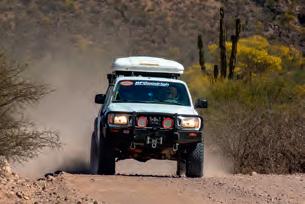
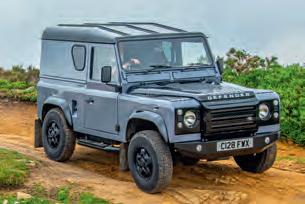


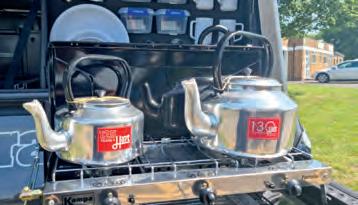

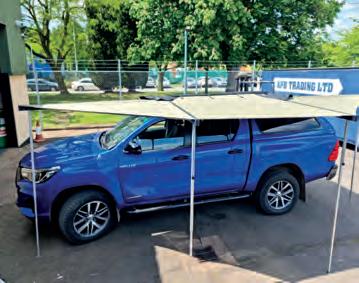
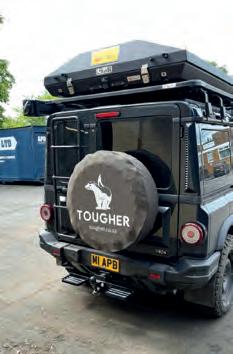
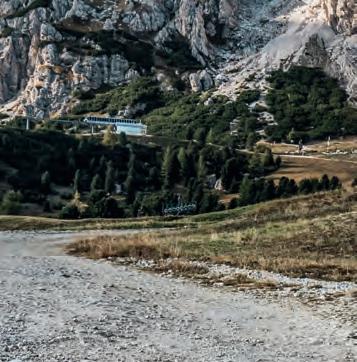





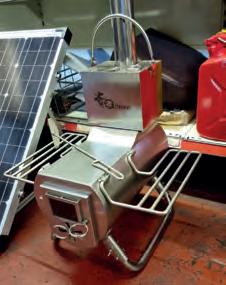
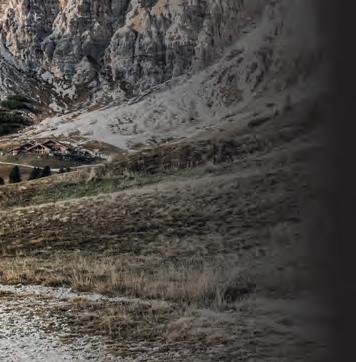
• Escape Gear
• ...and many more!


• Aluminium canopies
• Roof tents and roof racks



• Off-road fridges and 12v gear
• Drawer systems and slides







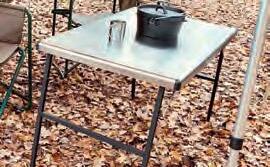


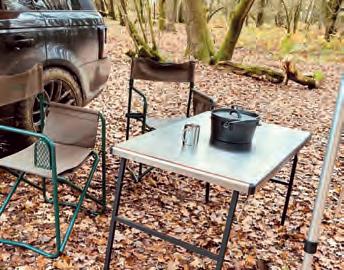

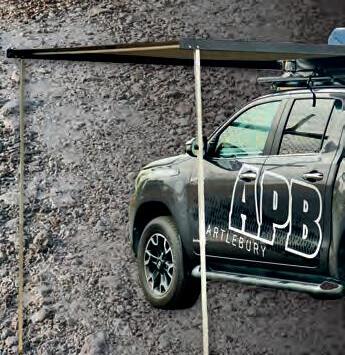


• Bumpers, side steps and vehicle protection
• Campsite essentials, tables and chairs



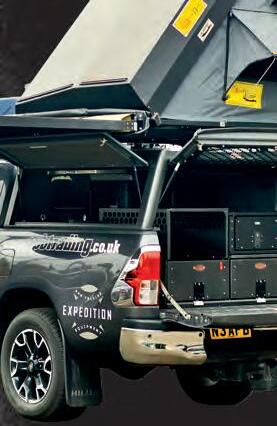












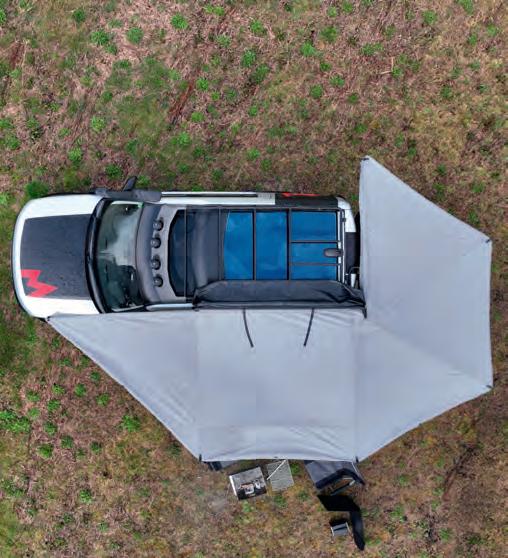
Whether you’re embarking on an off-road expedition or packing up the kids for a summer camping trip in your Land Rover, having the right gear makes all the difference.
Prepare for your next camping adventure with high-quality, purpose-built gear that ensures a smooth and stress-free experience—wherever the road takes you!
We love seeing Terrafirma-equipped vehicles in action! Send us pictures of your off-road adventures, camping set-ups, and expedition builds for a chance to have your vehicle featured in the next Terrafirma Catalogue.
Email:
TF972 Roof Rack 2.2 x 1.0m / Steel Tubular
TF973 Rear Door Access Ladder Discovery 3 / Discovery 4
TF1714 Terradactyl 2/5 LED Awning 2.0m / 270 degrees / 5 Wing
TF1740 Portable Power Station500w Output
TF1741 Power Panel 100w / 2 section solar panel
TF1722 Camping Table 70 x 70cm / Aluminium
TF1720 Camping Chair Heavy Duty / With storage bag
TF1721 Marshal Stool Folds flat for storage
TF1211 Water Bottle 660ml / Stainless Steel
TF1212 Travel Mug 600ml / Stainless Steel
TF1213 Water Bottle CarrierInsulated / With Shoulder Strap
TF1730 Fire Pit Stainless Steel
TF1726 Expedition Shovel 1.3m handle
TF795R Dry bag 80 Litre
TF794B Dry bag 10 Litre
TF902 Expedition Storage Box 160 Litre Capacity

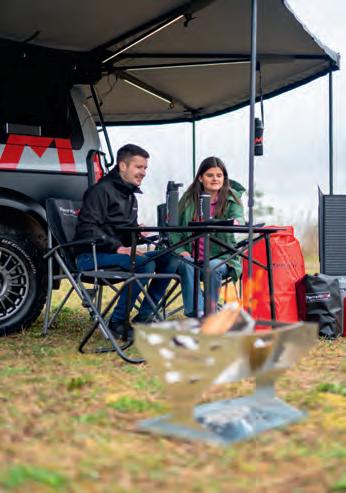
> Awnings & Accessories
> Expedition Essentials
> Much More...


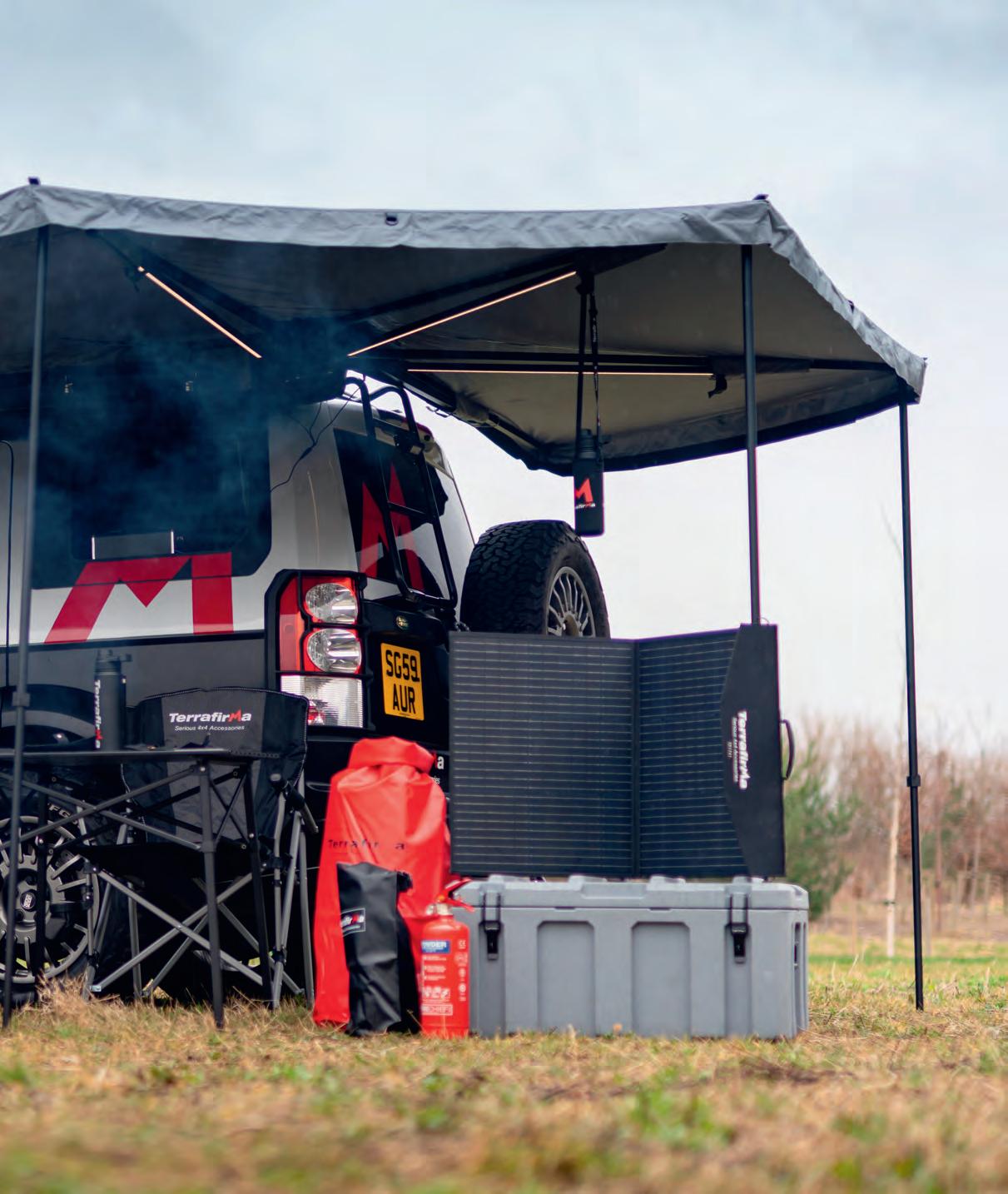

Tel: 01283 742969
Email: enquiries@assignment-media.co.uk
Web: www.totaloffroad.co.uk www.4x4i.com
Online Shop: www.toronline.co.uk
Facebook: www.facebook.com/totaloffroad www.facebook.com/4x4Mag
Editor Alan Kidd
Design Ian Denby-Jones
Contributors
Mike Trott, Gary Martin, Olly Sack, Gary Noskill, Dan Fenn, Paul Looe, Tom Alderney, Chris Collard
Photographers
Steve Taylor, Richard Hair, Vic Peel, Harry Hamm
Advertising Sales
Colin Ashworth
Tel: 01283 742969 isabelle@tandemmedia.co.uk
Advertising Production
Colin Swaffer: 01233 220246
Jonathan Graham: 01233 220247
Jemma Heslop: 01233 555736
Subscriptions Agency
WW Magazines, 151 Station Street, Burton on Trent, DE14 1BG Tel: 01283 742970
Publisher and Head of Marketing
Sarah Moss
Email: sarah.moss@assignment-media.co.uk
To subscribe to 4x4, or renew a subscription, call 01283 742970. Prices for 12 issues: UK £42 (24 issues £76); Europe Airmail/ROW Surface £54; ROW Airmail £78
Distributed by Marketforce; www.marketforce.co.uk
Every effort is made to ensure the contents of 4x4 are accurate, but Assignment Media accepts no responsibility for errors or omissions nor the consequences of actions made as a result of these. When responding to any advert in 4x4, you should make appropriate enquiries before sending money or entering into a contract. The publishers take reasonable care to ensure advertisers’ probity, but will not be liable for loss or damage incurred from responding to adverts
Where a photo credit includes the note ‘CC BY 2.0’ or similar, the image is made available under that Creative Commons licence: details at www.creativecommons.org
Overlander 4x4 is published by Assignment Media Ltd, PO Box 8632, Burton on Trent DE14 9PR © Assignment Media Ltd, 2025


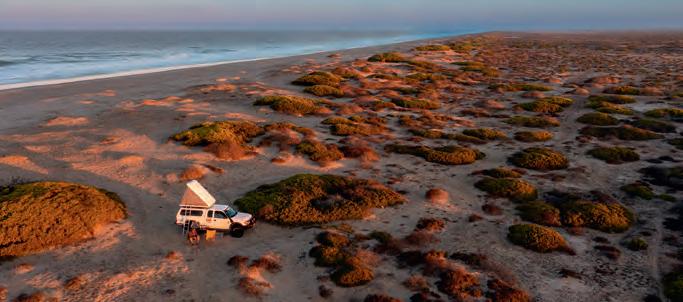

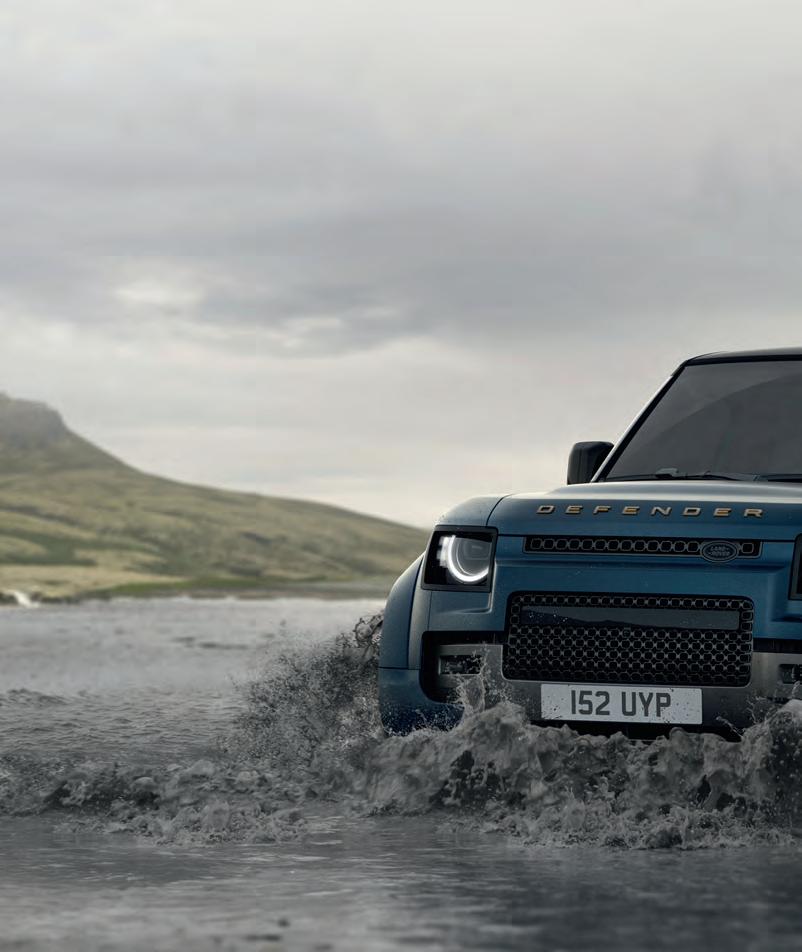

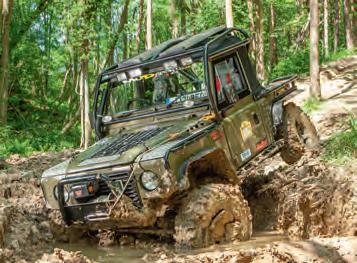




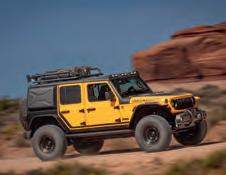














Pay quarterly by direct debit and you can get Britain’s only all-marques 4x4 magazine delivered to your door – for less than half the price on the front cover!
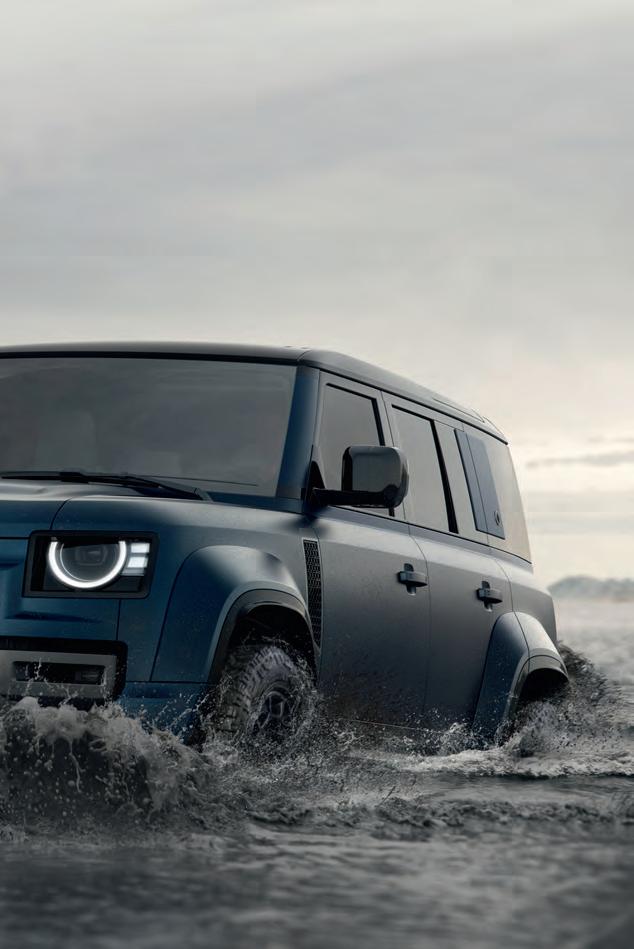
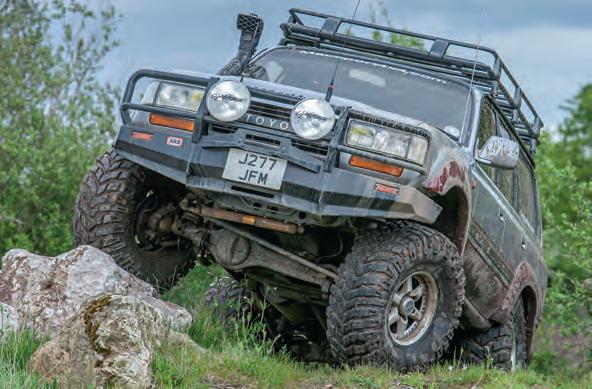
A trio of Land Rovers getting refreshed, with a mild facelift for the Defender and special edition models for the Discovery and Discovery Sport. Facelift fun for the Kia Sportage, too, while the EV9 gets a 502bhp GT model 12 Rights of Way
Big-time lane clearances required after stormy weather brings trees crashing down by the dozen
The latest and best stuff for your vehicle, your workshop and yourself
Get Overlander 4x4 delivered for a fraction of the cover price
Exploring the little known military history of the Scottish Highlands in a brace of Dacia Dusters
24 Nissan X-Trail N-Trek
Is there more to the outdoorsy X-Trail than just a set of wipe-clean seat covers?
Lexus LBX Premium Plus
A new Lexus for Qashqai money – and it’s much, much more than just a poshed-up Toyota
Range Rover Electric
Arctic testing proves its batteries can cope with sub-zero temperatures
A challenge-spec motor that’s hard as nails – but built for comfort, too
Car makers talk about stealing ‘conquest’ sales from other brands. Not many people go from a new Porsche Cayenne to a modified Land Cruiser…
Jeep’s Sunchaser concept takes family adventures to a whole new level
BMW’s M57 diesel engine transforms an old 90 into a very modern kind of classic
Laid Back in the Baja
A supremely chilled kind of overland expedition in Mexico’s frontier territory
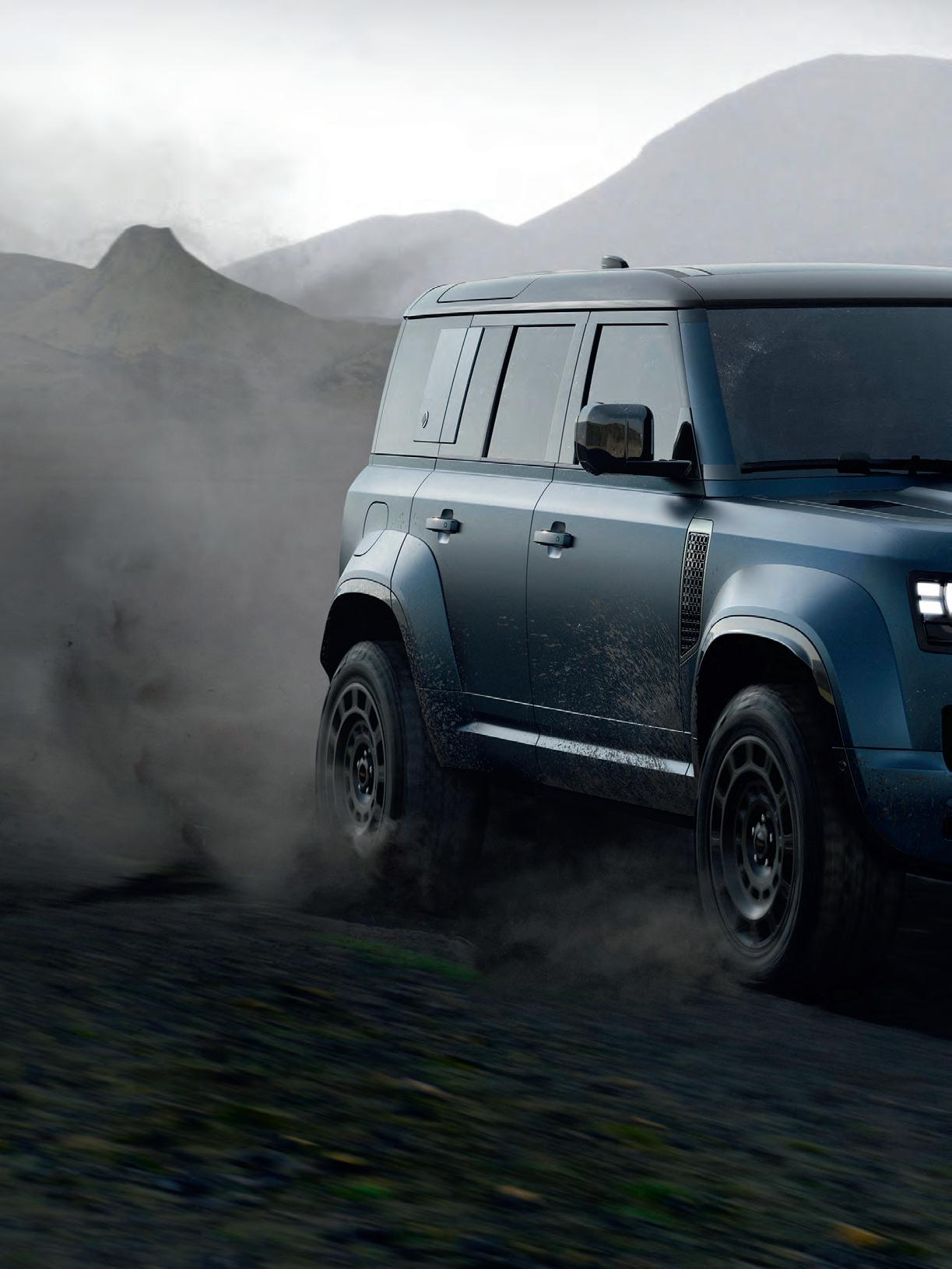
Land Rover has introduced a facelifted version of the new Defender. You might need to look hard to spot them, but there are details updates around the exterior including new front and rear lights – as well as the inevitable wheel designs and paint colours.
Inside, the highlight of the cabin is a new 13.1” infotainment screen – though again, there are various other details waiting to be noticed if you’re sufficiently sharp-eyed. The gear selector has been repositioned higher up on the dash, while down below the floor console now combines a large stowage area with a
hidden section for smaller items. Optional side pockets are also available, as is a cable management system so you can charge multiple devices without feeling like you’re driving a self-propelled bowl of spaghetti. Sorry, truffle-infused artisan maccheroncini; this is the new Defender, after all.
But it also still is a Defender, so you can still opt for the centre seat instead of all that to take it back to the three-abreast style of the original. And talking of the Defender, what’s this? ‘For those venturing off-road, Defender is now available with optional Adaptive Off-Road Cruise Control for the first time. The technology is an
evolution of All Terrain Progress Control and allows the driver to set a desired comfort level when negotiating rough terrain, so they can concentrate on steering the vehicle – improving composure off-road while reducing driver effort. The system automatically adjusts the speed to maintain the desired level of comfort over
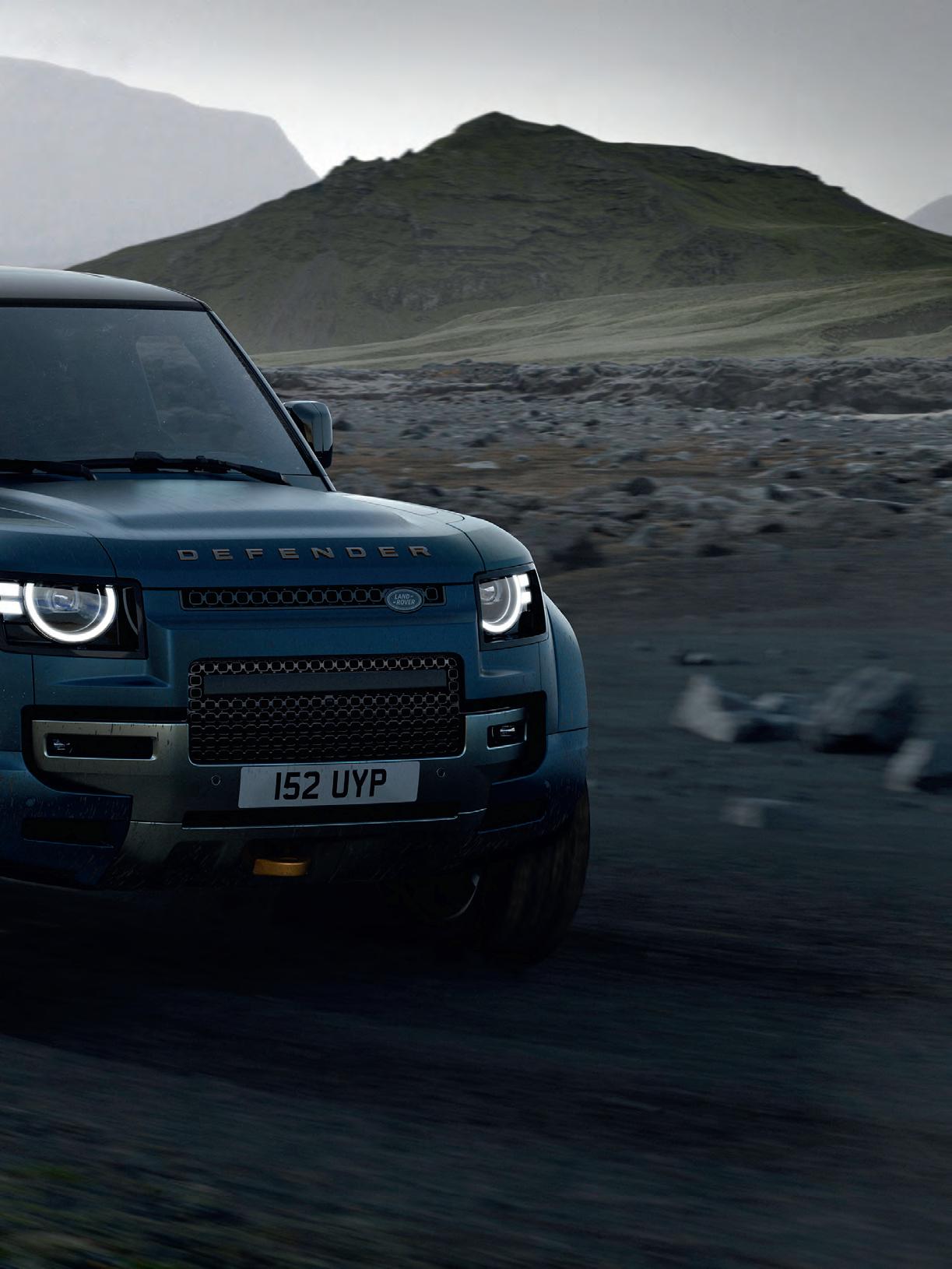
undulating surfaces, for unruffled off-road driving.’ NOW you can see why the old one never caught on.
Going back to those headlights, these provide a new signature shape when illuminated. Between them, a gloss black grille bar becomes standard, while at the back you now get flush-fitting tail lights
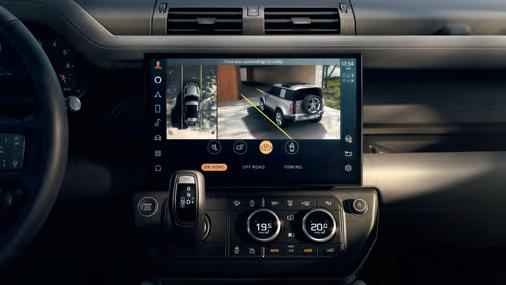
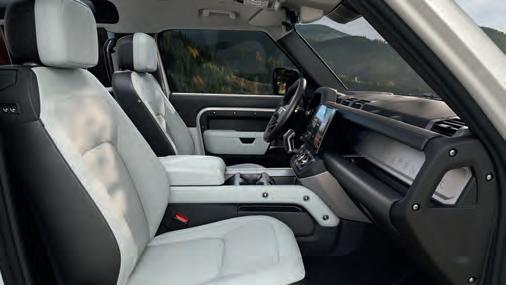
with a dark tinted finish. Further updates to the exterior include new front and rear bumpers with ‘optimised surfaces’ in a choice of silver or grey satin finishes, as well as a new textured pattern for the bonnet inserts and side vents and new gloss black Defender-branded wheel centre caps.
Talking of wheels, you can also now get a new Defender wearing 22” diamondturned seven-spoke alloys with a dark grey finish. And the greyness continues with the new Borasco Grey metallic paint colour, which is named after a silver mine in California. Woolstone Green, on the other hand, takes its name from a
waterfall in the UK (right next to one of the sections of the Ridgeway that were closed to 4x4s by the House of Lords, which seems appropriate as it ‘recognises the British outdoors’.)
There are specific updates for the Defender Octa, too, including a new Textured Graphite exterior finish with Phosphor Bronze on the front and rear bumpers, bonnet vent inserts, wing vent surrounds and bonnet script. Options now include a new Sargasso Blue paint colour and Patagonia White matte wrap, as well as carbon fibre exterior and interior accents, four interior treatments and 20” forged alloy wheels.
If you really can’t get enough of the carbon, you can spec an optional winch with the material on its cover. Further new accessories include fixed and deployable side steps and, on the 130, an integrated air compressor. You can also now get the existing Expedition Roof Rack, cross bars and front undershield in black, and a dark finish is added for the rear scuff plate.
‘More than five years after its introduction, Defender has become an enduring success,’ says Defender boss Mark Cameron. ‘With a bloodline that can be traced back to the first Series I of 1948, Defender continues to capture the imagination of our clients.
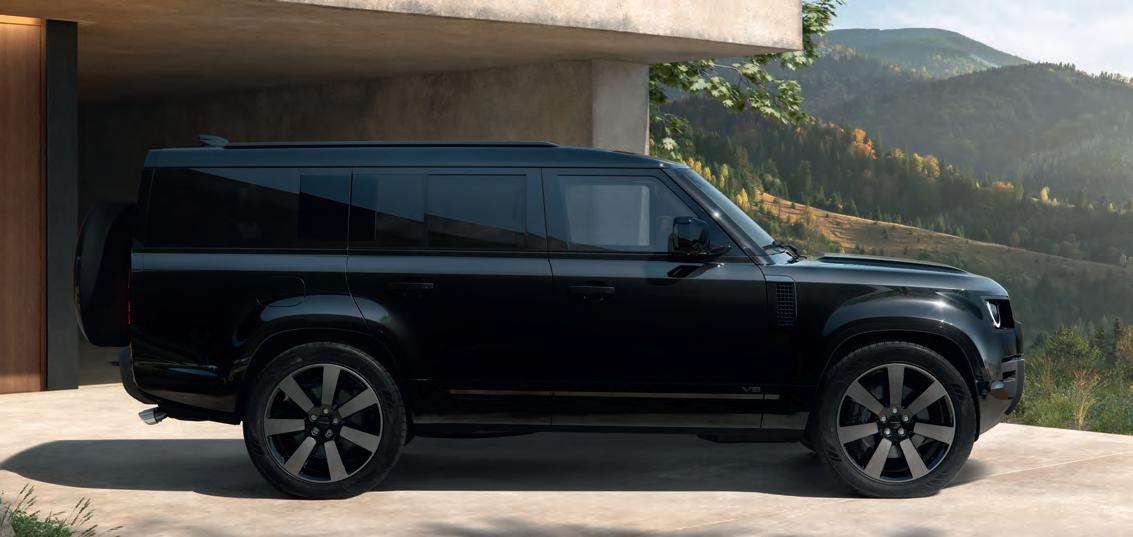
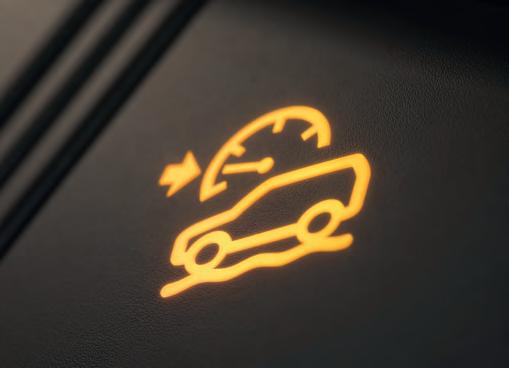
Adaptive Off-Road Cruise Control allows you to set a desired level of comfort which the vehicle will work to maintain. Below, highperformance Octa model gains updates of its own including new exterior and interior treatments as well as 20” forged alloy wheels
‘The range now includes everything from a Hard-Top commercial to the epic Defender Octa. With production at full capacity, the latest changes are part of our continuous commitment to make adventures even more satisfying.
‘Fresh design enhancements, new colours and an expanded range of accessories follow Defender’s comprehensive upgrade last year, ensuring our iconic 4x4 is better than ever.’
It’s hard to believe that the Defender has been around long enough to warrant a facelift, let alone a follow-up one. The old one was still a couple of years away from even getting called the Defender by this point. But it’s already more than half a decade since the first vehicles started arriving in Land Rover’s dealerships – and most mainstream car makers are planning for a complete new model after seven or eight. So what this shows is that even if it’s not going to last as long as the original, the new-generation model is going to be around for a good while yet.
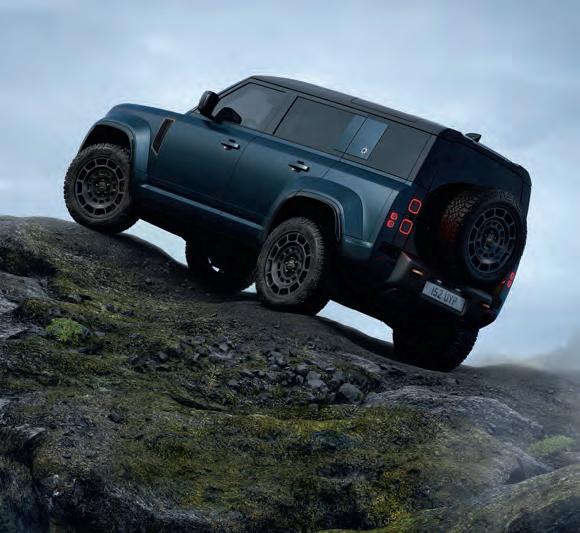

Here at FreelanderSpecialist.com, not only will we fix the problem but we will look to determine why the problem occurred and discuss with you how you can avoid it happening again in the future.
Our di erential units are uprated, making them stronger than the originals.


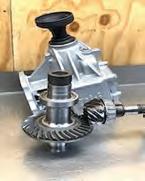
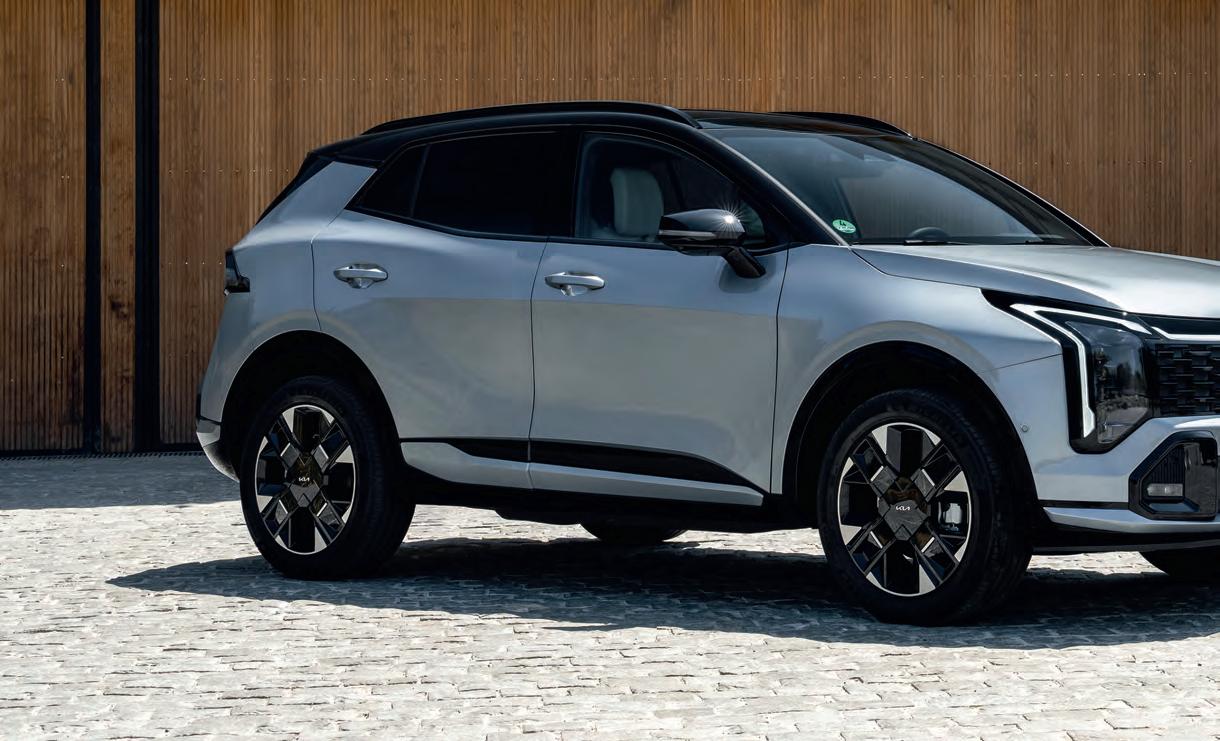
Kia’s monster-selling Sportage has already sold more than seven million units since going on sale.
And the Korean superstar is showing no sign of losing its appeal, with
a newly revealed facelift promising to keep it fresh as the current model enters the second half of its life.
Styled using Kia’s ‘Opposites United’ design language, the new-look Sportage
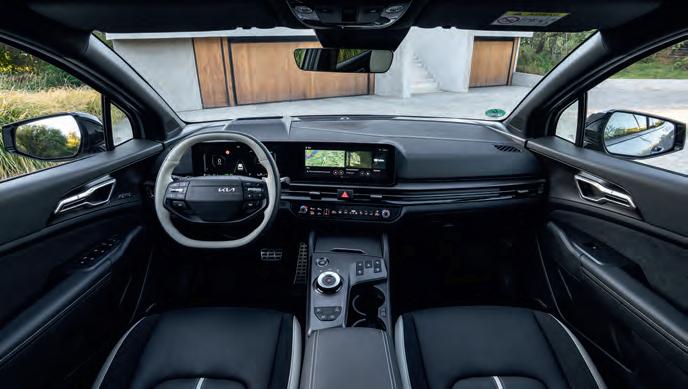
combines both smooth and rugged forms along with ‘star map’ LED lighting and a ‘tiger nose’ grille. It comes with a revised choice of 17”, 18” and 19” alloy wheels including designs exclusive to the GT-Line and GT-Line S models, while inside there’s a new steering wheel and greater use of sustainably produced Dinamica fabrics.
In functional terms, the Sportage catches up with its newer or more recently revised stablemates in the Kia range by offering dual 12.3” curved panoramic displays along with a new 10” head-up display monitor. Further features, which take advantage of the vehicle’s build-in connectivity, include video streaming, in-car parking payment, a wi-fi hotspot, intelligent sat-nav routing and the latest Digital Key technology, which lets you gain access using just your phone – and to share it with family and friends.
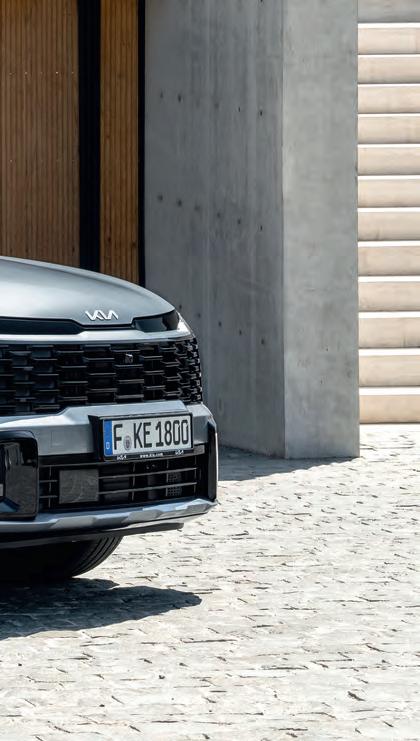
As before, the Sportage is available with a choice of petrol and hybrid powertrains. The former is the familiar 1.6 T-GDI, producing 150bhp and driving the front wheels via a choice of 6-speed manual and 7-speed automatic gearboxes, while at the top of the range, a 239bhp turbocharged hybrid engine will be available in front and all-wheel drive form, promising a new level of driving dynamics.
The new-look Sportage is expected to arrive in Kia showrooms by early in the autumn, with prices announced closer to the time.
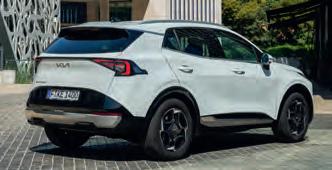

KIA AS ALSO BEEN READYING IMPROVEMENTS TO ITS BRILLIANT
EV9, the big SUV which blends extreme practicality with ultra-modern styling, lavish equipment and searing pace. And the latter is about to get even more searing thanks to the addition of a GT model at the top of the range.
This has two electric motors, between them developing 502bhp and 546lbf.ft –the latter from standstill, of course, which in practical terms means they can hurl the big vehicle from 0-62mph in just 4.6 seconds. Less time than a Lamborghini Countach used to take, which is a fairly odious comparison but still sounds pretty hard to comprehend. Top speed is 136mph, which will come as some relief to any indignant Lambo fanboys reading this.
The GT also gains Electronically Controlled Suspension, Virtual Gear Shift and a dedicated ‘GT’ drive mode, not to mention uprated brakes and exclusive 21” wheels, to help it make the most of its
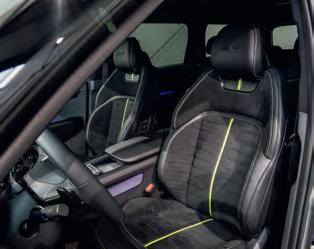
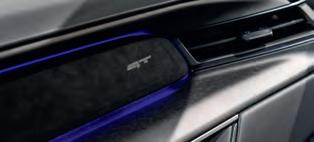
power. All-wheel drive and a heat pump are bot standard – as are ultra-fast charging (10-80% in 24 minutes from a 350kW charger) and a range of 280 miles. One choice you do get to make is between six and seven-seat interiors.
Like the new Sportage, the EV9 GT will arrive in the third quarter of 2025. A difference, however, is that in this case the price has already been announced. It’ll start at £82,185, with the six-seater costing £1000 more and premium paint adding another £725 on top. The order book is open now.
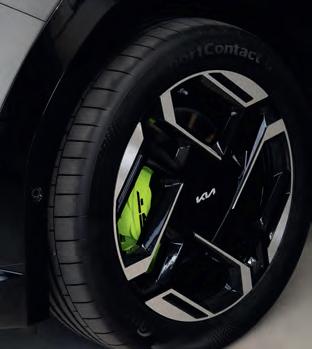

Remember the Discovery? You know, that vehicle that started out as the Range Rover after the Range Rover and ended up as the Defender before the Defender? Well it’s still around – in fact there’s a sixthgeneration model due in the next year or so, which can only mean it’s time for the special editions to start.
Hence the new Tempest and Gemini. These have been introduced at the same time as various specification enhancements and new wheel options across the range. Land Rover’s press release doesn’t actually say what the enhancements are, apart from that there are new 21” and 22” wheel colours and the Dynamic HSE gains three-zone climate control, but apparently they offer more choice and versatility.
Something else the presser doesn’t say is what the new editions
will cost. But we’re canny old dogs and we can use the internet, so it’s £72,505 for the Gemini and £83,720 for the Tempest. Joining at the top of the range, the latter is ‘the most luxurious, comfortable and highly specified Discovery ever produced.’
What makes it so is something else they don’t really explain, but you get aluminium cabin detailing and extended black leather inside, 22” alloys with copper lacquer and a choice of three paint colours, two of them grey. These contrast with a choice of copper or black gloss on the roof, and then the copper is used again on the wing vent, Discovery script and lower bumper inserts.
The Gemini, meanwhile, is ‘a thoroughly modern tribute to the ingenious design of the original 1989 Discovery.’ This doesn’t mean it comes with absolutely no rustproofing anywhere, but our first
thought was that perhaps it was going to have a nice duck egg blue interior to Terence Conran floor mats.
No such luck, although you do get a wortwhile cooled cubby box between the front seats as well as three-zone climate and Click & Go media holders for those in the back. Because the great outdoors is of course no substitute for Mr Beast. On the outside, a choice of six paint colours includes Sedona Red (a first for the Discovery and unique to this edition) with a contrasting black roof. Once again, the roof colour extends downwards, in this case to cover the lower body cladding, front wing vents, grille surround and Discovery bonnet script.
There’s also a Gemini graphic on the B-pillar badges, treadplates and interior finishers, and the vehicle rides on new 21” split-seven-spoke silver alloys. Our view is that it looks better than the
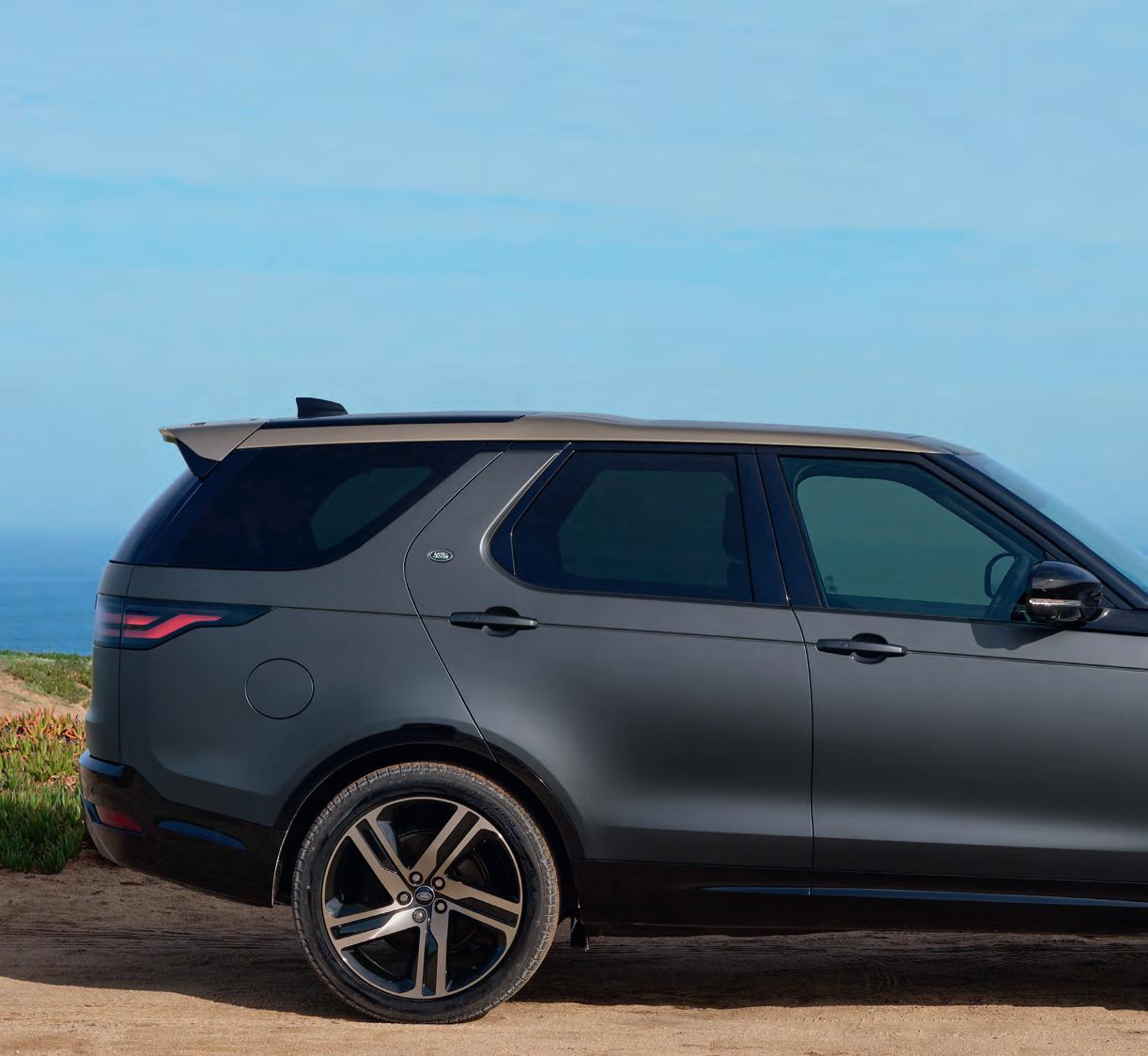
Tempest, but you pays your money and you takes your choice.
Both the new models are powered by the D350 48V mild-hybrid Ingenium diesel, mated as standard to an eight-speed auto box driving all four wheels. You don’t get low range as standard, though – it’s part of the £1610 Advanced Off-Road Pack, which also includes Terrain Response 2 and a locking rear diff. Coincidentally, a towbar (electrically deployable, of course) costs almost the same; the Disco will, as always, haul 3500kg in superb style.
Since we’re on the subject of options, Land Rover has also introduced a number of accessory packs. Sorry, ‘curated accessory packs.’ It’s like a warthog looking in a mirror and seeing a swan, honestly. These are called Beach Days, Road Trip and Snow Days, all of which sound like Traffic Jam Days in real life but let’s go with it.
Beach Days includes a collapsible boot organiser for thins like buckets, spades and beach balls, plus bespoke sun shades for all the widows behind the B-posts, tailgate included. You also get a roof rack for those canoes, surfboards and bodyboards we all take to Skeggy, plus rubber mats to
protect the carpets and deep-sided interior sand guards.

The Road Trip pack includes two seat organisers, a centre armrest cooler and an electric cool bag to prevent your picnic from turning into warm stodge. Up top, you also get cross bars and a roof box for still more luggage capacity (the Disco is already no slouch in this area) and the whole package is finished off with wind deflectors for those blissful occasions when fresh air beats climate control.
Finally, Snow Days is all about winter sports (and, therefore, going on a long trip). Cross bars are included once again, this time for your skis and snowboards, then there’s a rubber loadspace mat, mudflaps and a ‘snow traction system’ which we assume means a set of chains or something similar.
Land Rover says these have been introduced in response to the popularity of its existing For Dogs and Biking Adventures packs. However much it has been turned into a premium luxury car, the Discovery is still an incredibly practical vehicle with the potential to be specced with a huge amount of capability – and even if Land Rover makes us grind our teeth when it described them as being ‘curated’, packages like these really do make the most of what’s best about it.
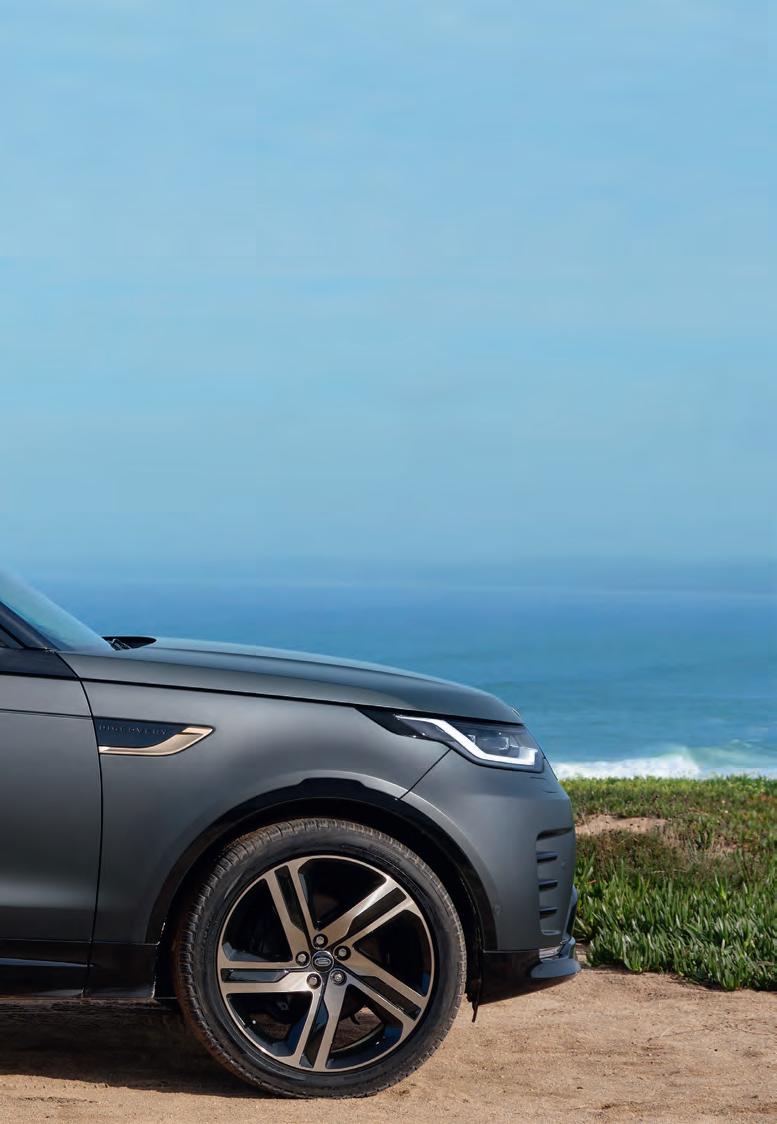
NOT TO BE OUTDONE BY THE FULLSIZE DISCOVERY , its little brother the Discovery Sport has also gained a pair of new special-edition models. Called Metropolitan and Landmark, these play on the luxury and versatility themes to make the most of the vehicle’s multi-faceted character.
They come as part of a revised model line-up in which the only other choice is the Dynamic S. The range of engine options continues as before, with D165 and D200 48V mild-hybrid diesels plus a petrol plug-in hybrid.
The Metropolitan is the new flagship in the Disco sport range, with silver finishes to the grille, undershields and bonnet badging as well as Metropolitan branded treadplates and new 20” alloys with a choice of colour finishes. Inside, you get leather seats with 14-way electric adjustment, heating and cooling, plus a premium stereo, cabin air purification system and camera-based rear view mirror.
If that sounds like not a lot for something that’s supposed to be an ‘edition’, the spec list on the Landmark is positively zen-like. You get slide and recline rear seats, a panoramic roof, Click & Go media holders in the second row, roof rails and a 3D Surround Camera, while the treadplates and puddle lamps feature a version of the mountain range graphic that was used on the original Discovery back in 1989.
Finally, the Dynamic S has a load of black styling to give it ‘a dynamic and purposeful look.’ This would appear to be the entry-level model in the new range, as Land Rover says ‘every Discovery Sport –including Dynamic S – features a digital instrument cluster and steering wheelmounted gearshift paddles as standard, while the centre console has an elegant floating 11.4” curved glass touchscreen.’ Prices start at £45,440 OTR; the Landmark moves that up to £49,100 while the Metropolitan tops the list at £55,885, or £59,305 in plug-in form.


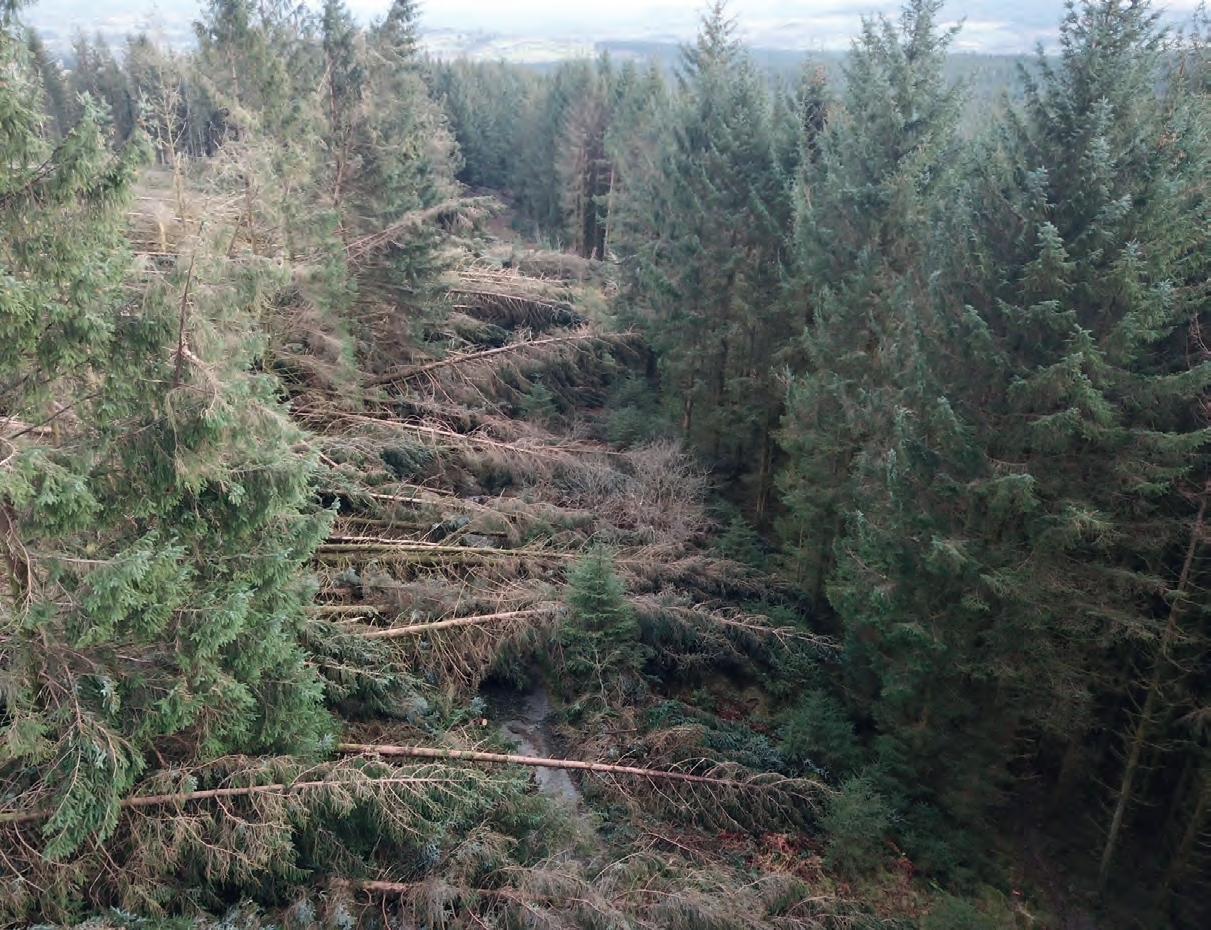
THIS EXTRAORDINARY PICTURE IS OF A GREEN LANE. You can barely see it under all the trees, but this is the Roman road through Crychan Forest in Wales following Storm Darragh – which battered the west of the country with winds of up to 95mph.
The result for the green lane network in Wales was that many rights of way were blocked by fallen trees. In a working forest like Crychan, the consequences were always going to be particularly spectacular – and whereas the majority of lanes were cleared by individuals or small groups of laners on days out, here it was necessary for heavy equipment to get involved.
Taken in February, the picture shows something in the region of 16 trees down across the right of way. With a harvester required to shift them all, the Green Lane Association (GLASS) contacted Natural Resources Wales (NRW), which promised that the work would be completed by the end of April – an undertaking on which they did indeed come good.
The Association’s Carmarthenshire Rep Andrew Hadley said that unlike in some parts of the country when things go wrong, the local authorities were on the case quickly. ‘The council and NRW are doing as much as they can with their limited resources to get the network fully open
again. Please continue to report any issues you find through the council website.’
While this was a natural phenomenon rather than anything sinister, the incident illustrates the importance of having an organisation like GLASS to look after green lane users’ interests. There are many local authorities that would have seen this as a heaven-sent opportunity to close the lanes for as long as they could get away with; Carmarthenshire is not like that, and nor is Natural Resources Wales, but it’s very hard not to feel that individual green laners, however many of them, would have struggled to get the damage cleared so quickly and effectively.
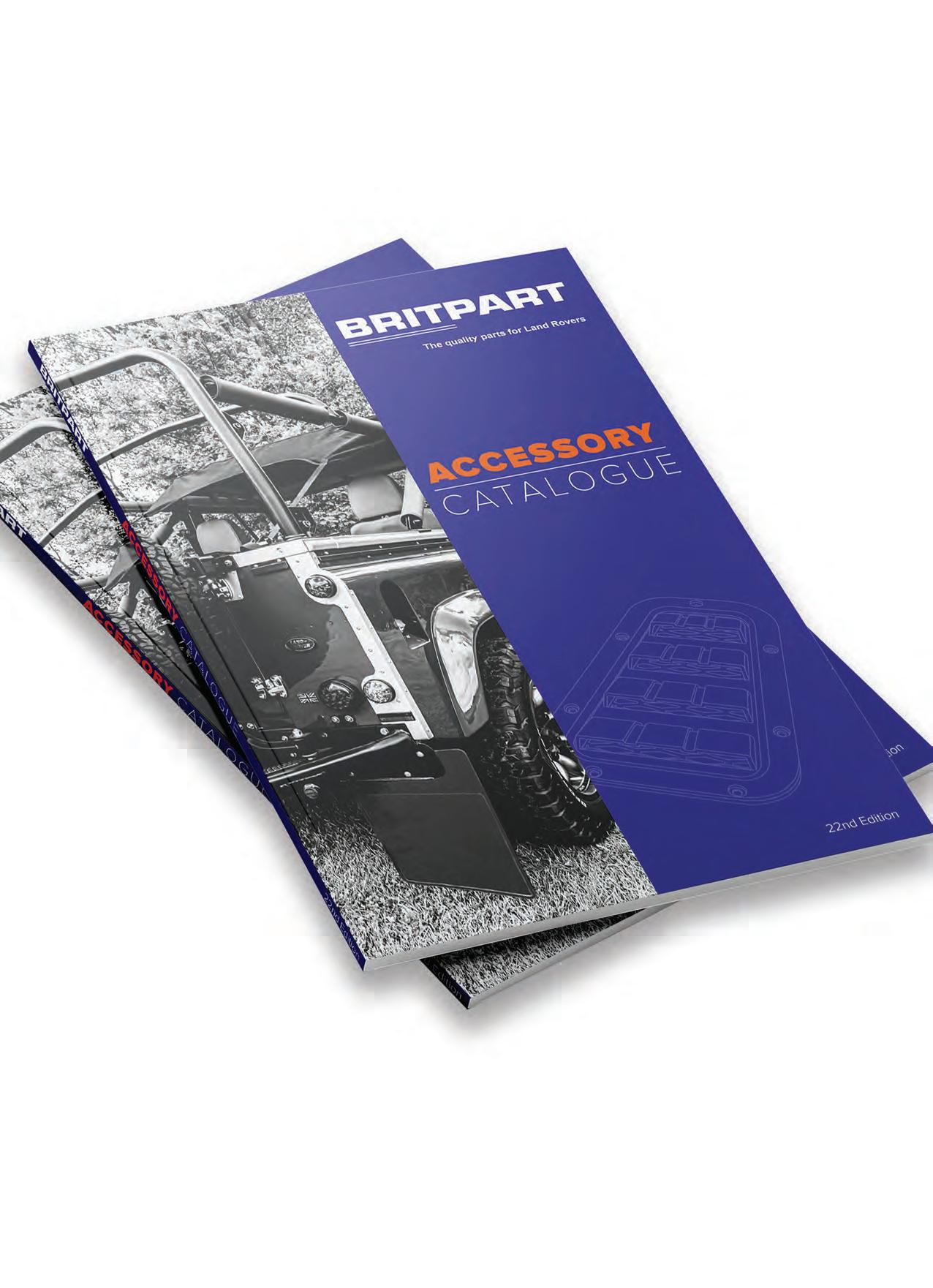

Cynghordy Llandovery Carmarthenshire, SA20 0NB Tel: 01550 750274 e-mail: info@cambrianway.com

Family run guest house and self catering cottages with spectacular views, en-suite bedrooms, comfortable lounge bar and excellent home cooked food. Pressure washer, drying room, map room with local lanes marked, on-site 4x4 course, guides and GPS hire available. A very popular venue for both individuals and groups of 4x4 enthusiasts

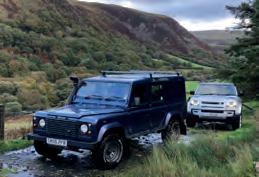
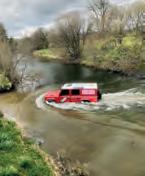







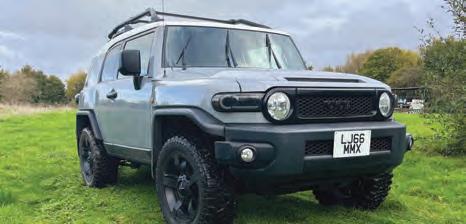
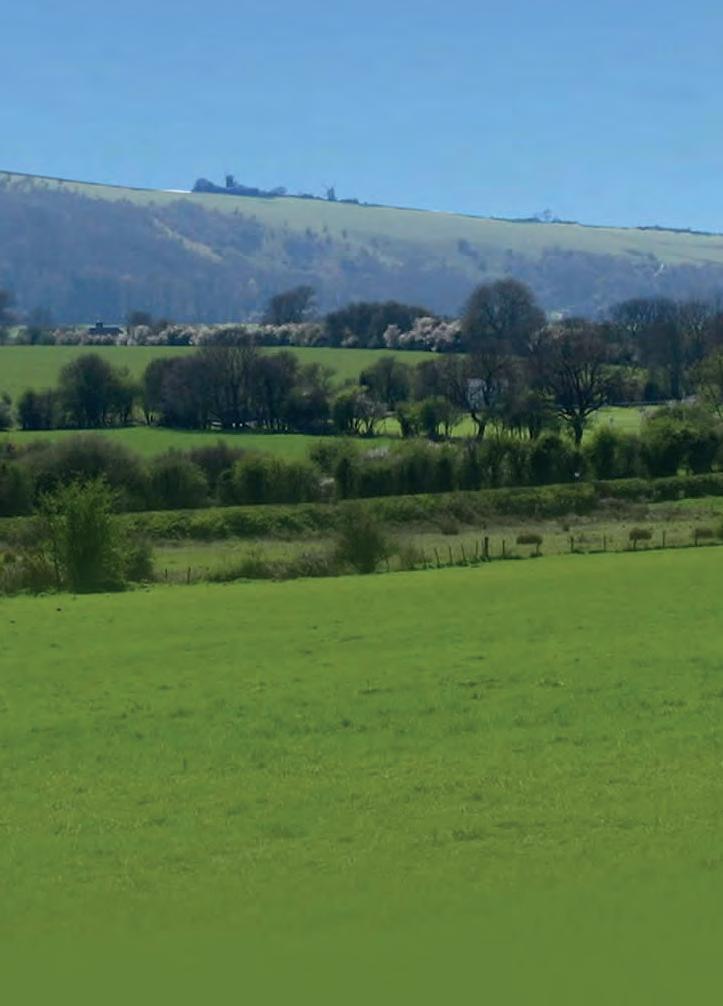

HARTSIDE IS AN UNSURFACED ROAD
IN CUMBRIA, around halfway between Alston and Penrith, which has seen more than its fair share of issues in the past. It starts and ends at junctions with the A686, effectively cutting a corner which the main road skirts around – and, like the road itself, it’s celebrated for its views of the surrounding landscape.
The terrain the lane traverses is not particularly steep, but it’s a steady gradient and the ground to either side can be very boggy. It has for several years been subject to voluntary restraints making it one-way (downhill, from east to west) but the local team from the Green Lane Association, led by recently retired Cumbria rep Peter Apps, have been no strangers to the area as they provide maintenance and stitch-in-time repairs in a bid to keep it from deteriorating.
Sadly, another ongoing job in the area is to counter the damage done by vandals. As always, catching people who go off-piste in remote areas is a near impossible job (or at least one not deemed wor thy of the investment and effort it would take), so it’s left to volunteers to try and clean up as best they can and discourage further excursions from the legal route.
The most recent work done adjacent to the lane involved installing heavy-duty posts on the high points between the deep ruts created by previous assaults on the terrain. How much of a deterrent this will be, only time will tell.
Peter comments that his team also installed some marker posts alongside
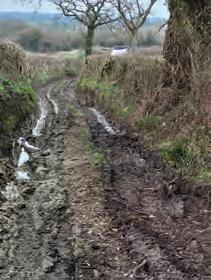
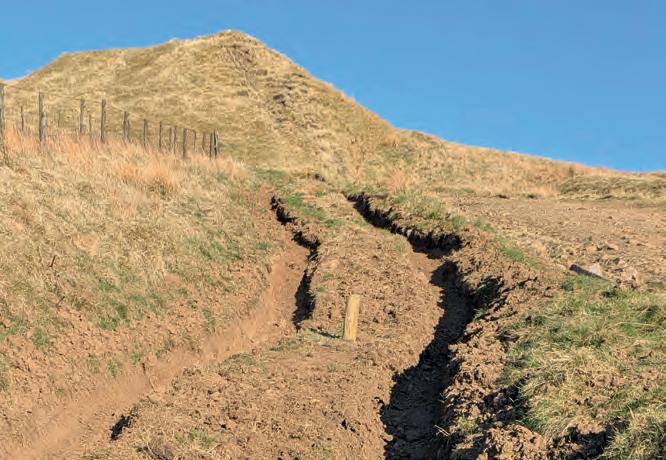
the repairs they had previously worked on last autumn in conjunction with the TRF last September. ‘More work is required,’ he says. ‘But funding and permissions are making that difficult.’
• On a rather more positive note, the Cumbria team recently hosted an Introduction to Green Lane Driving event on the Westmorland area. ‘It went off really well and was enjoyed by all,’ comments Peter. ‘Two groups of four vehicles met at M6 J38 Truckstop. Most of the people joining were in very tidy vehicles and many were new to driving lanes.
‘The routes chosen were suitable for smart vehicles but still rather amazing to drive. The landscape is so different to either the Lakes or Dales. Thanks to all those who joined us.’
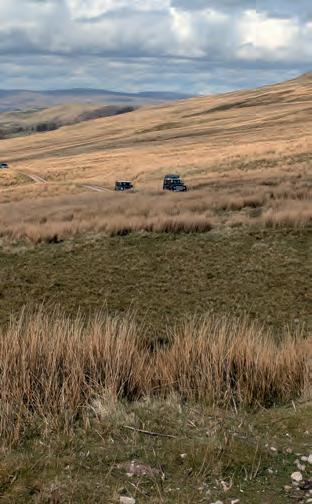
and ending up regretting it are not new, but this is a good one. Charlie Moore, Somerset rep for the Green Lane Association, was recently alerted to an articulated lorry stuck on Studley Lane, an unsurfaced road near Wanstrow.
‘I went to have a look to see how much damage had been done to the lane,’ says Charlie. ‘While there, I spoke to the driver. He told me he was following the route his truck sat-nav had sent him on to avoid the nearby low bridge.
‘Despite passing a sign put up by local residents at the northern end of this lane saying “do not follow sat-nav”, he continued until he got stuck trying to reverse out. It amazes me how drivers, even professionals, fail to think this can’t be right and blindly follow the instructions on their satnavs. Whatever happened to common sense?’

£19.98-£59.99 | www.ringautomotive.com

Latest addition to the range of handy stuff from Ring is the Ultrainflate line of tyre inflators. This includes three models to suit all levels of demand and pricing, all of which promise intuitive operation and have large display screens, LED lights and valve cap storage:
Ultrainflate 10
The entry-level tyre inflator in the range, this is intended for simple and efficient use with a large analogue display, ergonomic design and easily located power and light buttons. It has a 3m wind up cable and built-in 12V plug storage, plus an integrated LED light to aid visibility and a 60cm long hose allowing use on large wheels.
Ultrainflate 20
The mid-range model in the range, this builds on the capabilities of the Ultrainflate
10 by adding a programmable auto-stop function and a large digital display containing a progress bar to let users to track the inflation process.
Ultrainflate 30
The premium model in the range, this is designed for speed and ease of use and can inflate a 13” tyre from flat to 30psi in just two minutes. Not that you’ve got any of those dinky little things on your vehicle, but it’s a good guide to what the unit can do. Its cable and hose are longer, at 3.5 metres and 70cm respectively, and the latter has a large brass connector for a secure fit. You get the same auto stop technology as the Ultrainflate 20 (Ring calls it ‘Ringtelligence’), as well as the largest digital display screen in the range. This also features the same ‘Dynamic display’ progress bar, however instead of plus and
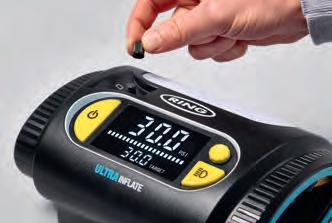
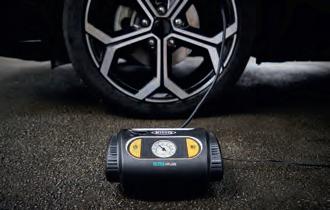
minus buttons for setting the target pressure it has an ‘Easyset’ dial, making it even more convenient to use.
‘We’ve done a lot of research on this new range to ensure it includes everything a driver would want from a tyre inflator,’ says Ring’s Marketing Director Henry Bisson. ‘It’s easy to use, simple to understand, doesn’t take too much time to inflate and it’s stress free to put back into a storage bag or the box it came in.
‘Tyres are the only point of contact a vehicle has with the road and should be looked after a lot more than they are. We have found during our research that people are not checking their tyres enough.
‘With this new Ultrainflate range, and how quick and easy it makes checking and inflating tyres, we’re sure motorists will be able to better look after their tyres.’
Stowage drawer adds practicality to Landies and Toyotas alike
£1198.62 inc VAT | www.expedition-equipment.com
PEOPLE HAVE LONG BEEN MAKING THE MOST OF THE ABILITIES built in to the Land Rover Discovery 3 and 4 – not just as workhorses but even as overland motors. Whatever you want to do with one, Big Country’s Mono Drawer Unit ought to
help add a level of practicality – and can be pressed into service on the L322 Range Rover, too, as well as various Toyota 4x4s.
Made in South Africa using all-steel construction, this features a single, full-width drawer which comes lined with heavy-
wearing industrial carpeting. It’s secured to existing lashing points, which makes it easily removable when you want it to be, and has heavy-duty double runners.
The drawer is fully lockable, which is reassuring to know as it’s long enough
£475.00 plus VAT (pair) | www.rimmerbros.com
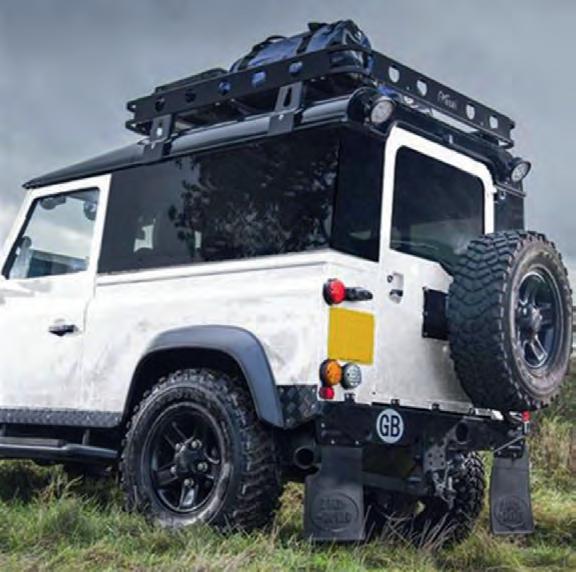
IF YOU’VE EVER THOUGHT about fitting your Defender 90 with Masai windows but never been able to get the money together, now might be the time. That’s because Rimmer Bros currently have them on a clearance offer – albeit only for the 90, and end panel windows need to be purchased separately if you want those too.
The windows are made from 4mm toughened safety glass with a 70% privacy tint and promise to reduce heat and glare – as well as increasing torsional rigidity and providing greater security than factory-fit standard sliding windows. They’re leak-proof and draftproof, too, which is definitely a novelty on an old 90, and a DIY-er should be able to fit them in a few hours – naturally, the kit comes with a fitting template and full instructions.
The windows include an aluminium inner frame for aesthetics and fit into a 1057mm x 427mm aperture – the standard size for Defender rear side windows. The price is for a pair, and kits are available for all pre-Puma 90s from 1983-on as well as for TDCi models up to the end of production.
to accommodate a full-length shotgun case, and down below it features an access point for getting at the vehicle’s spare wheel. You get side filler panels included in the kit, too.
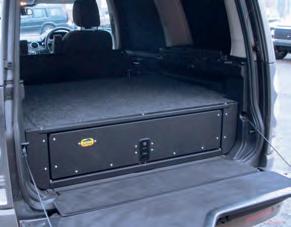




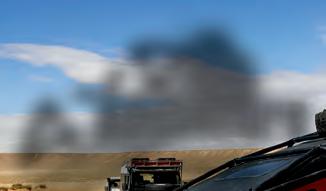

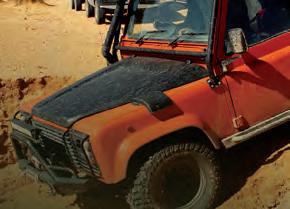



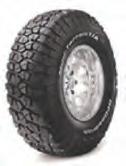







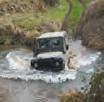
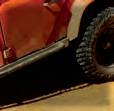
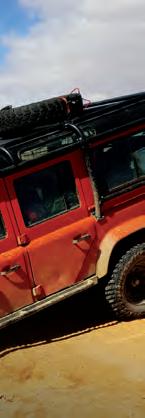

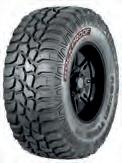







Words: Gary Martin Pictures: Land Rover

















Land Rover heads into the Arctic circle to subject the forthcoming Range Rover Electric to extreme cold-weather testing




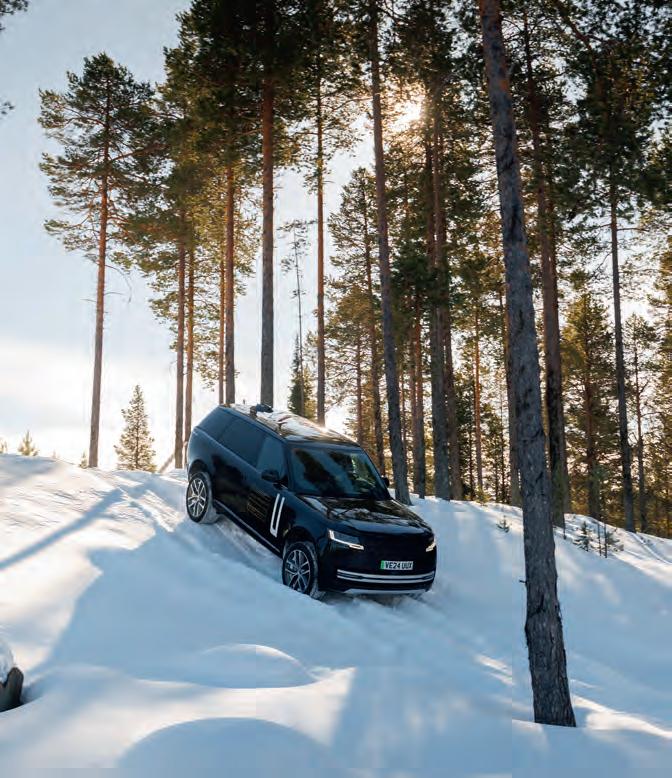

Back in our February issue, we brought you the story of how the Range Rover Electric was coping with hot climate testing in the extreme environment of the Dubai Desert. Not only did it have to perform the way a Range Rover should in terms of off-road ability – it also had to do so by maintaining the optimum cabin climate














even while its motors and batteries were being taxed to the hilt by the powersapping sand and roasting temperatures. Now we’re at the other end of the scale. If you’ve driven many electric vehicles, you might have noticed how switching on the heater can make your range drop pretty alarmingly (and if you’ve not, you’ll certainly have seen the trumpeting

nonsense shouted non-stop by hateeverythings on social media who’d have you believe that they can barely make it to the end of the road in cold weather).
Swivel-eyed ranting is of little help to anyone, but the science does say that when it gets cold, more effort is needed. The consequences are more dramatic in some vehicles than others – and





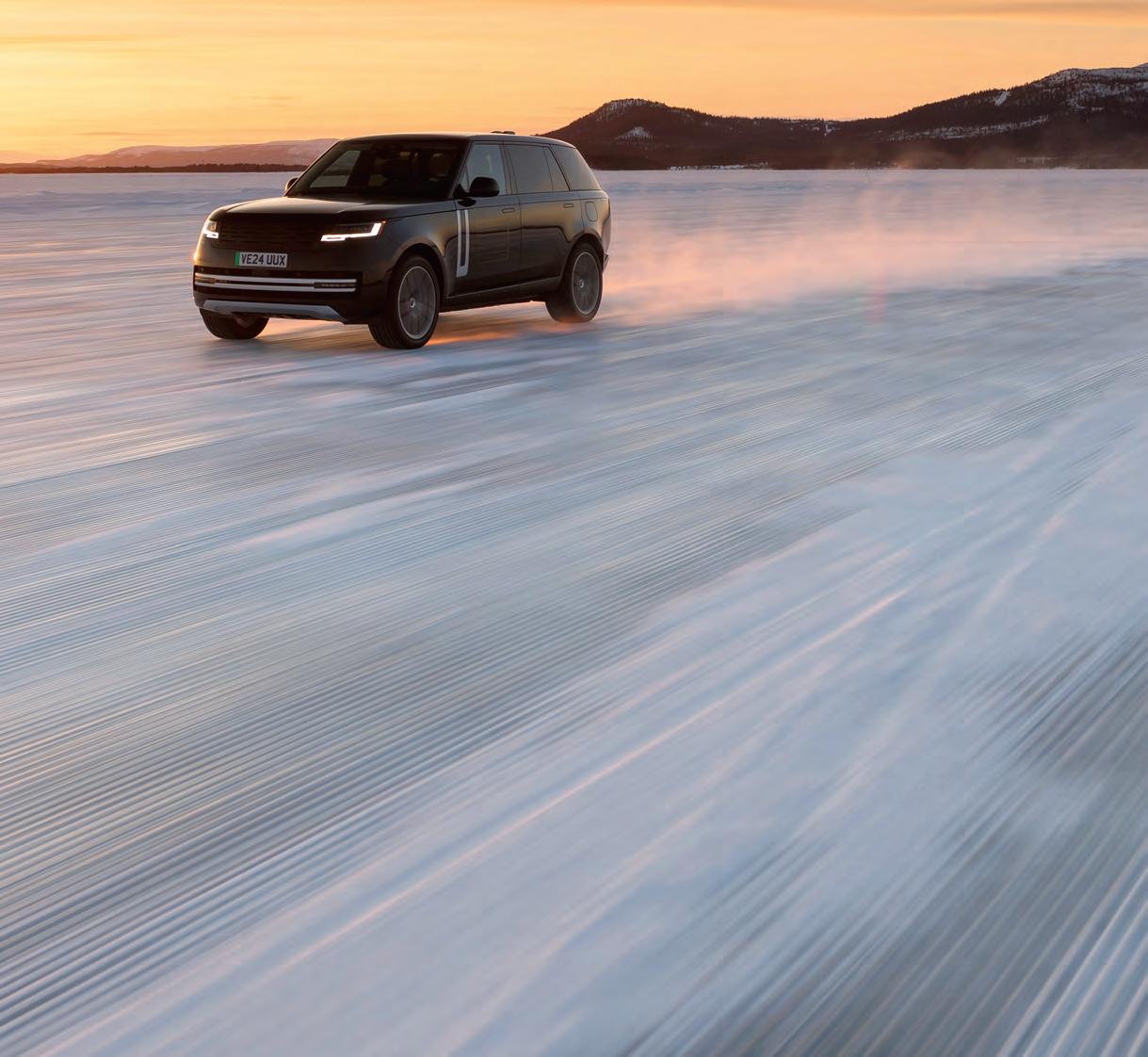
of course the Range Rover very much promises to be one of the ones that can take it all in its stride.
Helping demonstrate this are the results gleaned from a season spent testing in the extreme winter conditions of northern Europe. Land Rover took the vehicle to Arjeplog, in Swedish Lappland, where many a car before it has been sent to



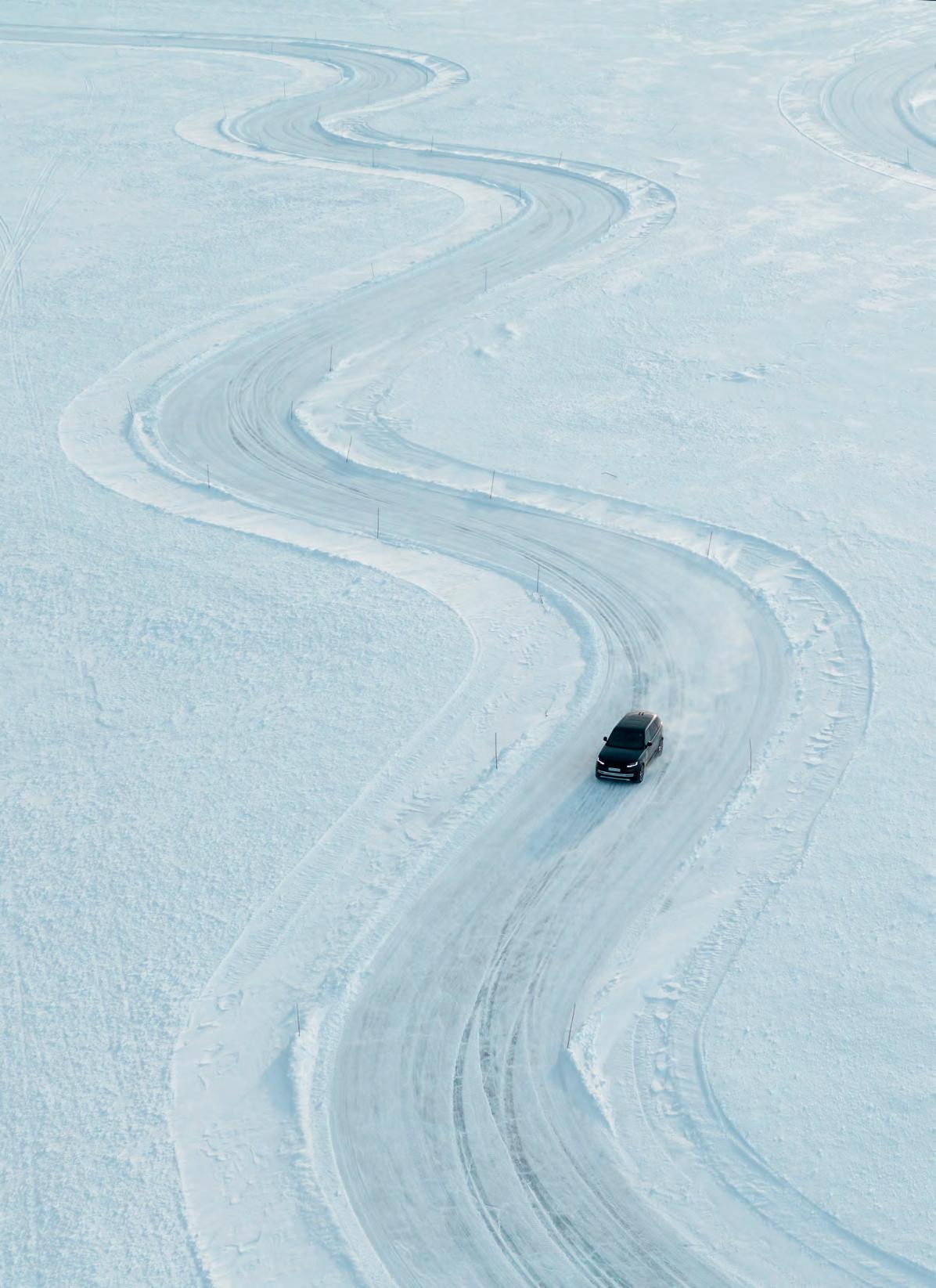
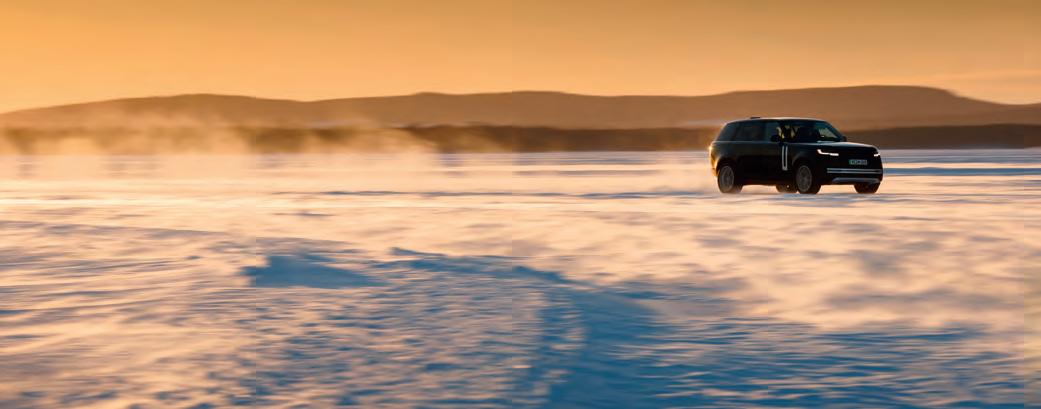
earn its spurs over the years, to push it to the limit over 45,000 miles on tracks and frozen lakes.
The Range Rover’s off-road ability comes in no small part from the use of switchable, twin-chamber air suspension. This has been tuned specifically for the Range Rover Electric, whose overall weight and in particular the way it’s distributed is very different to that of vehicles powered by conventional engines.
The vehicle also promises to take singlepedal driving to a new level. It’s normal for EVs to have this feature, which cranks up the effect of regenerative braking to the point where it can bring the vehicle to a complete halt. It takes a bit of learning, of course, but once used to it a driver can typically go all day without having to touch the brake pedal at all.
In the Range Rover’s case, this function has been tuned to work with the latest version of Terrain Response. It will bring the vehicle to a complete stop and engage Hill Hold, enabling the driver to move off again without ever having touched the brakes at any point – and it will do it on extreme terrain, with engineers having used it successfully on 28-degree simple inclines as well as 17-degree hills with a split-mu surface (that is, one with significantly varied friction between the left and right wheels). Land Rover promises that the vehicle will be ‘effortless, with a sense of power in reserve’ and that it will ‘retain authentic Range Rover composure in all conditions.’
This part of the vehicle’s development has also seen engineers validating the Range Rover’s new ThermAssist technology. This is a thermal management
system designed to reduce heating energy consumption by up to 40% by recovering heat to warm the propulsion system or cabin in ambient temperatures as low as -10°C. This in turn helps preserve the vehicle’s charging ability and get as much range as possible out of its 800V, 117kWh battery, while also maintaining a comfortable cabin temperature even when it’s well below freezing outside.
‘In its driving character, Range Rover should seamlessly combine capability and
refinement,’ said JLR’s Vehicle Engineering Director Matt Becker. ‘Delivering both in an electric vehicle in a way that doesn’t diminish the vehicle in other areas is incredibly challenging.
‘By increasing its torsional stiffness and improving its responses, we’ve been able to maintain a customary Range Rover driving experience that feels familiar. We have delivered on this promise by marrying all the essential Range Rover elements with new and advanced technologies.’

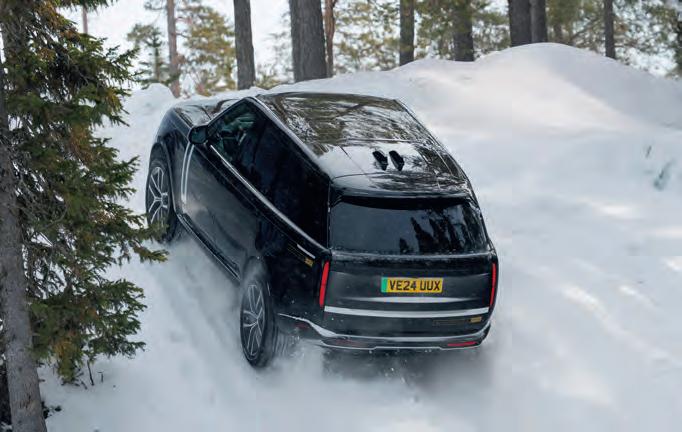















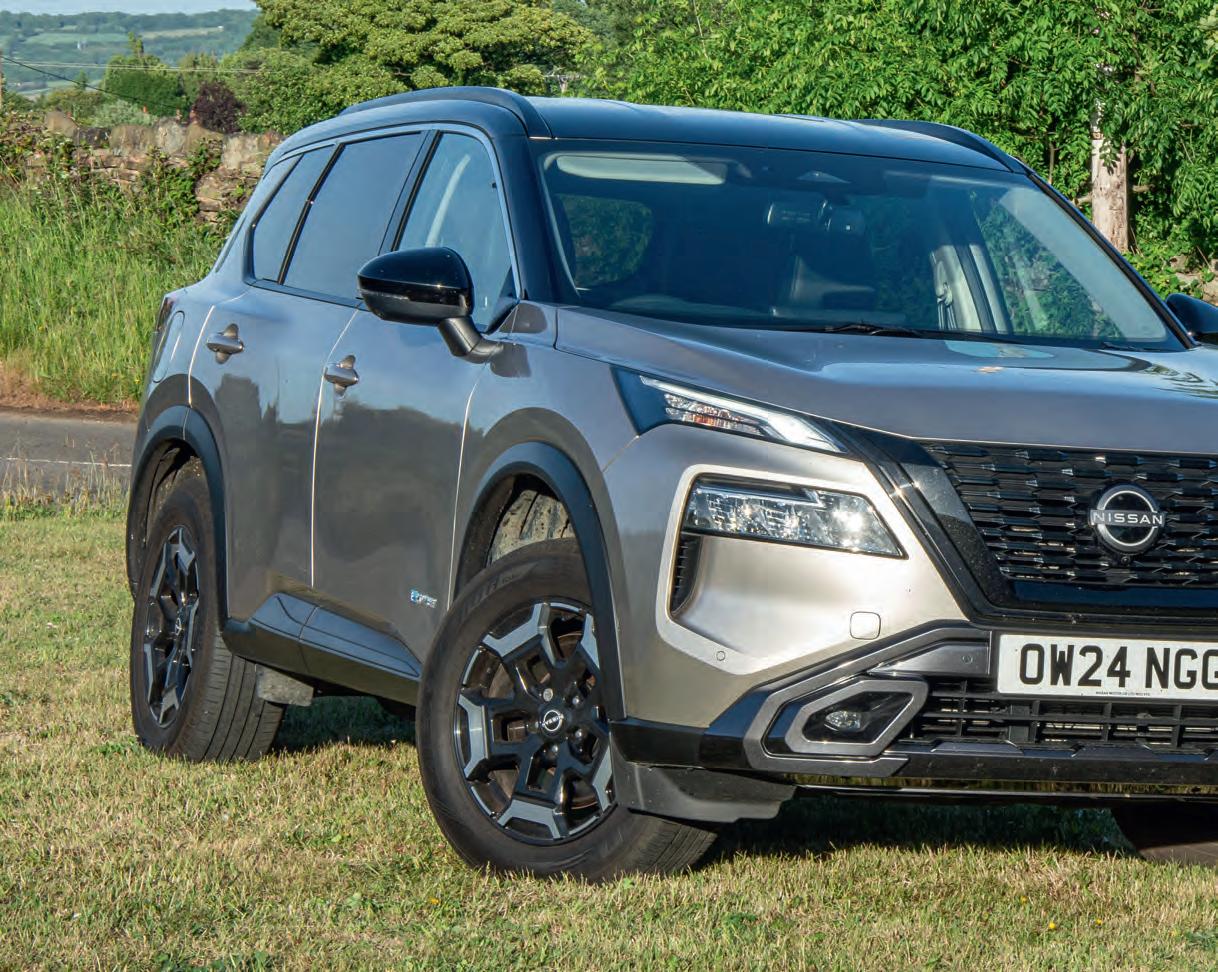
Aformer winner of our 4x4 of the Year title, the X-Trail is a superb all-rounder whose blend of practicality, class, driving abilities and, in all-wheel drive form, off-road skills make it an outstanding family vehicle. It wanted for very little when it was first launched – but Nissan clearly did think there was something more it could do, because last year they added a further model to the range in the shape of the N-Trek.
This falls between Tekna and Tekna+ in terms of price, putting it second from the top in a five-strong model line-up. It has a
specialised purpose, however, to set it apart from the rest of the range – it’s designed to appeal to ‘daring and adventurous families with a love of the great outdoors.’
To help it do this, the N-Trek gets a variety of adventure-focused equipment. On the outside, there are protective lower bumper trims with a gunmetal finish and integrated LED fog lamps, which flow into the wheelarch extensions that were already in place from the rest of the X-Trail range. Beneath the latter, 235/50R18 Falken rubber is mounted on diamond-cut gloss black alloys that are unique to this model.
Gloss black is also used on the wing mirrors and, up top, the roof rails. Nissan quotes a dynamic load limit of 100kg across these, so the potential is certainly there to carry a tent if you really do want to have some proper adventures in it. On that subject, the N-Trek is available with two drivetrain options – the 204bhp e-Power and the 213bhp e-4ORCE, the latter bringing all-wheel drive to the party.
Rather oddly, the 4x4 model is available with a choice of five or seven seats, whereas two-wheel drive limits you to just the former. There’s only a £2200 difference between


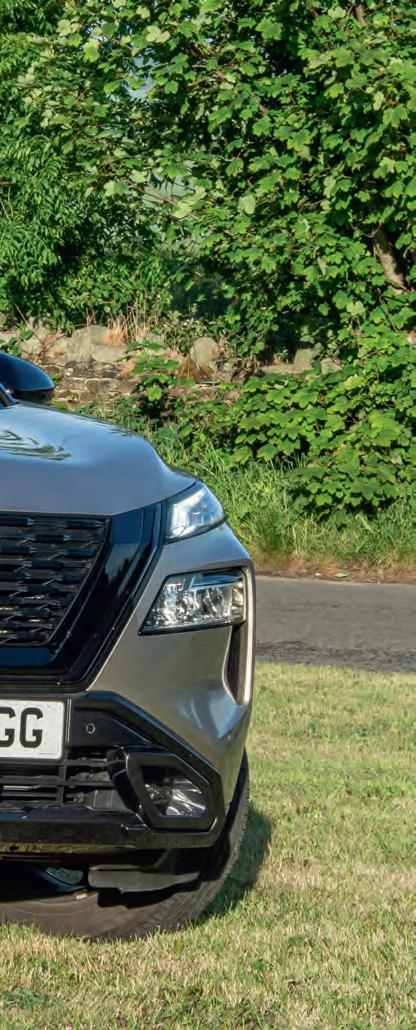
the two drivetrains, and we know from experience that the 4x4 version is capable of really remarkable things off-road, so why you’d pay £43,780 when £45,980 gets you the proper job (make that £46,980 for the seven-seater) is lost on us.
Sticking with the seats, this is where the N-Trek plays what is perhaps its strongest hand. They’re clad in water-resistant, wipeclean upholstery which doesn’t quite look like leather, or fabric, or vinyl but manages to combine the best qualities of all three.
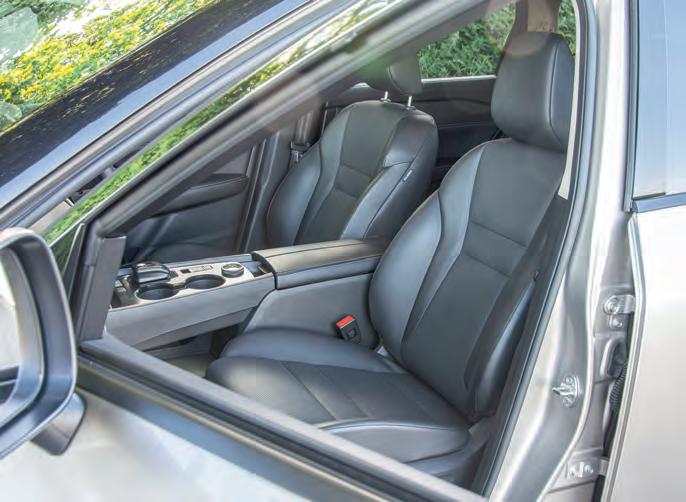
Water-resistant, wipe-clean seat covers are a highlight of the N-Trek’s spec. They go along with rubber floor mats and a boot liner to help protect the vehicle’s interior from wet and muddy clothes when you get on board after your outdoor adventures
Fluids won’t soak into it like a sponge, but it doesn’t feel harsh to touch like a plastic mac and it’s comfortable to sit in whether for short hops around town or lengthy slogs up the motorway.
In Nissan’s words, this ‘reflects the adventurous spirit of N-Trek buyers.’ There are so many jokes you could make here, all of them about dogging, but as it turns out said N-Trek buyers ‘are more likely to return to their car after sporty activities outdoors in all weathers.’ So if you’ve been out there hitting the singletrack on your MTB, you can sling it on the back and head home still clad in your wet and grimy kit knowing that all you have to do afterwards is get a damp J-cloth on the case. Just imagine trying to do that in an old Range Rover with the socalled teddy bear interior…
So your seats won’t turn into eternal reservoirs of wet mud, and neither will your carpets. The N-Trek is fitted with rubber floor mats and a reversible boot-liner, so you can keep your wet shoes on for the journey home too. As Nissan puts it, ‘whether they’re trail running, mountain biking or just splashing in muddy puddles with the kids, customers can jump into their N-Trek with less concern for the upholstery.’ Which is very much the point, because even though the heroic image of an SUV supporting your biking, running, surfing and kayaking lifestyle is a very pretty one, in reality you’ll be using it for school, office, supermarket,
repeat, with the occasional visit to the local woodland playground where once in a while it might have been raining. Similarly to allwheel drive coming to your aid on the one day a year when it snows, this is when those waterproof seats will make you glad you’ve got your N-Trek to support your outdoor lifestyle. And that’s fine.
Elsewhere, it’s a lot like driving any other X-Trail. Which is to say it’s very, very good. The cabin is very well put together using materials that feel like they’re built to last, giving you an excellent driving position with loads of room around you and a fine view of the road ahead. There’s no way any other model is going to match the sensational eye appeal of the quilted tan leather in the Tekna+, but it’s neatly laid out and easy to use and there’s no shortage of places to stow your stuff – no small matter when you’re getting set for a mission in the great outdoors. The media screen is big and sharp, and the infotainment system behind it works well – though the menu for silencing the speed limit warning beeper needs to be easier to find.
The leather on the Tekna+ is well chosen for how classy it looks, as is the fabric on the lower-spec N-Connecta for how robust it feels. Here in the middle, the same can be said of the N-Trek’s water-resistant covering. It’s not the prettiest to look at but
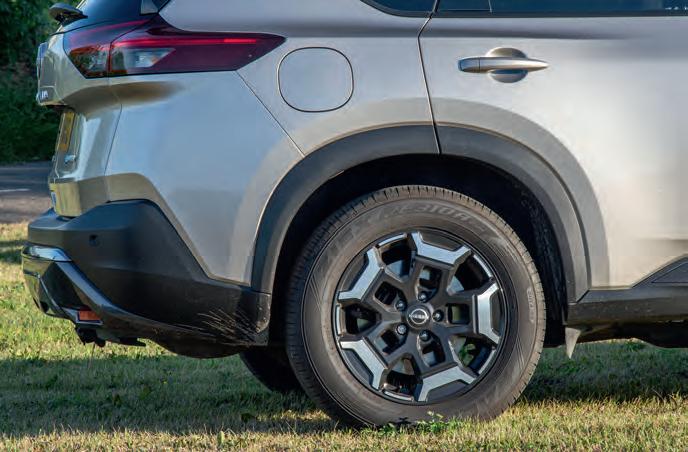

Front and rear bumpers feature deep lower inserts in gunmetal grey, adding to the sense of toughness. So too do the unique 18” alloys, whose diamond-cut finish gives them a suitably technical feel
it’s not offensive and it does its job. And it certainly doesn’t prevent the seats from being as comfortable as ever, with plenty of adjustment in every area both up front and in the back. The third row is best left for kids, of course, but the second is more than capable of accommodating tall adults.
There’s a bit of space for cargo with all seven seats up, a lot with five and an unbelievable amount with two. Both the second and third rows fold completely flat,
allowing you to slide all sorts in there, and a vast tailgate aperture means it’ll take bulky items as well as long ones. Even by the standards of its class, which are very high, it’s phenomenally good at carrying stuff. This is the case with every X-Trail, not just the N-Trek. And so too is its balance between ride and handling, with rubbish roads ironed out capably and plenty of scope to enjoy yourself on twisty roads. It steers with precision and holds the road like
glue, and body movements are smooth and predictable. There’s no shortage of power, either, whichever drivetrain you’ve got.
So it’ll take you into the great outdoors and you won’t mess it up beyond redemption, however wet and dirty you get in pursuit of your chosen form of fun. We don’t mind betting, though, that however entertaining your biking, running, dogging or jumping in muddy puddles might be, your X-Trail is what you’ll enjoy most.
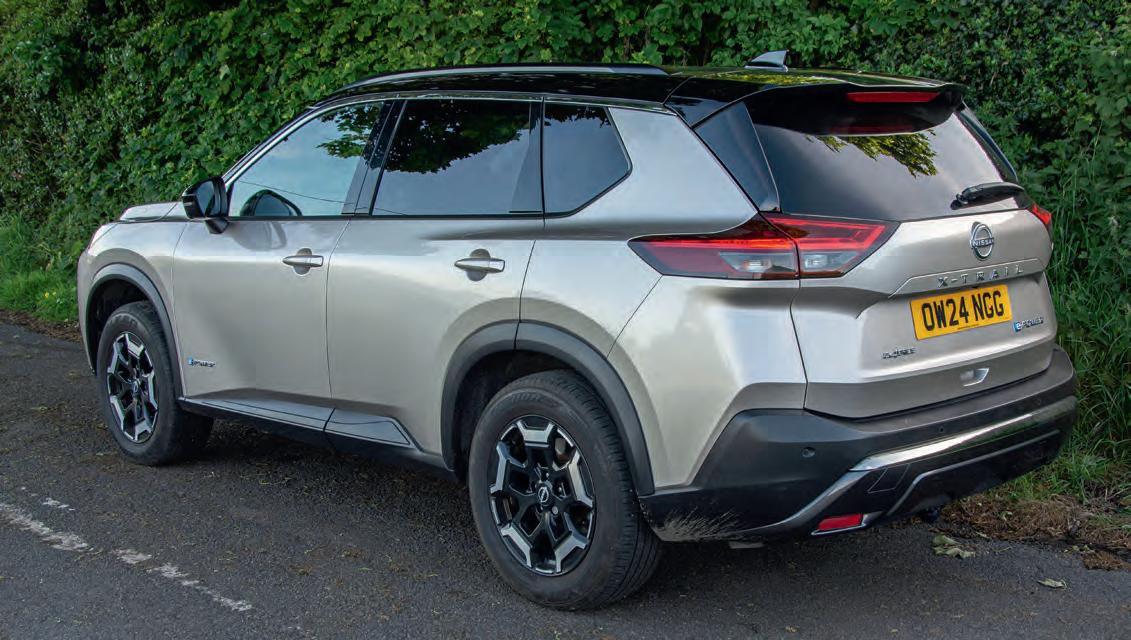
n Access from 3pm on Saturday 5th July
n Driver & All Passengers Get in Free
n £1 General Yellow Cars
n £10 Grouped Yellow Display Vehicles
n Grouped Display Vehicles must be booked in advance
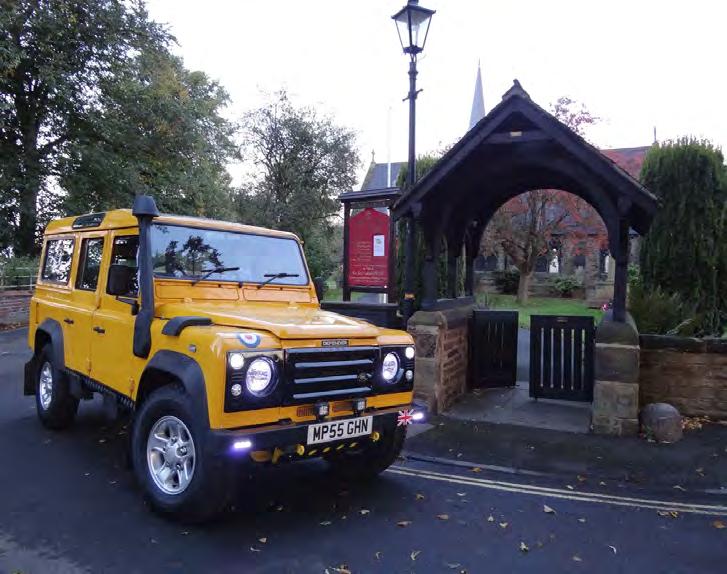
n Access on Sunday 6th July 10am-4pm
n Save 20% when you book in advance
n £8 per adult | £4 per child (5-15)
n (On the Gate £10 per adult | £5 per child)
n Free parking
n Under 5’s go free
n Dogs on short leads welcome
Real ale and cider tent | Street food vendors and food court | Picnic area
Shop from our many stalls selling everything from car accessories, camping equipment, gifts and novelties | Children’s inflatables and activities
Thousands of yellow cars are coming together for the biggest gathering of yellow cars on record. Bear witness to the spectacleit’s bound to put a smile on faces young and old alike! Take a look around our groups of display vehicles, including Super Cars, Classics, 4x4s and Custom Cars. And look out for some famous cars and faces you just might recognise.
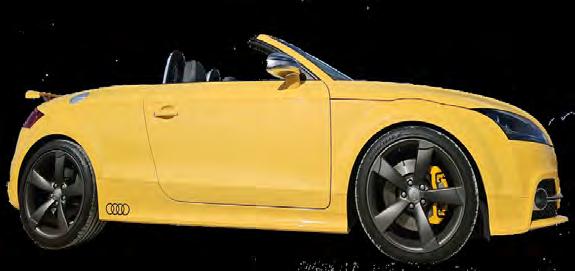
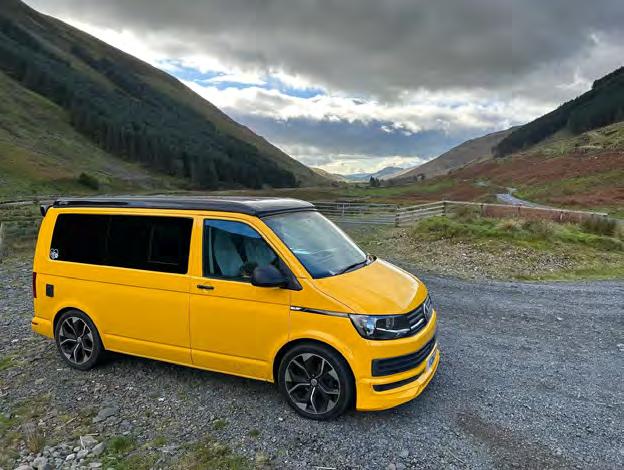














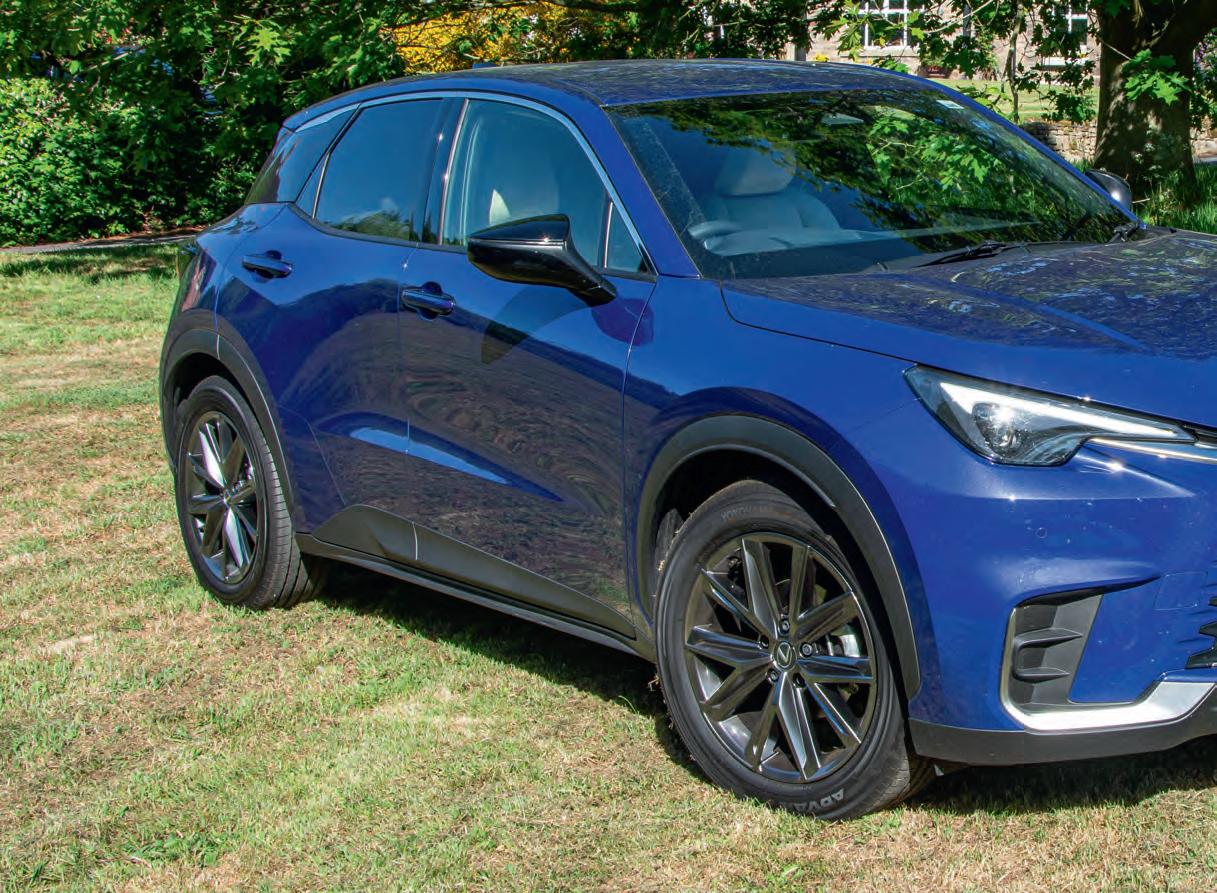
There are things you think you know. The sun will come up in the morning. The tide will go in and out. An old Land Rover will get you almost anywhere and leave a trail of oil so you can find your way back. And a Lexus, any Lexus, is out of your class.
Toyota’s premium brand is known for its faultless build quality and brilliant dealers, and for having a level of customer satisfaction at least one other premium car maker we could mention with an SUV or two in its line-up can only dream of. But it’s also known for making vehicles that cost a
lot. You get what you pay for, but if you can’t afford it in the first place that’s a bit of a moot point.
Obviously, it remains so if you need, or want, a large SUV like the superb RX. And Lexus has never made an off-road vehicle as such, at least not for the UK market. But for the very many people who go about in smaller SUVs like the Ford Puma and Kia Sportage, the LBX promises to be a game changer. It’s a proper Lexus – yet it starts at less than £30,000.
Starts, yeah. We’ve heard that one before. So let’s put some flesh on those bones. The
entry-level Urban model is currently priced at £29,995 on the road. There are four main models in the range, plus a Design package and, right at the top, the option of all-wheel drive, putting eleven different versions on the price list (plus eight more on special order) – but even then, the most you can spend on one of these is £40,555. Plus paint, but even then that’s a new Lexus at a very compelling price bracket.
It’s not huge, no. The LBX is based on the same underpinnings as the Toyota Yaris Cross, which is very much the new breed of smaller SUVs. But if you’re in the market for




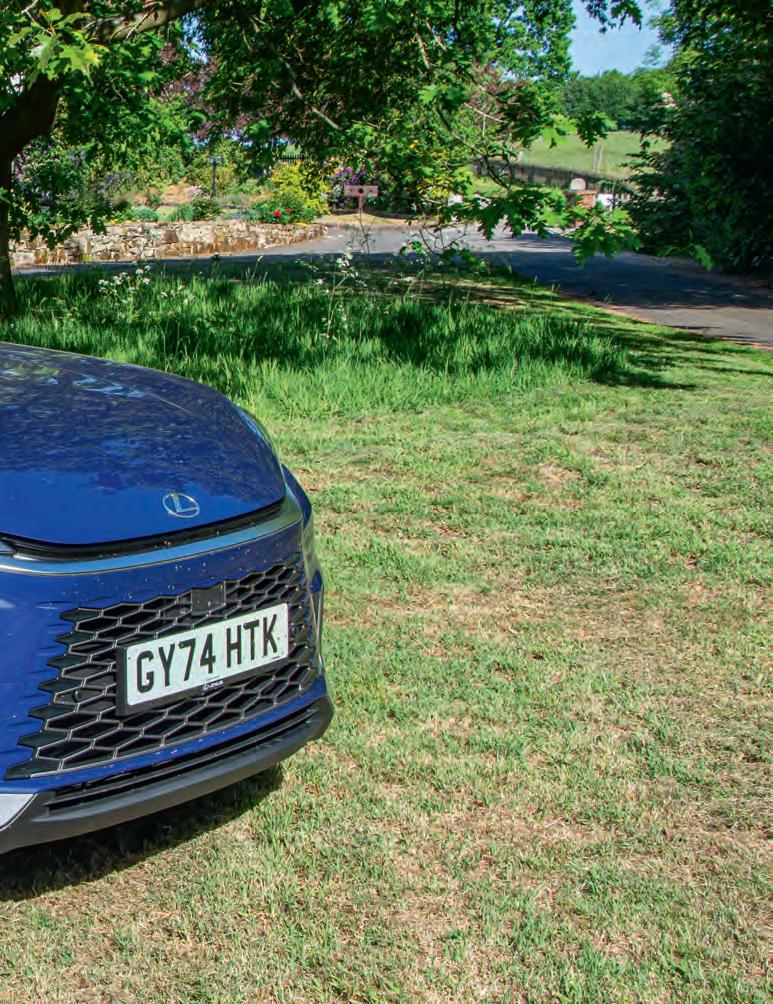
something of that nature as your daily drive, it’s a very attractive proposition indeed. You can spend more on a Sportage, or a Nissan Qashqai – both fine vehicles, but Lexus is fine art.
Now, attractive propositions can turn ugly when they become reality, and fine art can turn out to have been painted by Rolf Harris. So let’s see what a Lexus-for-realworld-money is actually like.
The first thing we’ll address is its size. A key test of a vehicle for us is what the Board of Directors (aka the Editor’s children) think of it, and if they’re not able to get in the
back without getting their knees mashed it’s going to be a no. The LBX was given a particularly stern examination on the school run as his eldest son asked if we could give his friend a lift, and his friend is one of those kids who were already six feet tall by the time they left junior school.
Verdict? ‘This is fancy! Can we keep this one?’ The seats needed a bit of fore-and-aft action to get everyone in, but we did it. And all of them loved the interior – not just the ivory leather trim (though that helped) but
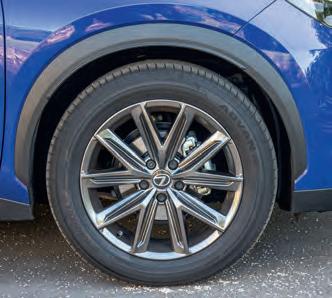
It’s easy to wreck a vehicle’s appearance with wheels that are either too big or too small, and SUVs are among the most frequent offenders. But Lexus is good at getting the proportions right and that’s exactly how it looks here, with just the right balance of rim height and sidewall from its 215/50R18s. The wheels you see here are high-gloss units in dark grey; a machined black double-spoke alternative is also available for an extra £999; it might work better with some paint colours, but we think the standard issue is spot-on here
its styling and the sheer overall classiness of it. Neither of the Ed’s sons are particularly into cars, but they certainly dug the LBX –and having less room than they’re usually used to in the vehicles we tests didn’t bother them in the slightest.
We also used the vehicle on a photoshoot, which meant loading it up with camera bags, tripods, light stands and all the assorted junk that somehow seems to be necessary just to get a picture in focus. (Haven’t these people heard of iPhones?) And much to our surprise, the boot took the lot. We didn’t even have to fold the seats down. Our photographer does like to travel with a large set of stepladders, which is basically asking it to be a small van and it’s not that, but everything else was meat and drink to it.
So its size is not a hindrance to everyday use. And it would be very easy to forgive even if it was, because the LBX is every inch a Lexus in the style and quality it brings to simply being on board.
It doesn’t just look classy in the cabin. The materials are all of excellent quality, with soft and tactile touch points and a hewn-from-rock solidity to the overall structures, and the controls are a pleasure to operate.
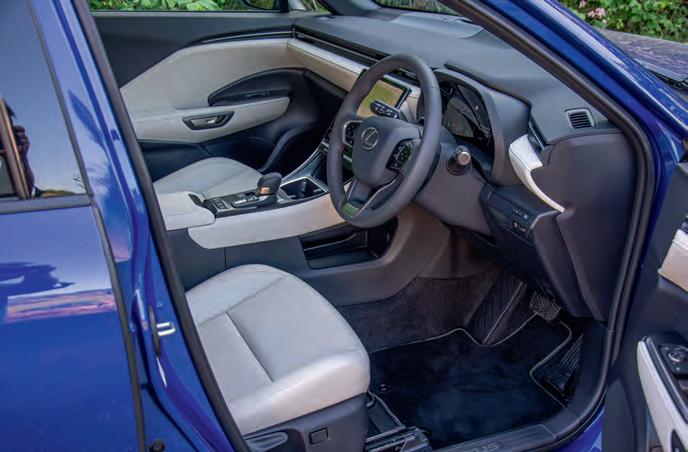
In between the front seats, a multifunction floor console sweeps upwards into a 9.8” media screen that’s tidily integrated into the facia. This links in to an excellent heads-up display via a set of multi-function steering wheel controls that take a bit of learning (you press once to select the function you want, then again to activate it) but become intuitive more quickly that you first expect.
We’d have liked it to hook up to CarPlay a bit more smartly. Linking it was no problem in the first place, but then every time we started up we had to go back in through the app icon rather than it remembering where it was when we’d switched off. On the plus side, the menu that disables the incessant
beeping all new cars must now assail you with every time you go 1mph over the speed limit is easy to get to.
This is pretty much essential whether you’re travelling in town or on the open road. Throughout the history of humankind, we can’t have invented very many things that so perfectly do the complete opposite of what they’re meant to than a road safety device which succeeds only in making drivers distracted, unsettled and angry. None of which are emotions you want to be experiencing, least of all in a Lexus; cleverly, the button which shuts it up quickly becomes a favourite on the home
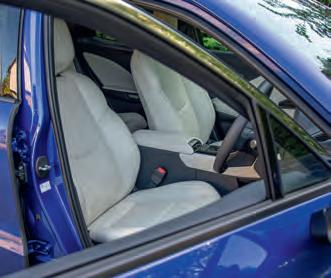
Cabin quality is a Lexus signature, and the LBX bears comparison to the bigger and more expensive models in the company’s range. Materials are good looking and tactile, and the structure beneath them is as solid as a rock. It’s a Toyota Yaris Cross underneath but a true Lexus everywhere
screen, giving you freedom in one touch to concentrate on your driving again.
Doing so is also easy thanks to excellent seat comfort, a steering wheel that feels great in your hands and an excellent view allround. The A-posts are nice and slender and there’s enough glass even for a good line of sight over your shoulder, though of course reversing is done via a rear-view camera.
The LBX is powered by a self-charging hybrid system using a 1.5-litre three-cylinder engine with 134bhp. That’s enough for a car of its size; the quoted 0-62 time of 9.2 seconds sounds a little conservative to us, but either way it’s not short of poke. Mainly it’s not short of economy (we didn’t manage to match the official figure of 61.4mpg, but
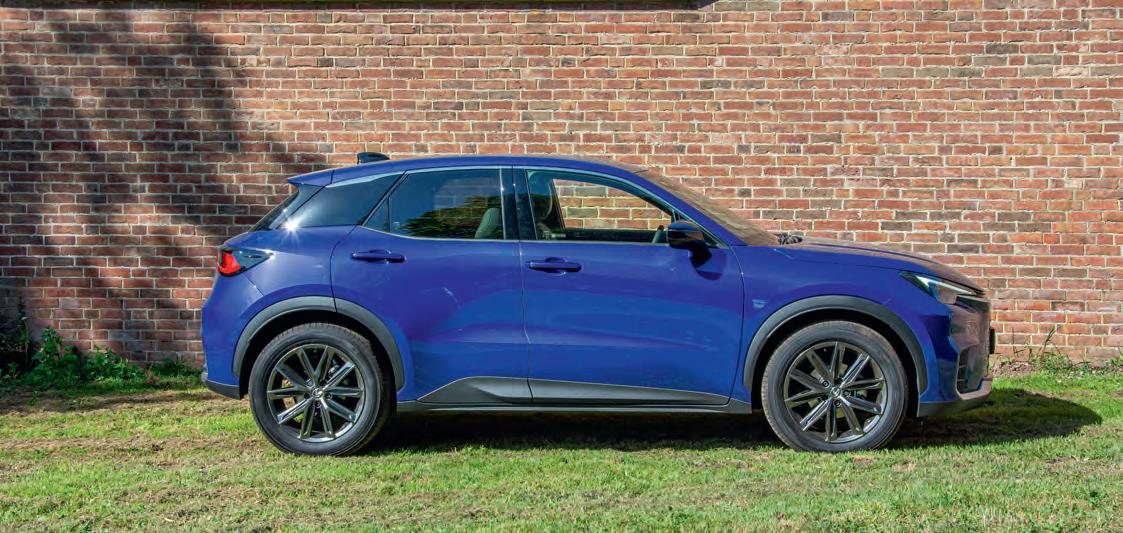
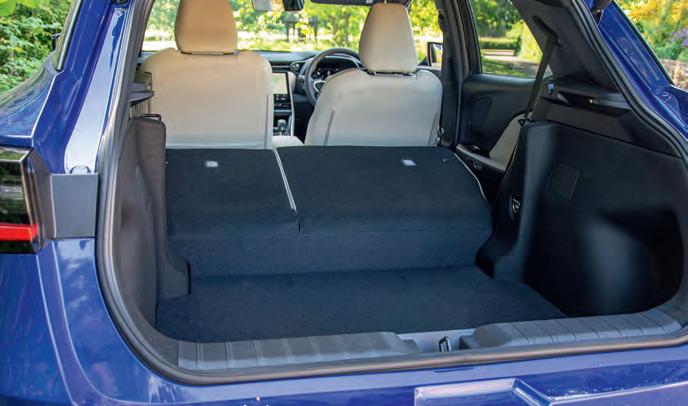
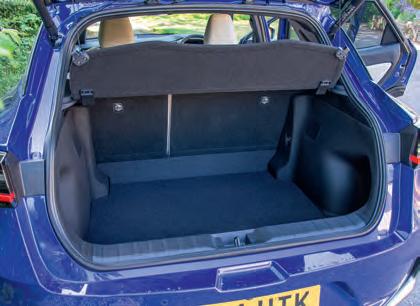
this is still a very efficient SUV on fuel) but while it’s not a flying machine, you don’t find yourself wanting more. It’s delivered smoothly and, in the main, quietly – a small engine and a CVT box will always mean a bit of a commotion under hard acceleration, but Lexus’ trademark refinement is little troubled all round. At motorway speeds, engine and wind noise are basically absent, leaving only a background rumble from the road which doesn’t prevent normal conversation or force you to turn up the stereo to offensive levels. It’s stable, too, making it easier and more relaxing to drive than you have a right to expect of a small car.
Coming at it from a life spent in larger SUVs, you almost expect the LBX to have a hard ride. And it’s not as plush as Lexus’
We were apprehensive about carrying passengers in the back, but everyone got on board with no complaints. Fitting one six-footer behind another is possible, however if it’s on the driver’s side we found that it would leave you too close to the wheel. Headroom in the back is surprisingly good, though – it’s just fine as a family SUV
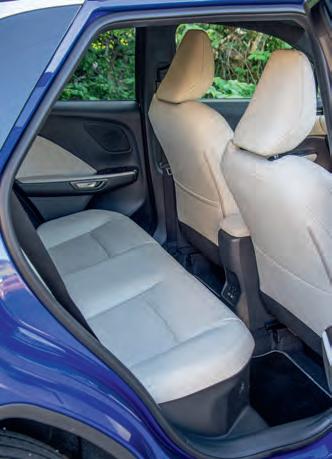
bigger vehicles – however we’d describe it as positive rather than firm. It’s composed and well handled; you do feel the bumps but they’re not harsh. Even the most savage of pot holes don’t send shudders through the vehicle’s body, and corrugations are smoothed out without a care. It’s not limo-like but for a sub-£30k SUV with, give or take, the footprint of a Mini, it’s very impressive indeed.
There’s a good balance of ride and handling, too. Its straight-line stability on the motorway doesn’t come at the expense of any alacrity on A and B-roads, where it’s easy to drive but certainly not bland. It doesn’t feel like a sports car but it does have some zest to it and its chassis resists body roll very well. Couple this with very positive steering, in particular at town speeds, and it almost feels like driving a warm hatch.
The CVT box rarely does that all-noise-noprogress thing they used to specialise in, instead taking a load of the effort out of driving the vehicle – whether you’re cruising, hustling it around town or having a go on a fast road. It does everything well: ‘feels like a Lexus to drive,’ it says in our notes, and that’s a pretty good thing.
And the LBX is more than a good thing. It’s a very good thing, a great one in fact, at a price that makes it a fantastic thing. While some premium car brands are trying to position themselves as far away as possible into the stratosphere, this vehicle is a statement that Lexus believes in real people too. If you’re in the market for anything even close to it, this is an absolute eye-opener. If you thought that Lexus was out of your class, the LBX will elevate you to a status you didn’t know you had.
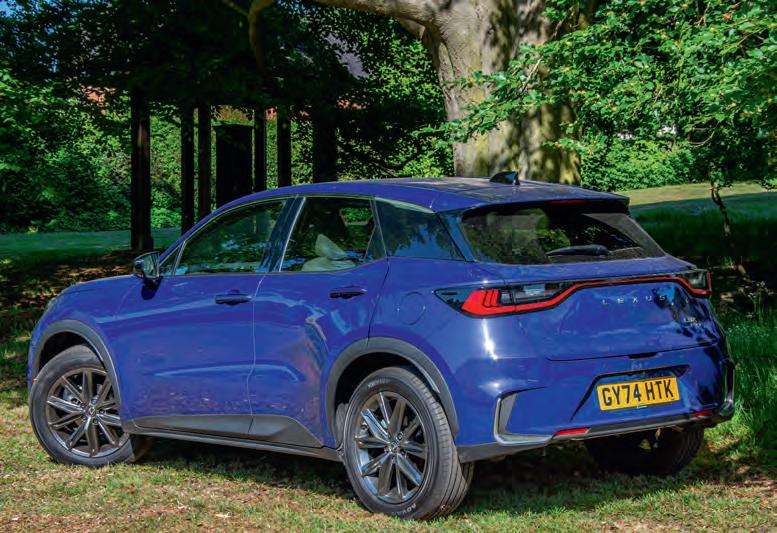










Casual fun every other weekend or so can easily turn into something more expensive. We could be talking about affairs of the heart, but affairs of the metal are more expensive still. And dirtier…



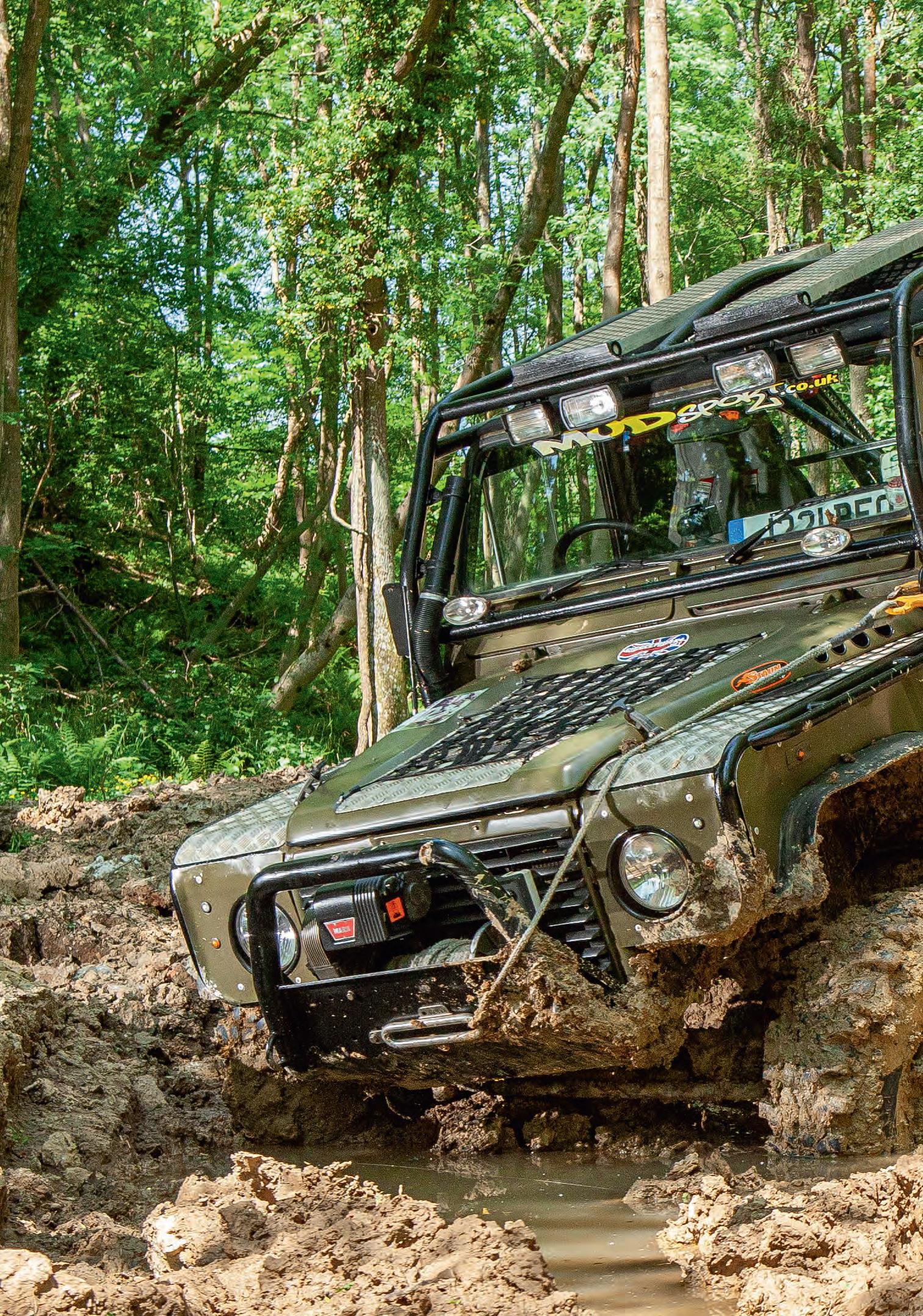


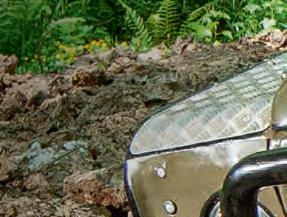




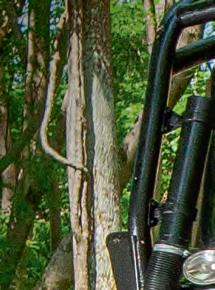
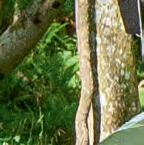





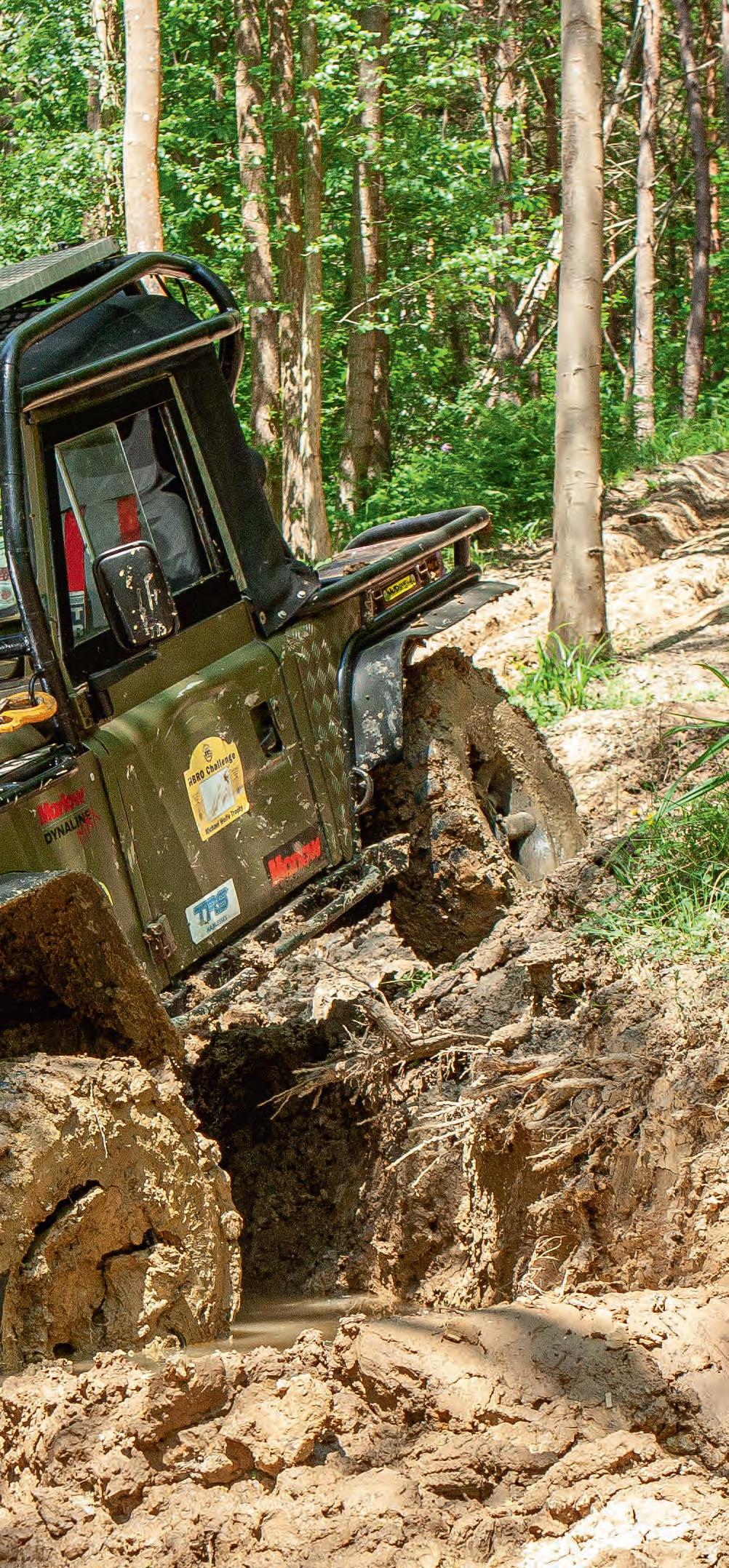



You know how it goes. It’s just a bit of fun to start with. The occasional dirty weekend, no regrets, no harm done and forget about it ’til next time you fancy some action. But then you start wanting to go further, you want to get more dirty… and in return they start wanting more of your time and money.

No wonder so many car enthusiasts refer to their motors as ‘she.’ Projects are more like relationships than we care to think. But at least this one hasn’t ended in bitter acrimony and suits cut up with scissors.
Like any relationship, it’s cost good money. But for that, Ben Halls gets what he calls comfort and enjoyment – which are not the qualities you’d first expect on seeing this tough-looking rig.



It’s the age-old tale of man meets Land Rover. It then progressed to ‘pay and play’ (or ‘affair’ to give it the human equivalent) and that then moved on to serious competition. Ben’s dirty weekends at least do not contain moral hazard, despite him spending time with a sidekick called Sizzle.
Ben is an engineer, based in Kent, and most engineers are far from frivolous people. Sample question and answer from our chat together: ‘So, tell us, what got you into off-roading Ben?’ Answer: ‘A friend.’
Well, we can’t stand around idly chatting all day I suppose. He might not be a man of many words, but he’s been a man of many relationships, at least in 4x4 terms. Prior to the Land Rover 90 you see here, he’s had a surprisingly varied list of dalliances. It’s a bit like having a preference for brunettes,

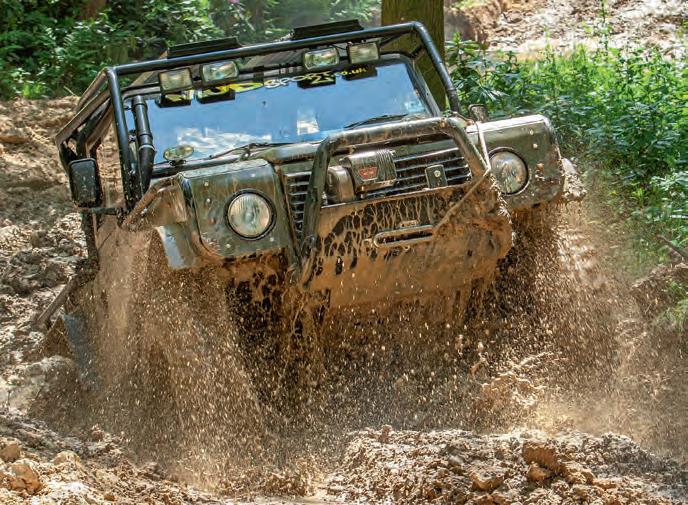



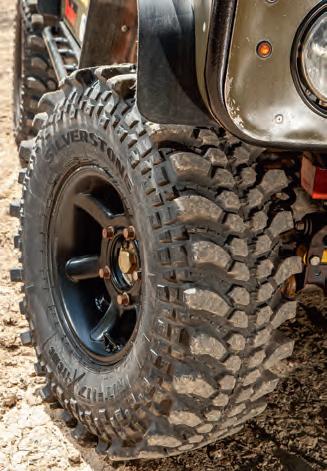

Above left: Conveyor belt material makes for tough, flexible wheelarch spats. Unusual but very effective. Beneath them, 35x11.50x16
Silverstone Xtremes are fitted using Staun beadlockers, with 32mm spacers providing more stability and steering lock
Above right: This is what entered Ben’s life as a beaten-up old 90 with half a roll cage. The rear tray is elegantly shaped from tube and ties in to a full six-point safety structure. Note the uprated Warn 9000i nestling behind the rear crossmember, which does no harm at all to the vehicle’s departure angle
Below left: Mudsport Automotive came and went in a couple of years, but during that time the company supplied the smart looking bumper adorning the 90’s front end. The Warn 8274 mounted to it was given what qualified at the time as a pretty good range of upgrades
Below centre: Ben designed and built the tree sliders himself, starting off by fitting them up as basic box-section nerf bars. With these in place, the sills were completely safe from harm; next step was to add the tubular extensions, which mean the vehicle can lean up against trees without so much danger of adding to the war wounds the doors have been carrying since way back when
Below right: We meant what we said about the 9000i not getting in the way of the vehicle’s departure angle. Not that Ben is one to be easily satisfied: he actually thinks the rear overhang he designed is too big. All we can do is agree that it’s not zero, while at the same time pointing out that if you’ve got a better departure angle than this, it’s because you’re in the top hundredth of a percent
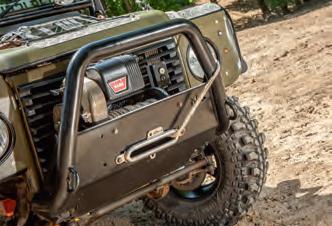
and blondes, and redheads. The collection includes Suzuki’s SJ, Jimny and Vitara (all a bit blonde, surely?), as well as various Land Rovers including a Discovery and Range Rover. A bit like two-timing both Stacey and Nessa, that, which takes us from moral hazard to mortal hazard.
Now, though, it’s probably a good time to finish with the relationships analogy. Because the vehicle you see here was originally owned by a friend of his. When
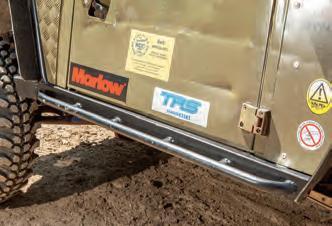
Ben got it, there was already a light sprinkling of modifications, including a lift kit, winch and half a roll cage. For about six months it stayed like this, a weekend toy for pay and play days, but then Ben set about a total rebuild. Time to get serious.
As an engineer, he did 90% of the work himself but wanted to namecheck Sizzle, who did the other 10% and helped transform an old 90 into a tidy off-roader. The major change is that they turned it into a trayback.
To do this, they removed the rear crossmember and replaced it with a winch

tray. The main chassis rails were plated, too, to make them stronger and to protect from any load-bending. Ben was impressed with its basic integrity: ‘It was a very solid chassis to start with.’
Interestingly, he also comments that if he did the job again, he’d shorten the back even further. That’s quite a thought, given that this isn’t exactly the length of a Range Rover now. What he did do was remove the whole rear tub and build it back up again in tube. Then he added a full cage around the cab, with the rear tubular sections integrating
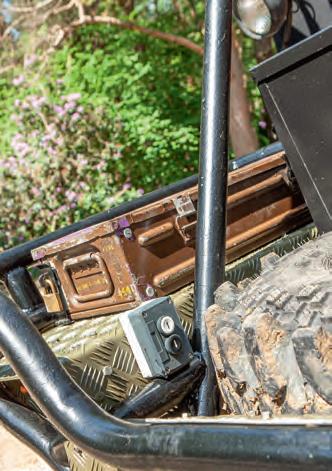
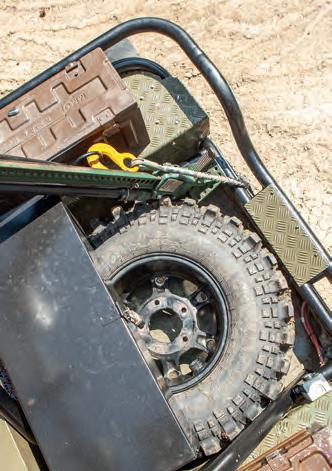
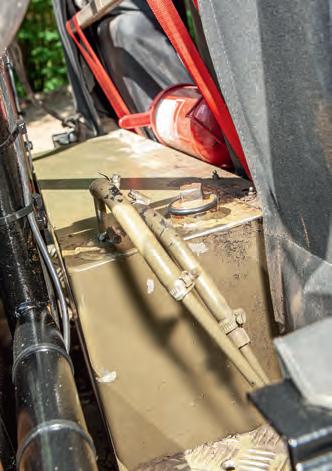
Above left: Rear winch controls are tucked neatly inside the safety of the tray frame at the back. Ben and his mate Sizzle skinned it out using plenty of chequer plate, which doesn’t look out of place alongside the ammo boxes for his recovery gear
Above centre: Bearing in mind that the spare tyre’s diameter is almost 40% of the vehicle’s wheelbase, the fact that it’ll fit in such a short rear tray is quite the feat of planning. This view shows just how well thought out it is, too much rear overhang or not. The reason why the offside rear cage stay looks odd here, by the way, is that there’s a high-lift jack mounted on it
Above right: The stainless steel fuel tank is much better located than the original, but it’s obviously still very heavy. Placing it in the middle of the vehicle, right behind the seats, therefore helps with weight distribution – and having it so well shrouded without the safety cell keeps it out of harm’s way, too
Right: Up on the roof are the two waffle boards, mounted to the top of the front and rear hoops. With a soft-top, you’d want that roll cage to be strong – though to be honest, in the majority of off-road rollovers the waffles themselves would be man enough to take it on their own. At the front of the cage are four spotlights, with another four to the rear
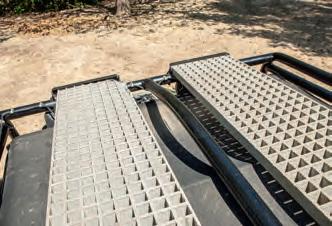
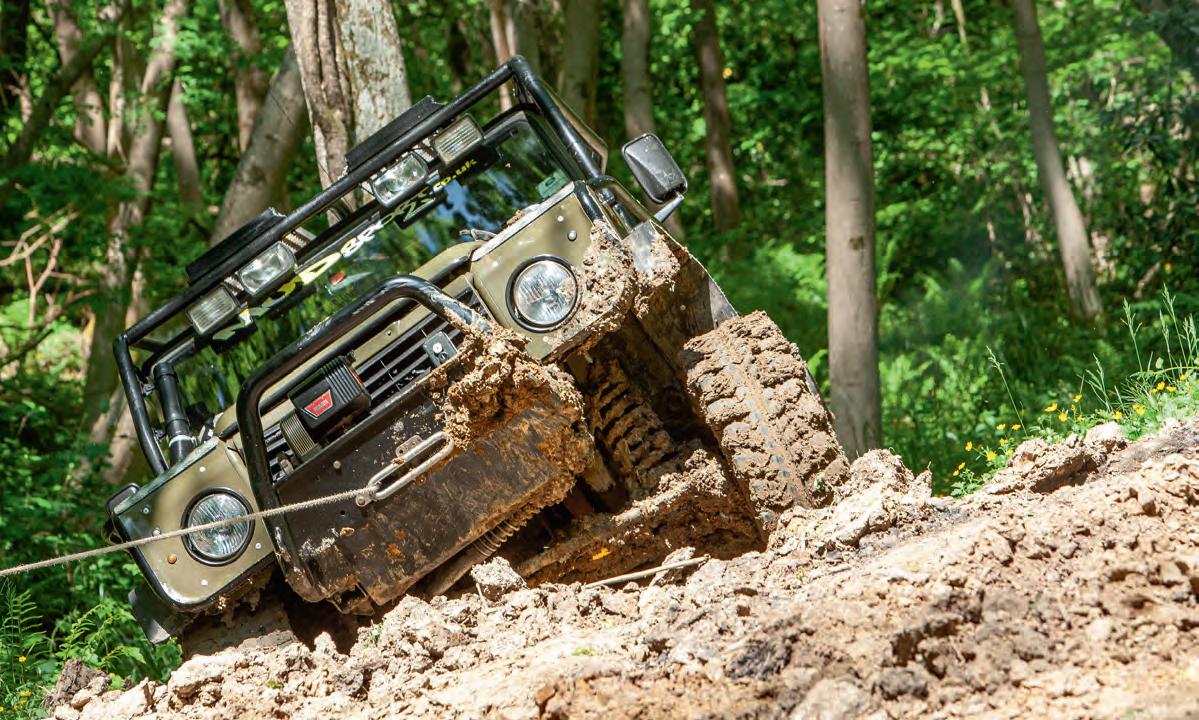






























Above left: The already hefty 90 front axle is beefed up further by a bolt-on diff guard. Keeping the diff itself out of harm’s way is a good idea as there’s no small amount of investment in it – as well as a lower-ratio ring and pinion, there’s an air-operated Ashcroft locker in there
Above right: The rear diff isn’t as brutally guarded as the front, but this truss should help diffuse any reversing-speed wallops all the same. A different form of protection comes from the raised breathers, which keep water out even when it’s slopping around Ben’s feet
Below left: Toyota Hi-Lux springs and Old Man Emu shocks provide 3” of lift and enough travel to make the most of it. As you can just about see, the front axle is located as standard using radius arms, while bushing all round is by Powerflex
Below centre: At the back, dislocation hooks and cones allow the Hi-Lux coils to seat themselves after the axle’s been taken to extreme levels of articulation. Land Rover’s original trailing links have been replaced by cranked units to let it go further than ever here; note also the very necessary extended bump stops Below: Tuff enuff? The adjustable panhard rod doesn’t look ready to give up in a fight, unless the fight happens to be with the brutal looking drag link next to it. It’s not every day you see a coil-over steering damper, either
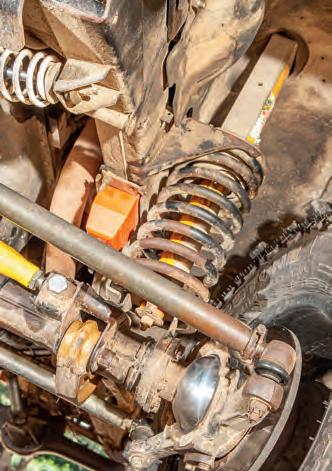
into that cage. Inside that cage, behind the bulkhead, is a stainless steel fuel tank.
The cab itself features a soft-top; the only standard parts you see in this area are the bulkhead, seat boxes, bonnet and











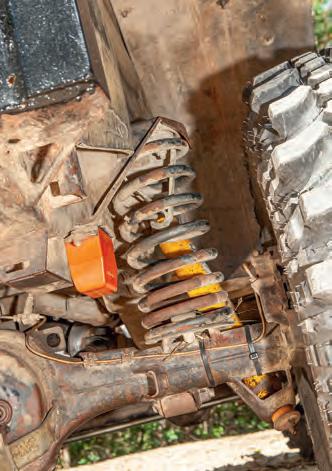
doors. The wings and front arches came from North Off Road, which dates things somewhat, but much of the rest of what you’re looking at is custom.
Of course, at the rear there was room to spare for the tyres. And both front and rear arches are lined with conveyor belting. Some might see that as a bit of a left-field material to use, but it’s very robust stuff –and a top tip from Ben is that if you then spray them with WD40 before heading offroad, the mud will hardly stick to them at all.
Underneath the arches are six-spoke hard alloys with 35x11.50R16 kept in place with



















the aid of Staun beadlockers. As you can imagine, this was a vehicle on which only a hardcore tread would do – it’s Silverstone Xtremes you’re looking at here, but even today people still refer to everything with this pattern as Simexes.
There’s a good bit of offset on the rims themselves, which also have 32mm spacers to give the 90 a four-square stance. Ben was happy to stay with stock brakes, save for replacing the flexis with extended and braided hoses – and weighing in the factory handbrake for a disc-type X-Brake.
Inboard from the brakes, the axles are all original but have been beefed up with hardened shafts, CVs and end caps. The
ALL LAND ROVER VEHICLES 1948 - 2025
ALL RANGE ROVER VEHICLES 1974 - 2025











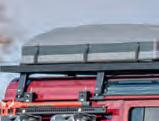



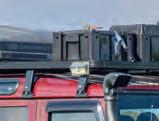

















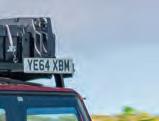

















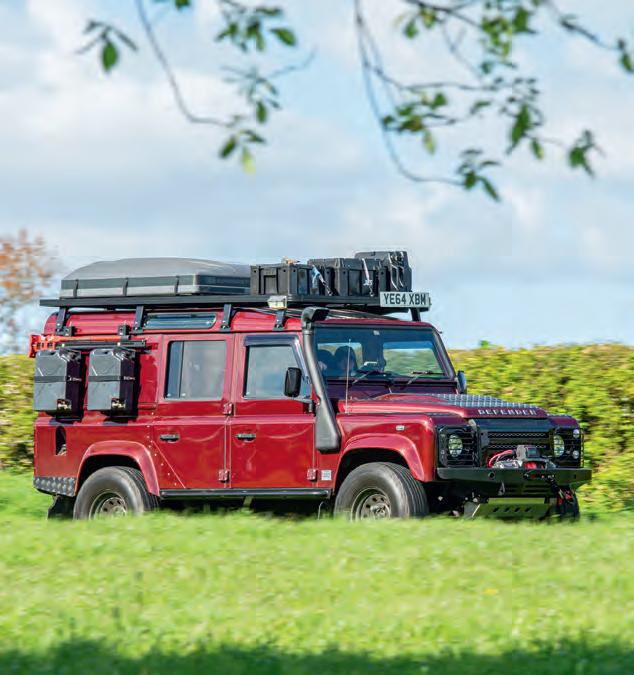




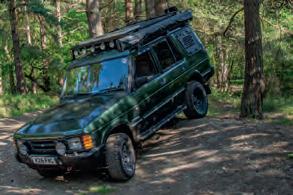

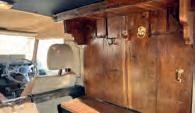






















































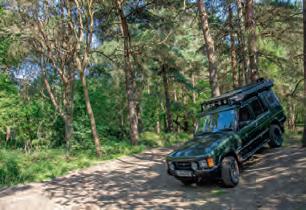

































diffs have been replaced with lower-ratio units, each of them fitted with air-operated Ashcroft lockers using uprated airline kits. The diffs also got their own guards, as did the steering, while Gwyn Lewis wide-angle propshafts and a wading kit were added to the mix.
Upstream, the gearbox and transfer box are stock Land Rover 90, mated to a 300Tdi. The engine has been tuned to run higher boost, with larger exhaust, faster fuelling and all the stuff you need to add more grunt. That meant fitting a wider finned radiator, Samco silicone hoses and a Kenlowe fan. A Discovery air box and snorkel mean that by the time it runs out of air, so has everyone on board and the truck will be the least of Ben’s worries.
And of course the whole shebang has been lifted, using Old Man Emu +3” springs and Toyota Hi-Lux rear shocks (which have four extra inches of travel). The springs and shocks remain in their original locations, which means it’s coil-over at the front, but the rear has cones and hooks to let it dislocate (or more accurately, to let it relocate without a tyre’s inner sidewall getting ground through by a spring). Talking of location, the axle remains held in the centre of the vehicle by the original A-frame, while up front an adjustable panhard rod helps prevent any crab-like tendencies.
Even with all this kit, there’s a faint chance that deep mud and gravity could grind things to a halt. It’s there to let Ben play harder, after all, not to make easy green













Comfortable? Yes, actually. The 90’s interior features Range Rover seats with four-point harnesses and washable covers. Above them is a helmet net. The CB radio is in the dash, along with auxiliary switches for items like the lights, winches and lockers. As Ben says, ‘It’s all you need’
lanes even easier. So up front there’s a Warn 8274 mounted on a Mudsport front bumper, running a Bowmotor with uprated internal gears and brake to go with the extended drum, which holds a 12mm Plasma rope. At the other end is a Warn 9000i, also running a Bowmotor, with the whole thing mounted in the aforementioned crossmember. There’s clearly potential for a grid-sapping draw of electricity here, so Ben fitted a 120amp alternator and two gel batteries.
Needless to say, all kinds of kit is carried either in the rear tray or inside, and there’s a bonnet net for when he needs a strop.
But there’s also something else inside the cabin which makes the other kind of strop less likely to happen – a pair of Range Rover Classic seats, sitting rather incongruously amid the ammo boxes, CB and sat-nav. ‘Well,’ says Ben, for once not looking quite so much the hardened engineer, ‘you’ve got to put comfort first!’
Nonetheless, this is a complete, fully functioning, fully equipped challenge truck. And one which turned out exactly the way its owner wanted. ‘It has no mod cons,’ Ben reflects, skilfully ignoring those Range Rover seats. ‘But it’s all you need.’

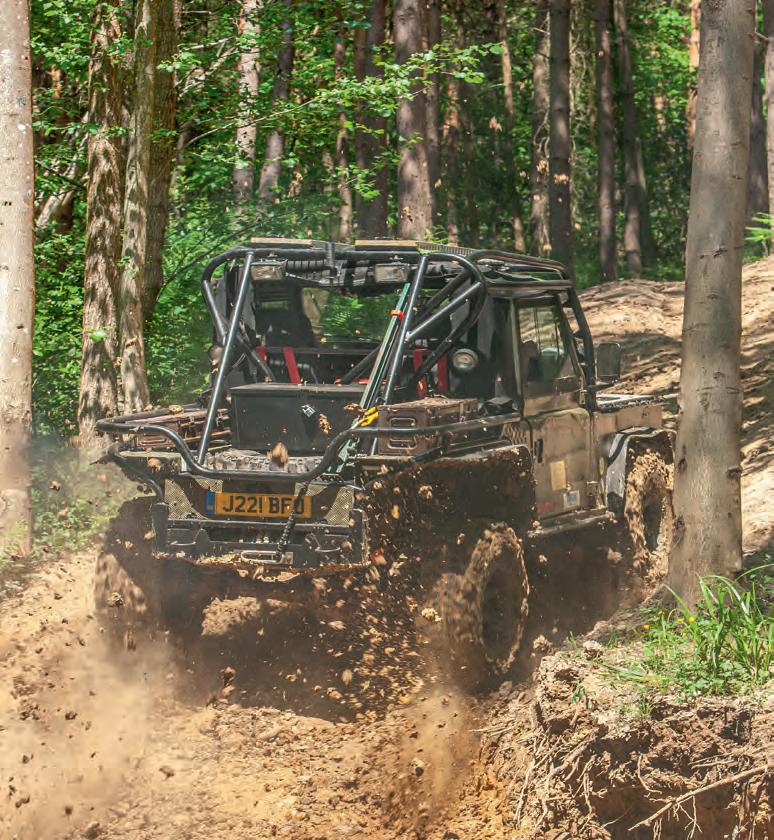
















Like a shallow but attractive partner, a beautiful, prestigious SUV may stir your soul for a little while. But the mark of a true keeper is one that really knows how to give you a dirty weekend…








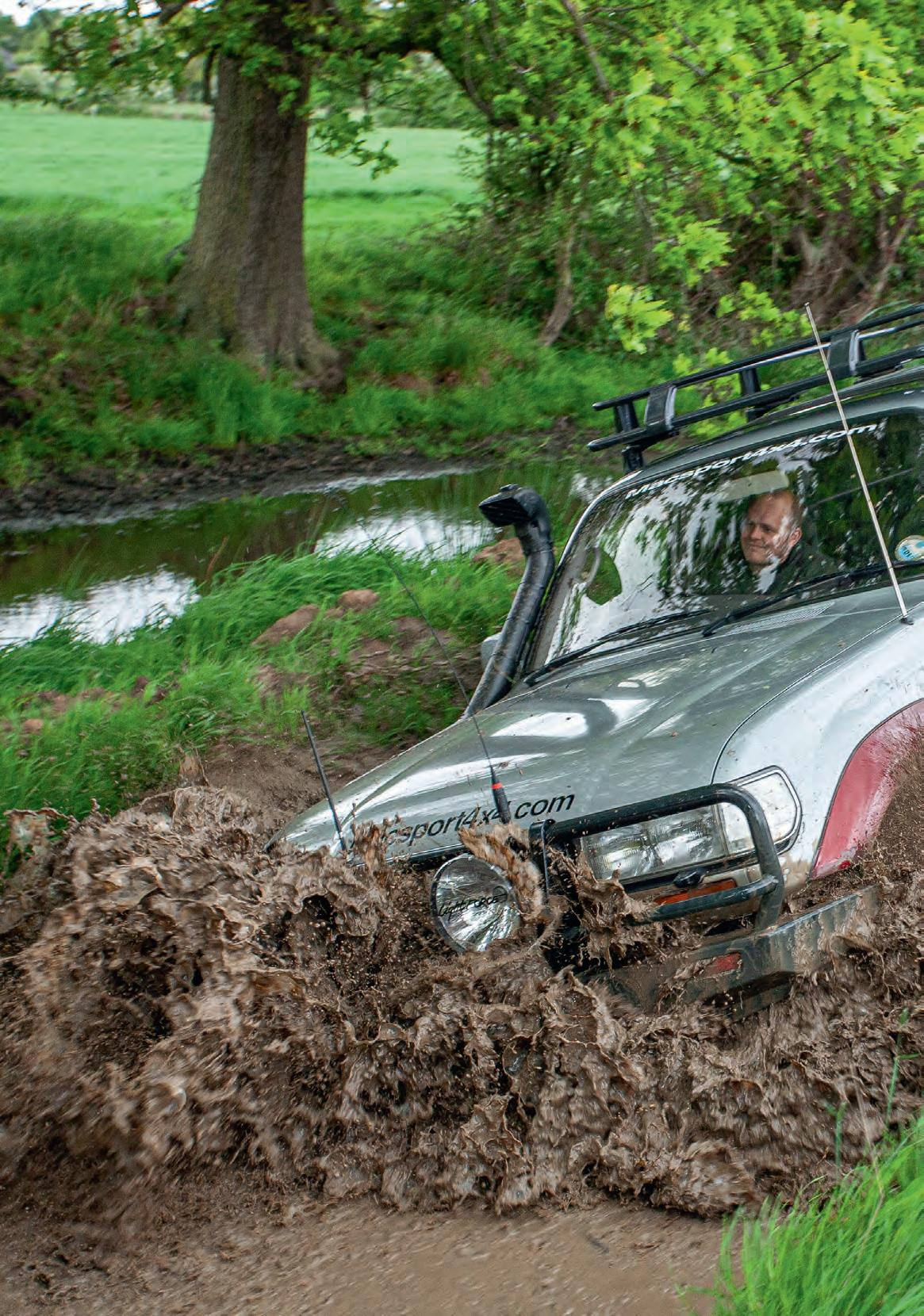




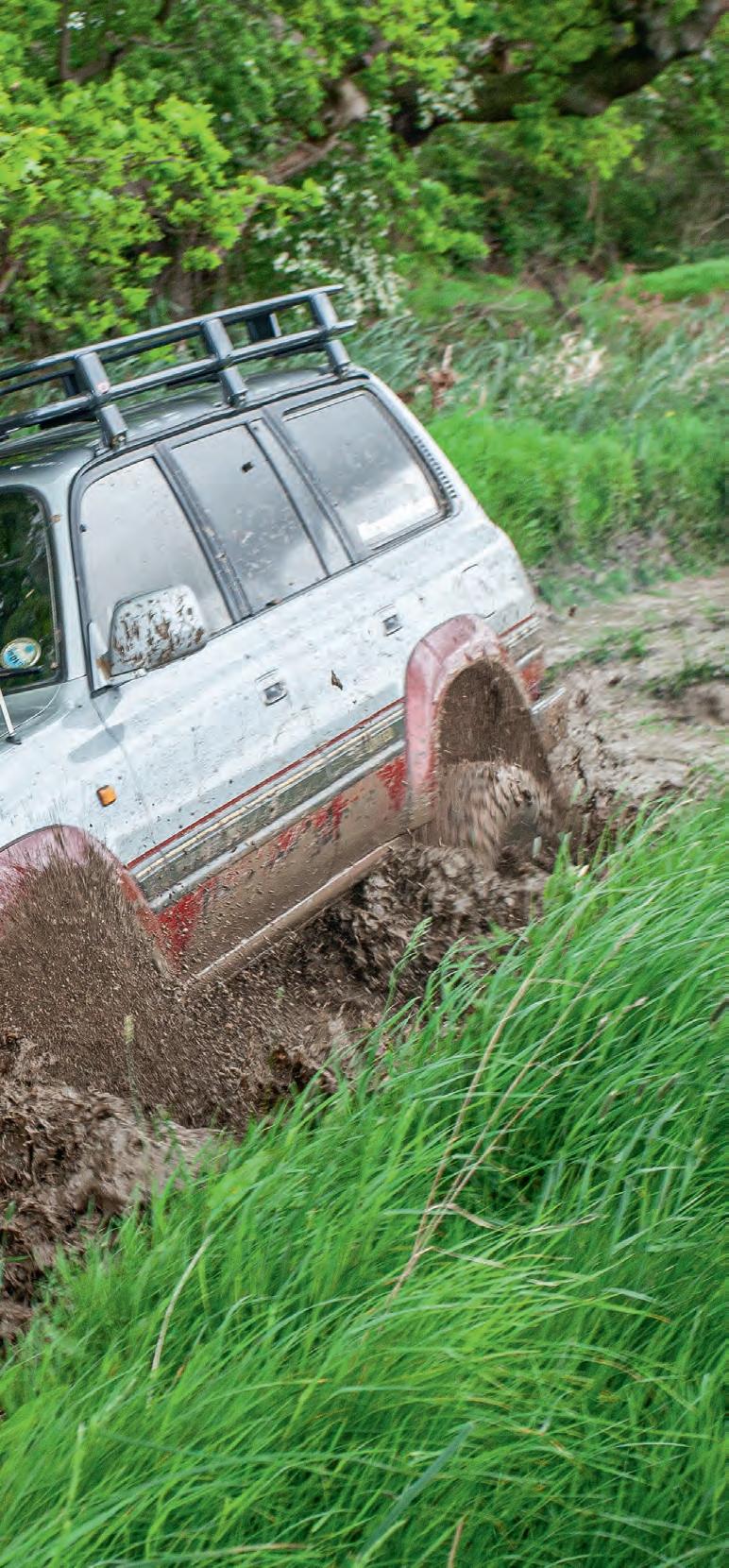



If you’ve been lucky enough to have the experience of getting into bed with someone you though was miles out of your league, you may also have been unlucky enough to have the experience of finding it a bit of a let-down. You’ll probably still boast about it to your mates, but you’ll wonder why this vision of beauty and allure turned out not to be the pinnacle of your life’s exploits after all.


Now, pardon me for bringing people down to the level of cars (or should it be the other way round?) But similarly, if you’ve had the good fortune to get behind the wheel of your dream car the experience may only have succeeded in bursting the bubble of its appeal. You should never meet your heroes, they day: you should never drive them, either. And you definitely shouldn’t sleep with them.

Now, Andy Garside was in the position of being able to own a car many of us would have dreamt of: a Porsche Cayenne S. A vehicle which pretty much revolutionised the notion of performance in the SUV world, and a status symbol worthy of walking out with a porn star on your arm. Hell, with a porn star on each arm.

But… it wasn’t working for him. It was in many ways a dream car, and it certainly drew admiring glances when he parked it up at work. But it didn’t make him feel contented. It had to go.

But what do you do when you need to replace a prestigious super-SUV that makes everyone jealous? Tricky. But fortunately for Andy, rather than having to go in search of the answer it was already there right in front of his eyes.

It was an 80-Series Toyota Land Cruiser, and it was sitting on the forecourt of a local
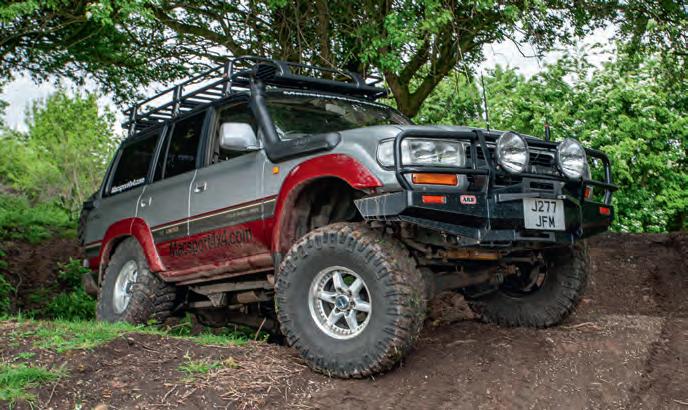




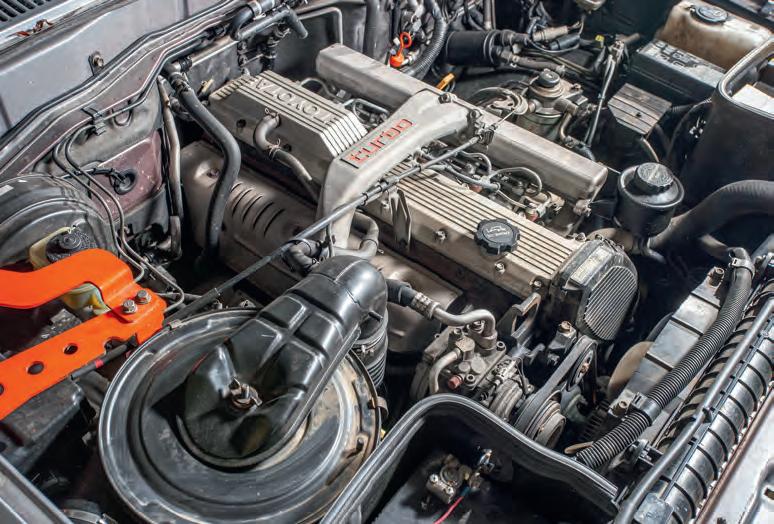
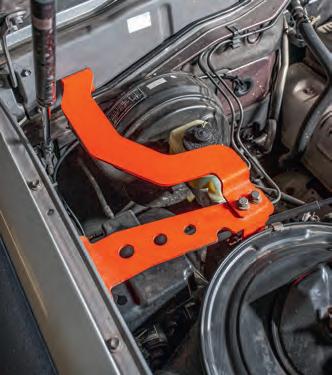

Above: Reliable, unbustable and torquier than the average power station, Toyota’s 4.2-litre straight-six turbo-diesel is a legend among engines. It’s not exactly fast, and fuel consumption might not be the best by today’s standards, but who cares when you’ve got 267lbf.ft behind you from just 1400rpm?
Top right: An unusual but very sensible modification was this master cylinder brace, fitted to cut out play in the brake pedal
Above right: Having learned the hard way at an early age that water can turn out to be deeper than you expect, Andy was always going to be including a snorkel in his list of must-haves. Needless to say, after fitting it the law of sod dictated that every ford he tried to test it in turned out to be little more than a puddle, but it was only ever a matter of time…
garage. It looked like it was in good nick and the only obvious modifications were a minor suspension lift and the addition of 32-inch tyres. ‘I thought it looked like a fun truck to own,’ says Andy. ‘After driving past it a few times, I decided to take it out for a test drive.’
Was it love at first sight? Maybe, maybe not – but the Land Cruiser certainly did something for him that the Porsche, for all its prestige and dynamic brilliance, couldn’t.
‘I don’t know why I liked the Toyota so much,’ he muses. ‘But I couldn’t help myself.’ Within minutes of returning from his test drive, he’d put down a deposit and the truck was his.
One of the initial attractions of the Land Cruiser was its epic practicality. In contrast to the Porsche, Andy felt he could lob dirty gear and an oily mountain bike in the rear without worrying about the mess it made. But once he’d taken delivery of the vehicle, and read up about it on the internet, he realised there was more to it than a large
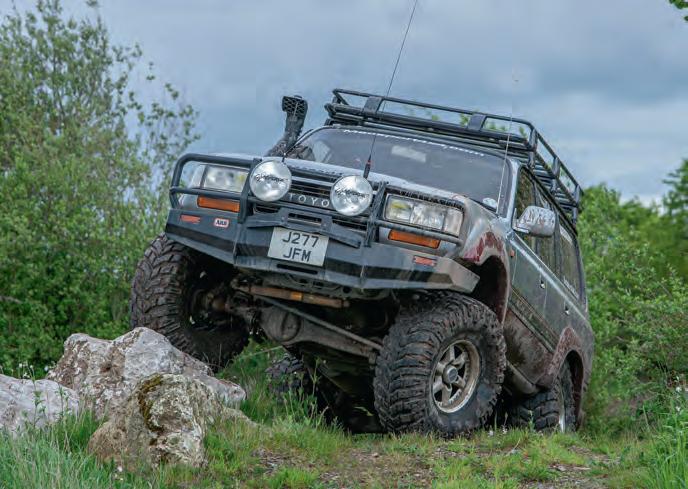
loading area and bomb-proof reliability. Andy realised he had taken possession of a vehicle that could transport him across the Sahara without breaking sweat – and even if doing that with it wasn’t possible because of work commitments, it could at least give him the occasional adventure nearer to home.
The trouble was that, as a relative newcomer to the world of off-road modification, Andy didn’t know who to approach to help him develop his truck. Fortunately, the garage owner who supplied the vehicle knew Paul McCleary, who was at the time one of the area’s leading lights in the field of bespoke off-road builds. ‘I corrupted him,’ laughs Paul, describing his impact on Andy’s off-road aspirations. ‘But he didn’t take much persuading!’
In fact, Andy was already attracted by the idea of a proper suspension lift and taller tyres when he visited Paul’s workshop to discuss the project. That was where he saw a 37” Maxxis Mudzilla tyre lying around, rolled it up against the car – and decided there and then that bigger rubber was his number one priority.
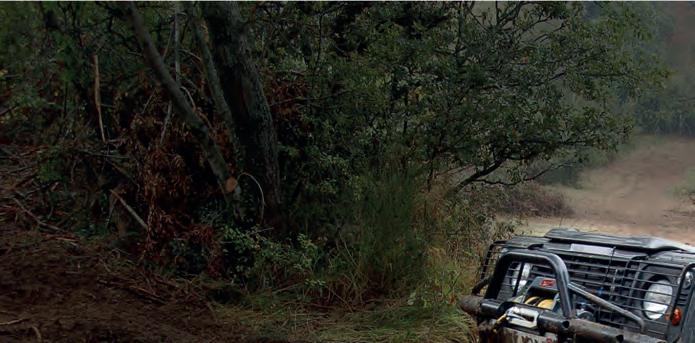



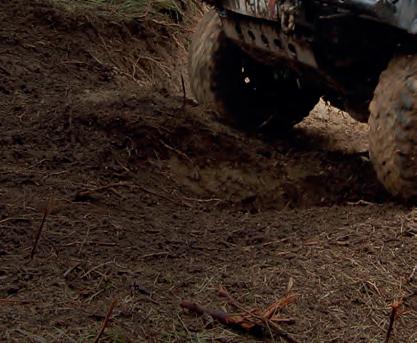
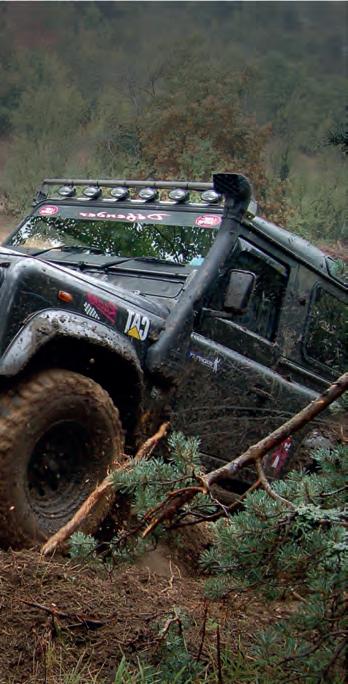

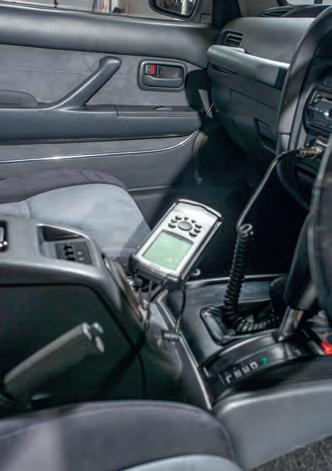
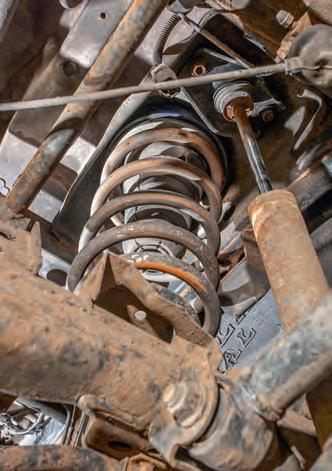

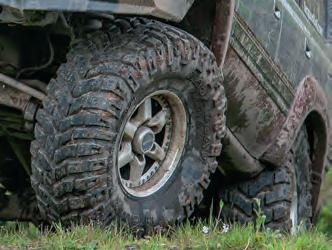
Above left: Not one but two CBs adorn the cabin – one’s for everyday road use, the other for still being heard when the vehicle’s buried inside the sort of forest you only thought existed in the imagination of JRR Tolkein
Above centre: In a textbook example of not fixing what ain’t broke, the Cruiser’s springs are the same +3” units it was sitting on when Andy bought it. They’ve been boosted by 50% with spacers, though, and a 2” body lift completes the picture, making room for a set of 37” tyres without any need to break out the sabre saw on the vehicle’s wheelarches
Top right: The Land Cruiser’s ARB front bumper was designed to take a winch. As you can see here, it didn’t have one when we took our pictures. Andy explained that all his off-roading up to then had been lane runs with friends, so it wasn’t a priority, but seldom has the phrase ‘sooner or later’ carried greater weight…
Above right: It didn’t quite all start when Andy first clapped his eyes on a 37” mud tyre in Paul McCleary’s workshop. Though a lot of it did…
Because the Land Cruiser was already wearing a 3” suspension lift, Andy and Paul decided that a further hike to the coil springs was unnecessary. Instead, Paul spread the hike across various areas and fitted a 2” body lift and 1.5” spring spacers to generate further room beneath the arches. The combined effect of these
mods was to let the Land Cruiser takes a set of 37x13.50R16s without needing any trimming to its arches.
The big tyres (Mickey Thompson Baja Claws, when we took these pictures) did however get fitted on rims with a good bit of offset. Height is one thing, but all the lift in the world won’t help if you turn your steering

wheel and get nothing more than the sound of tread bashing into radius arms.
Something else big tyres need is big torque to turn them. Not an area in which the 80-Series was ever likely to fall short, with the 1HD-T 4.2-litre turbo-diesel engine falling well and truly into the ‘legendary’ camp. It’s not fast – but whatever speed it has, it still has it with a 3500kg trailer on the back. And of course it’s one of the strongest and most reliable units ever made – keep on it with the maintenance on one of these things and half a million miles later it’ll still be fresh as a daisy.
Modifying anything, however, even something so biblical-level reliable, means introducing the potential for additional failure points. Andy’s policy with the vehicle was not to be scared of making mods – but also not to do so just for the sake of it. His aim was to keep it as standard as possible while also boosting its potential to raise a smile in the rough stuff.
With the suspension, for example, he stuck with the +3.0” springs rather than
going any taller on the basis that this was all that was needed to accommodate the tyres. He did replace the shock absorbers with Rancho adjustable units, but that was his only tweak to the existing components.
Up top, he also fitted a Safari snorkel to protect the engine from, well, everything that’s not fresh air. In most countries you’re keeping out dust with these but this being Britain, we tend to see them as an insurance policy against wading disasters. First time out, Andy had the other kind of wading disaster when he thought he was going to
Fitting a body lift meant relocating the rear bumper, and there’s also a swing-away spare wheel carrier back here. After that, it’s mainly bolt-on goodies: a roof rack for Andy’s kayak, a pair of old-school Lightforce 240-watt spotlights on the front and not one but two CBs. The first is for road use, while the second has enhanced reception for dense woodland. We haven’t heard that one before.
So, what would your next move be with this vehicle? The winch is an obvious one.
‘I don’t know why I liked the Toyota so much. But I couldn’t help myself’
get the chance to let it earn its spurs but the water only came up to the Cruiser’s hubs. This was on a lane run, which was the direction he started taking with the truck. This meant doing it in company, which is why there’s no fairlead or winch rope on the ARB bumper, but we’re witnessing evolution in progress here. ‘If I choose to go solo,’ Andy confirms, ‘or my ambitions get more extreme, I will definitely have a winch fitted.’
A LED bar perhaps? Rock sliders? A tent and awning for that rack? Andy was more sensible than that. When we took these pictures, Paul had just finished installing a brace for the master cylinder so as to minimise the amount of play in the brake pedal. However sensible you are, you just got out-sensibled.
Andy admits that he wasn’t always this sensible. There was an incident, way back in
the heady days of his youth, when he gave it death into a puddle aboard his old Daihatsu Fourtrak for the sake of entertaining the crowds at an off-road day. They were very entertained indeed because it turned out to be more like two feet deep and a good bit of it ended up in his footwells.
Maybe that’s why the Cayenne never really did it for him. It’s undoubtedly a very special motor, and no slouch off-road when specced for the job, but a brand new Porsche SUV is hardly a prime candidate for plaything of the year. To go back to the start of this article, it’s more like marriage material – not something you keep lined up for a wild weekend.
And of course it looks amazing, in a glamour model kind of a way. And how easy it is to be seduced by something as shallow as that – only to find that beauty really is only skin deep.
The Land Cruiser is a hell of a looker too, of course. But to really appreciate it, you need to know what its appearance really means. Which is, of course, that it can do things that take your breath away. Now, that’s something you might certainly see as being out of your league – but absolutely no way will it ever be a let-down.
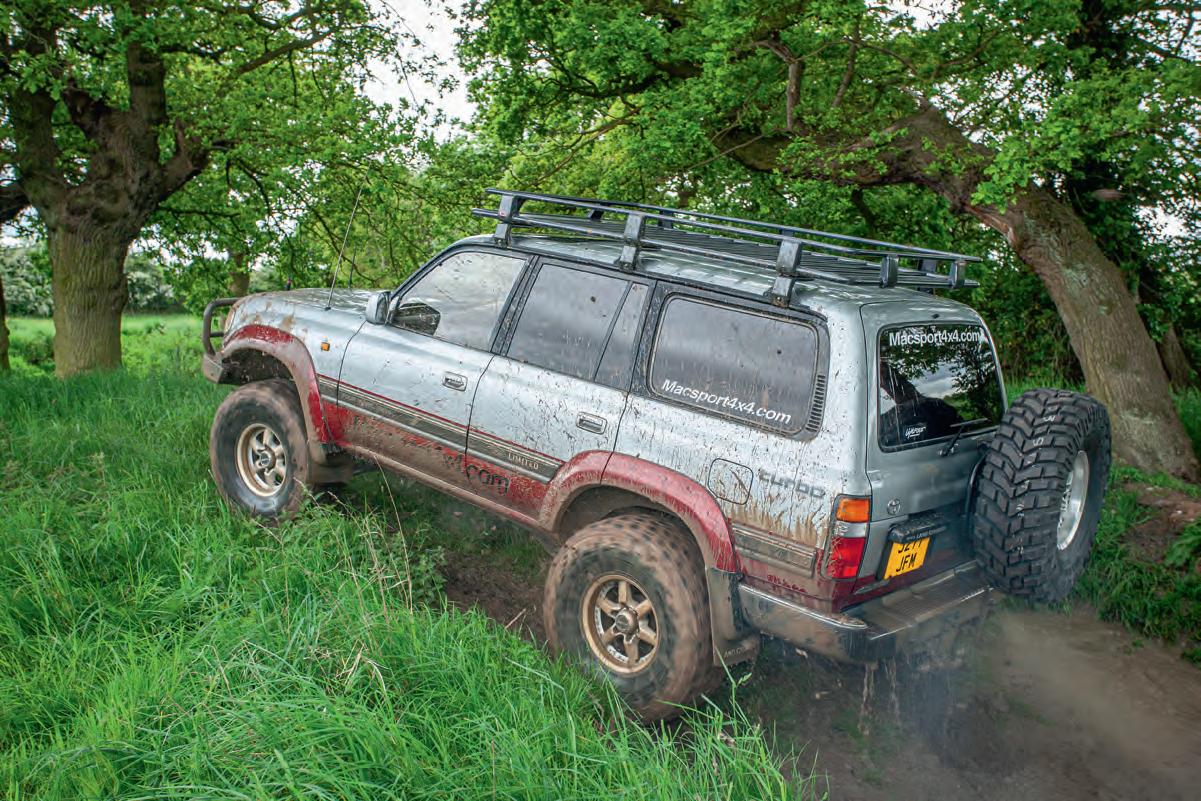










Wherever you go in the world, the sun is everywhere. So what better vehicle to chase it in than one that can follow it anywhere?
Words Tom Alderney Pictures Jeep












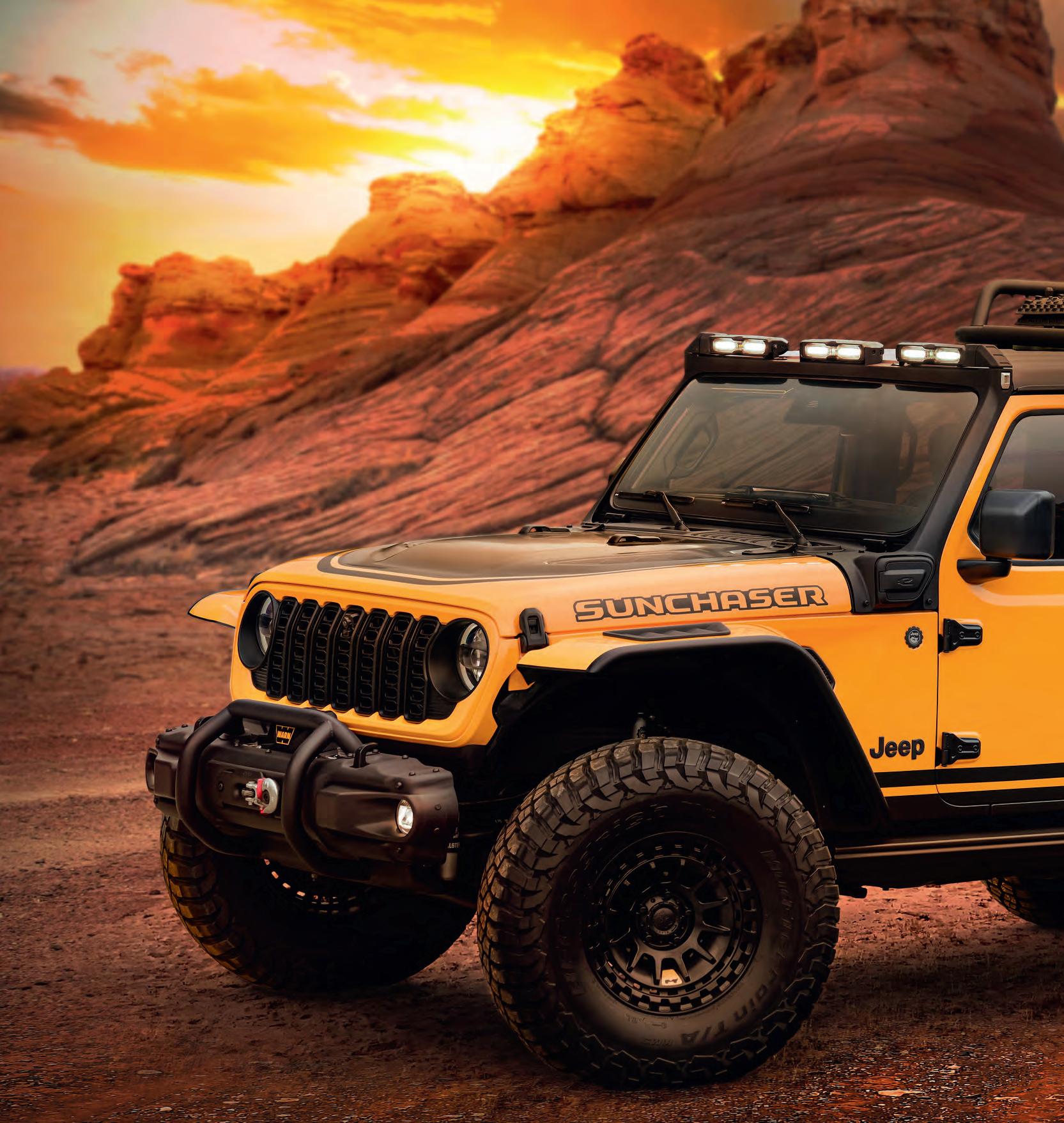



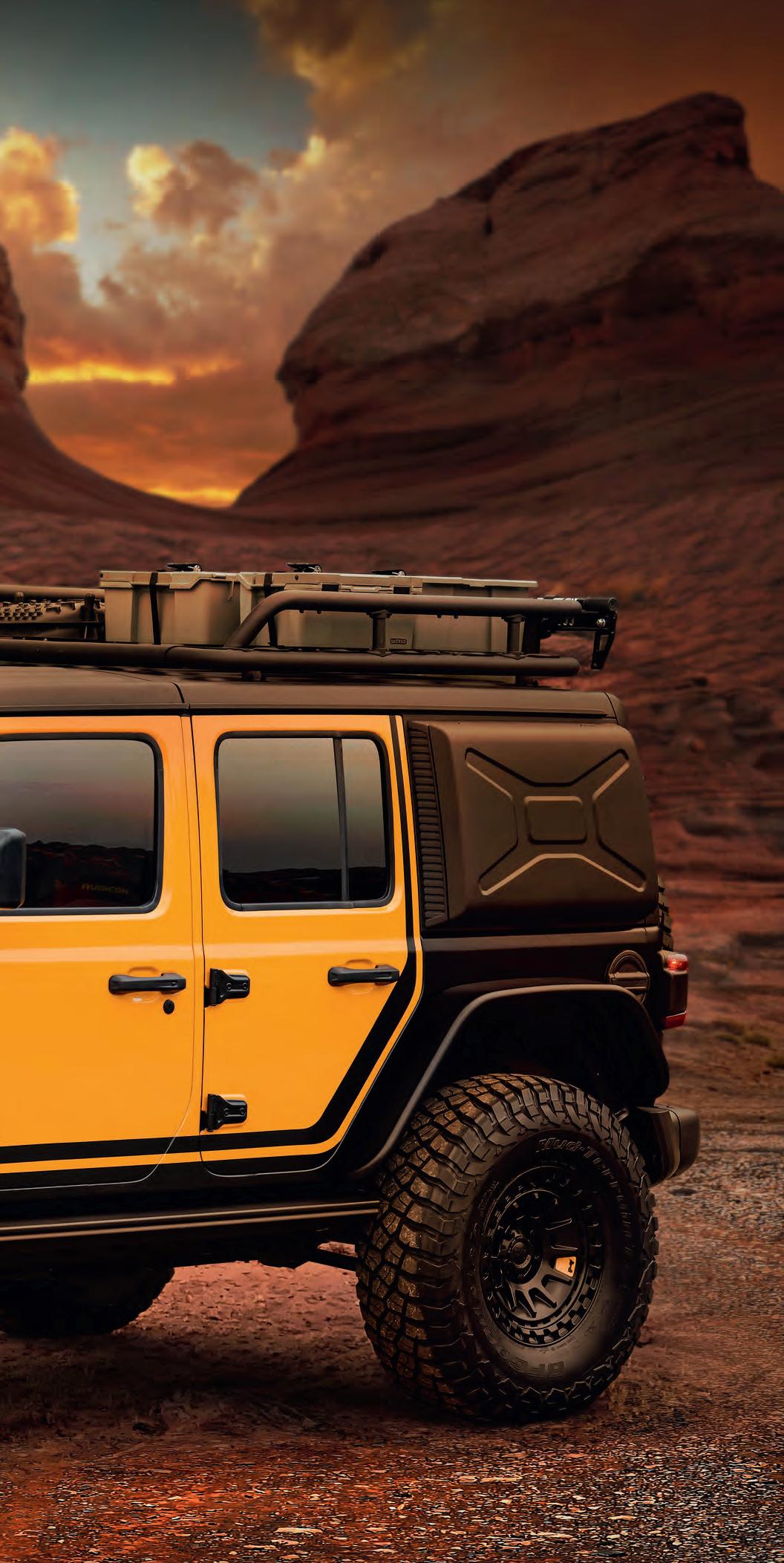
Off-roading is something we associate with mud and water, grey skies and rain. That’s because we live in Britain, obviously. In Australia, you associate it with sand, dust and sunshine so hot you can hear it; in Scandinavia, it’s likely to feature snow and ice; in parts of Africa, the first thing you’re apt to think of is stuck lorries; and back here in Britain, of course, it’s people trying to stop you.
There are those parts of the world where off-roading really is still associated with freedom. Not just freedom to roam but freedom to do so under a warm, balmy sun that lights up the world around you like it lights up your mood. This is often a version of off-roading that’s not very hardcore –though if you’re enjoying that freedom amid a landscape of towering rock outcrops, it’s better to go prepared.
Hence the Jeep Wrangler 4xe Rubicon Sunchaser. One of the concept vehicles exhibited at this year’s Easter Safari in Moab, this is a 5-door model accessorised into ‘the ultimate outdoor adventurer.’ It has the 4xe plug-in hybrid engine, which we don’t get here in Britain, but otherwise there’s no reason why you couldn’t build something very similar with nothing more specialised than a set of spanners and a credit card. Not in that order.
Jeep does say that ‘several conceptual exterior components highlight the extreme functionality of the most capable off-road vehicle on the planet.’ We’re fairly sure this simply means it has lots of accessories, but you could put your own twist on it anyway. And besides, who doesn’t love a brightly coloured Jeep?
The colour, on that subject, is called Solar Flash. It contrasts with a satin black used for the detailing to give the vehicle a look that’s almost reminiscent of a 1960s’ custom car in places.
Foremost among the ‘conceptual exterior components’ is a set of 37” BFGoodrich KM3 Mud-Terrains. These are tucked away beneath a set of concept vented high-top steel wheelarch extensions, which combine with a 2.0-inch suspension lift to make room for them.
Should the resulting ground clearance not be enough, the sills are protected by a set of rock rails. Up front, meanwhile, a Warn
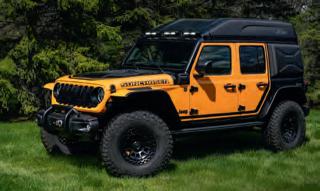
A FEW WEEKS AFTER MAKING ITS DEBUT, the Sunchaser was back out for Overland Expo West in Flagstaff, Arizona – where it showed off Jeep’s Awning and Rooftop Tent (ARTT) concept. Created in partnership with Dometic, this is ‘a premium, lightweight, low-profile, all-in-one awning and rooftop tent system that seamlessly integrates with the Jeep Wrangler.’
The ARTT is housed within a carbonfibre shell whose aerodynamic design and light weight helps minimise its effect on the Wrangler’s dynamics. In particular, Jeep says the tent can be attached directly to the vehicle’s roof, meaning there’s no need to mount it on a roof rack. It’s not a typical hard-shell design, however, as its tailormade cover effectively becomes a new roof for the vehicle with its full-length, full-width proportions. The short rack mounted on the vehicle at Moab was removed to make way.
Once opened, using manufacturer Dometic’s air inflation technology, the tent
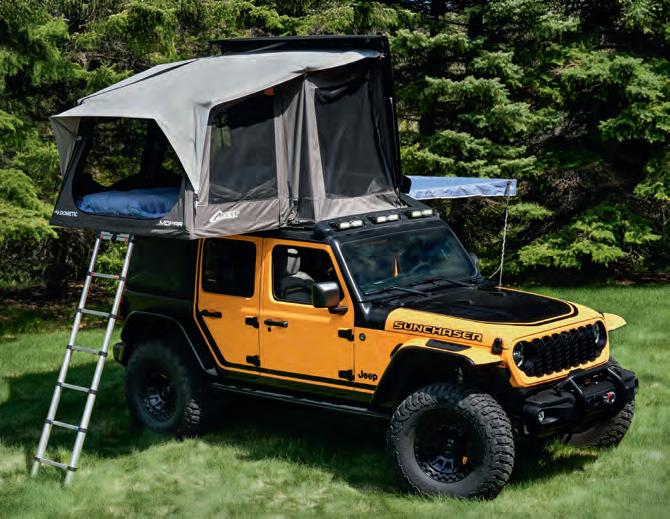
extends out to the vehicle’s right, where an external ladder acts as a prop in the familiar way. Opposite and behind it, a 270-degree awning folds out on extending arms to shade the areas to the left and rear of the vehicle so that having successfully chased the sun, you can also successfully hide from it. The cantilever arms carry LED strip lights, too, for when the sun gets its revenge and starts hiding from you instead.
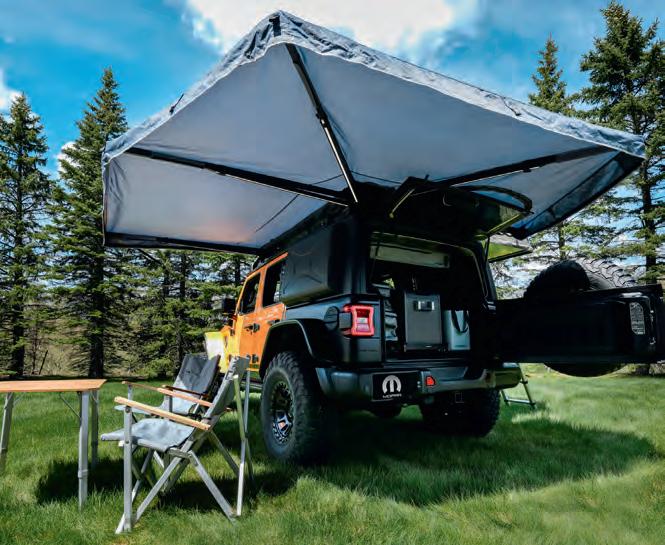
In addition to the ladder, the ARTT’s design makes full use of the fact that the Wrangler has two lift-out Freedom panels in its roof above the front seats. If you don’t want to take the approved form of access – perhaps if your sun chasing has ended up with you being chased by rain, a carbon fibre interior step allows you to climb up into the sleeping area from within the vehicle, gaining access to the integral queen-size mattress without having to concern yourself with what’s going on outside.
‘The lightweight and compact JPP Awning and Rooftop Tent concept is the perfect accessory for adventure-seeking Jeep Wrangler owners, whether they are overlanding across long distances or decide to go on a spur-of-the-moment quick weekend getaway,’ said Jeep bigwig Mike Koval. Certainly, with this unit available the Wrangler starts to look like a better choice for expedition travel than ever before.
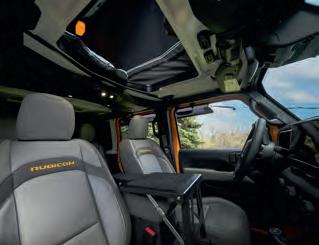
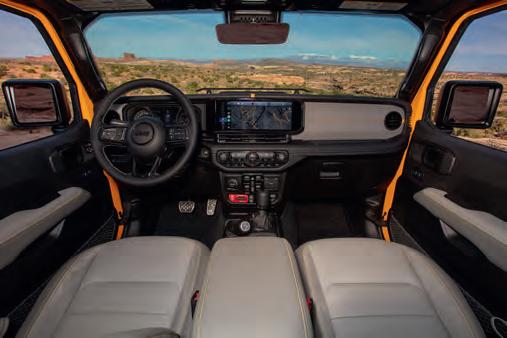
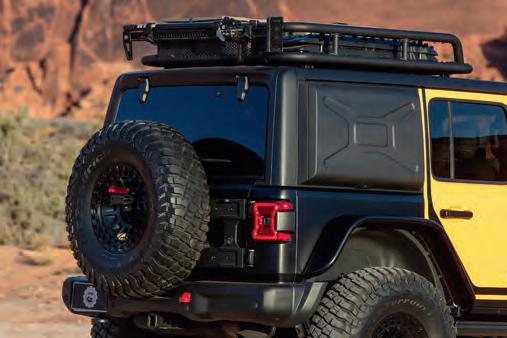
It doesn’t look hugely non-standard, which is mainly because it’s not. But the Sunchaser’s cabin features an extended two-tone leather package covering the seats, dash panel and door armrests. Trim pieces are painted gloss black and there are all-weather mats down below. On the roof, the vehicle ups its practicality game with a tubular rack – below which, both sides are home to storage pods with integrated Molle panels
winch is housed within an unusual tubular cage upon a custom front bumper.
At the top of the windscreen is a Mopar Illuminat3 pivoting light bar with three pods of two LED arrays. There’s a roof rack behind it, then down below this is a pair of concept side storage boxes with integrated Molle panels. Could it be that they got the idea from the new-shape Defender? Either way, Jeep’s do look slightly less like they would be vulnerable to getting smashed off by a tree first time you take the vehicle off-roading in even slightly typical British conditions.
Not that this is Britain. This is Utah, where chasing the sun is what we do. In this case, we do it on custom two-tone leather seats and all-weather mats. Trim pieces around the interior are painted gloss black and in addition to additional leather wrapping elsewhere, the cabin also contains a multi-accessory rail.
Most important of all, this is a Rubicon model. So it already has heavy-duty axles, locking diffs, a disconnecting front anti-roll bar and so on. We’ve said many times before that this is the most capable off-thepeg off-roader in existence, and we’re yet to
see anything to make us change out minds. The fact that it’s built to be modified and comes with factory support for up to 40” tyres only adds to the impression.
The Sunchaser is far from the most extreme concept Jeep showed off at Moab this year. It is, however, a good example of where you can take a Wrangler with comparatively little effort or investment. It’s got family car vibes mixed with serious adventure cred – and most of all, it looks great. What better way to go chasing the sun than in a truck that looks like you’ve brought the sun to you?
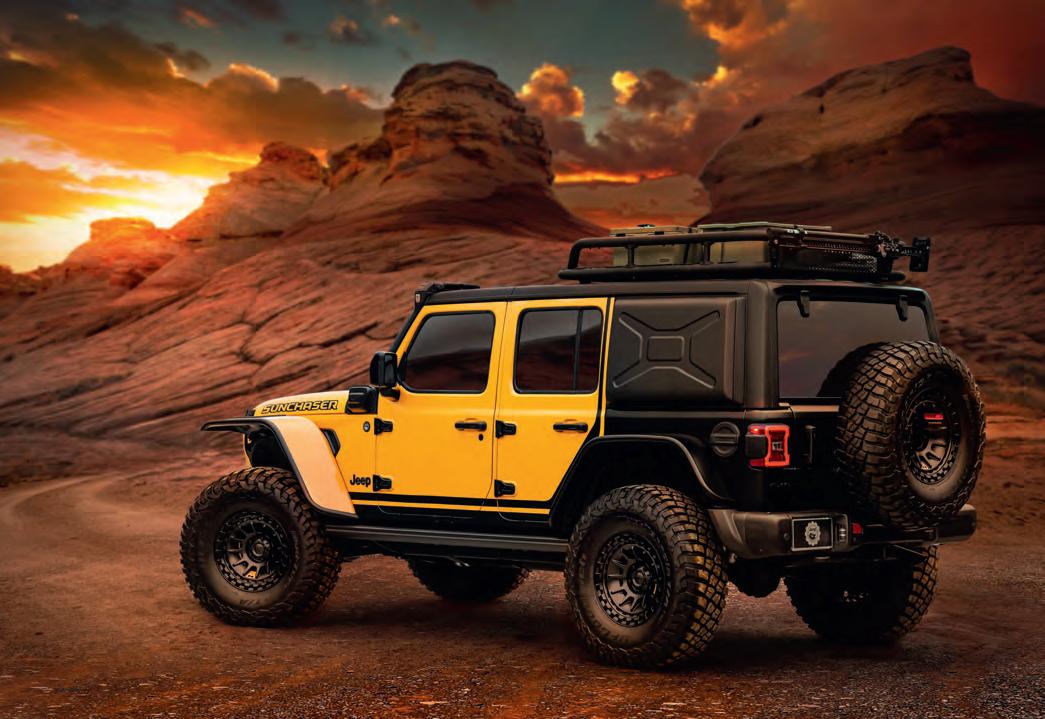

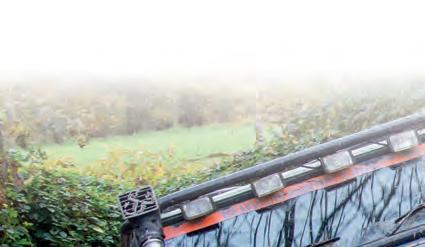
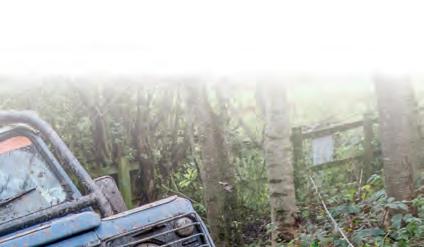

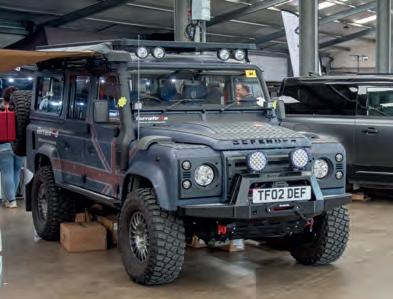

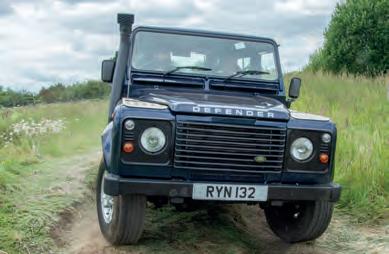











Land Rovers are returning to Newark Showground this August for a day filled with Land Rovers!
Exhibitors old and new will join us, selling everything from parts & accessories to tyres, clothing and toys Talk to overland adventure specialists about your next trip, discuss modification options with companies with the know-how and other experienced Land Rover owners.

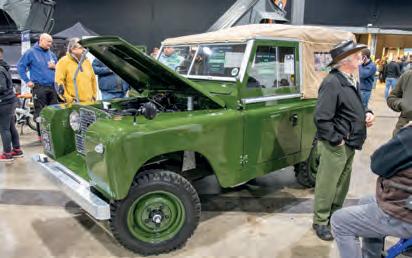
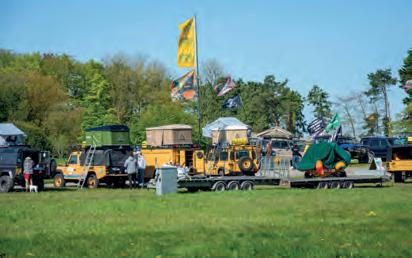
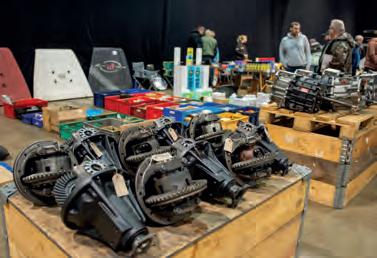
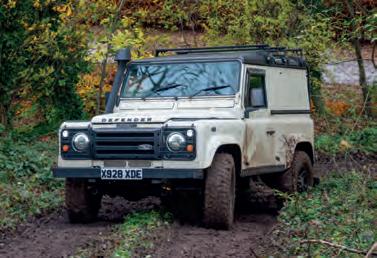
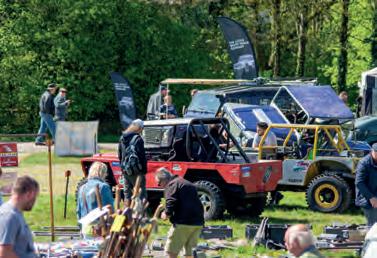


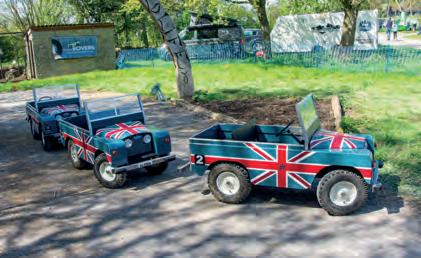















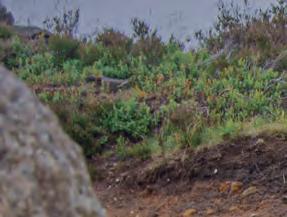

As we all know, age is just a number when it comes to Defenders – so when you find one that’s been rebuilt as thoroughly as this 1986 90, it might as well be brand new. And there’s another number behind it, too – the number 57, with a letter M before it, which marks this out as a Land Rover which, like so many, is now powered by BMW’s legendary diesel engine
Words Tom Alderney Pictures Richard Hair

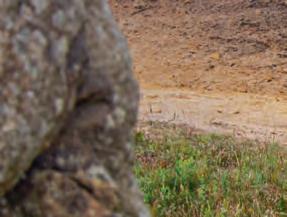













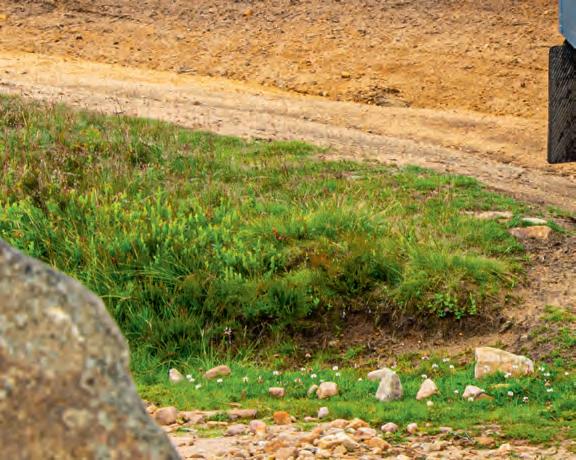
As we all know, age is just a number when it comes to Land Rovers. So when you see one that’s knocking on for 40 years old, it’s probably going to live a lot longer than cars being built right now.
Eliot Kimpton’s 90 is a case in point. It came off the production line in 1986 and we’re guessing it started life in the defence of the realm, because it was first registered with the DVLA in 1999.


then had an engine swap. Which, sure enough, it has.








If our assumption is correct, that would put it as the kind of Defender that had a 2.5-litre nat-asp diesel. Which in turn would put it as the kind of Defender that has since




During the 80s and 90s, various Japanese engines came in and out of fashion in the repower game. Ultimately, however, as thousands of Mk1 Discoverys rusted themselves into oblivion, Land Rover’s own 200 and 300 Tdi came to the fore – to the extent that it’s quite rare to find an early 90 or 110 that hasn’t had one. Unless it’s had two, obviously. If you don’t know somebody who’s bought one off eBay and thrown it in their truck only to discover that it’s a lump of scrap, you don’t know enough people.

Anyway, we digress. Eliot bought the vehicle a few years back, as a project –though unlike most projects, it had already come out of a professional workshop with some extremely major work having been done to it.
The workshop in question was the home of MW Machines, which specialises in engine conversions using the latter-day legend that is BMW’s M57 diesel. The Warrington-based company does kits for other vehicles too, but the Defender is very much its focus.
This particular 90 was more than just a kit. And more than just an engine, too.




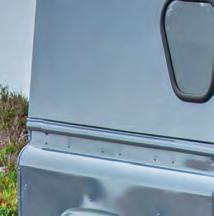









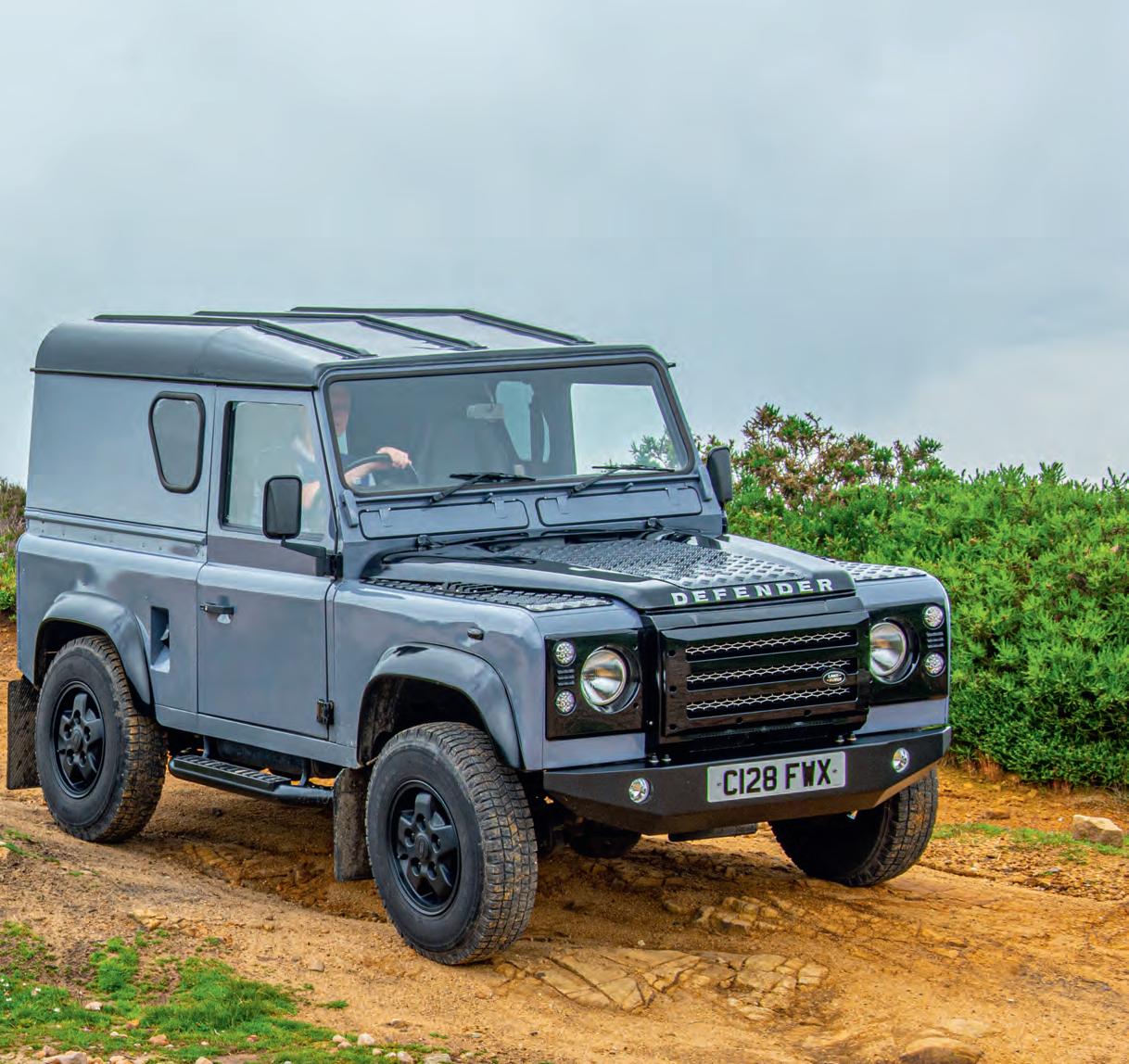

MW Machines rebuilt it on the chassis from a Td5 model dating from 2002, which was Raptor sealed before the vehicle started going back together.
As it did, in went an M57 dating from 2004. This can be fitted in one of two ways: directly to Land Rover’s R380 gearbox or, if you want an automatic, complete with BMW’s ZF6 HP six-speed unit which then mates to the LT230 transfer case.
This one is the latter, and Eliot reckons it has averaged 30mpg since he bought it. He gives the engine a new oil filter every 3000

miles and has also changed the turbo, fuel pump, alternator, oil cooler and water pump since he bought the vehicle; on top of a full overhaul at MW Machines prior to fitting, this is one very well looked after diesel. ‘The engine is marvellous,’ says Eliot. ‘For me, it will go for another 100,000 miles with only oil changes.’
Further down the drivetrain, a new set of propshafts turn the original axle at the front and, cos disc brakes, a Discovery unit at the rear. So yes, age is very much just a number – which is exactly how Eliot wanted it, having chosen this particular 90 on the basis that in a few short years’ time,
it’ll become a classic car in the eyes of the DLVA, qualifying for free road tax and no longer needing an MOT.
You’re screaming ‘substantial changes’ at the top of your voice right now. And for sure, a vehicle built on a later chassis, a higher-capacity engine with more cylinders, an auto gearbox instead of a manual and a more modern back axle is going to be a big ask to get past that one. You could argue that the BMW engine and box make it more efficient, the chassis was necessary to preserve it and the disc-braked axle makes it safer, and actually all these things are true… Just don’t, er, not realise that you




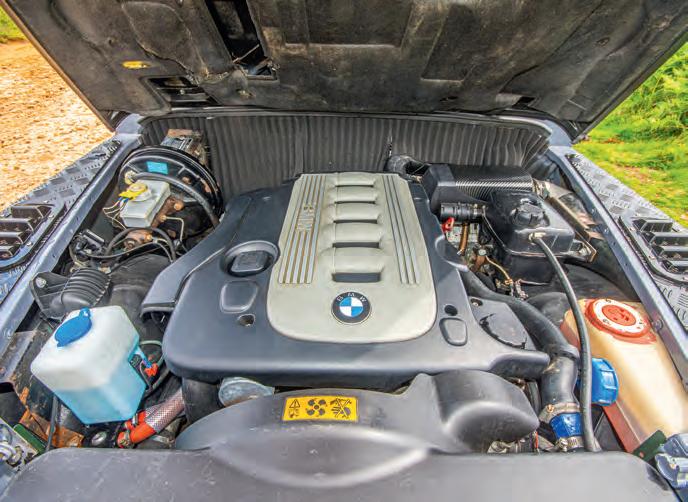
were meant to disclose all this stuff when registering it as a historic. Not that anyone would ever think of doing such a thing. So, anyway. With all this in mind, Eliot wanted something with all the right stuff down below but which he could treat as a blank canvas up top. ‘When I got the Defender,’ he says, ‘the shell was old and tired and that is what I wanted. I wanted to
completely renovate a Defender and make it drive like a modern car. One of my life goals!’
The potential was definitely there. It wasn’t just the shell that was tired when Eliot bought the 90. ‘The doors were falling off,’ he adds, which sounds fairly bad. He replaced them with three brand new ones
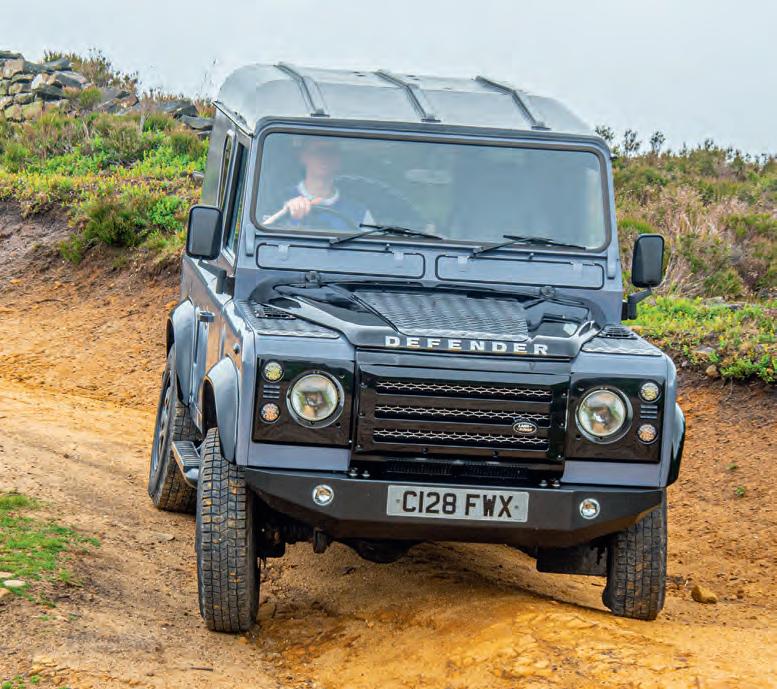
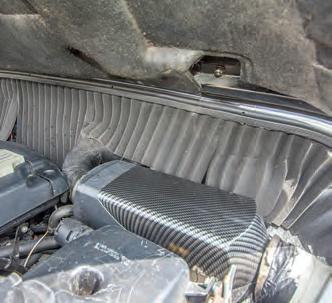
Warrington-based MW Machines specialises in BMW M57 engine conversions, and this is one which the company installed itself. Dating from 2004, it went in complete with its original ZF6 HP six-speed automatic gearbox, though if you prefer your Defenders traditional it can also be fitted to the front of Land Rover’s own R380 manual
bought as Genuine Parts from Land Rover itself (that thing you can hear is your wallet begging for mercy) then had the vehicle resprayed in Stealth Grey and Piano Black. He’s also added a variety of cool stuff in the shape of Fire and Ice side steps, an RDX front bumper and grille, custom rear side glass and a black tinted rear window. All the lights, including the headlamps, have been changed to Wipac LEDs. All this has been achieved without making it look like a lost-cause bling machine; rather than something outrageously low-profile, the vehicle wears a set of black Disco alloys by summer and Wolf rims with large mudterrains in the winter.
Inside, it’s not a loadsamoney leather and chrome job – but it is unique. Eliot’s own design of 3D-printed dash sees to that. You also don’t see many 90s with Toyota MR2 seats but he reckons they do the job perfectly, leaving plenty of leg room even for a six-footer.
You might notice a full set of black carpets and matching roof lining, too. But it’s what you don’t notice that makes the difference – to wit, £1000’s worth of Dynamat soundproofing applied everywhere it’s capable of going, as well as acoustic foam to add further to the vehicle’s refinement.
That’s no small amount to pump into the creature comforts fund, but there’s more. And this one really is good. ‘I removed the useless Defender heating system,’ says
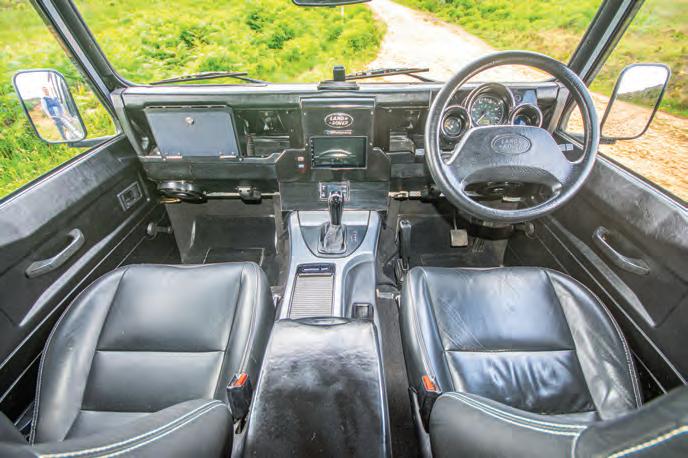
Eliot. ‘Anyone who knows Defenders knows it never works properly.
‘I’ve fitted a diesel heater, plumbed into the car vent system, with a control panel in the cab plus a remote so I can operate it from inside my house on cold days to get it warm for entry. There’s a separate red diesel tank for this to save money.’
Further clever stuff includes the aforementioned dash, which is home to dials from a Td5 and a speedo conversion to a digital reader rather than a cable. There’s also a full Android TV system – though this
was fitted mainly as it provided an in-car OBD reader for the aforementioned digital dials, as well as allowing full diagnostic access to the BMW engine.
The upshot of all this has been to create a 90 that’s eye-catching and cool but not such a self-conscious style wagon that you’d be scared to take it off-road. We all know about the sort of Defenders that end up looking so fancy that there’s no sense of purpose left to them, but even with its sportscar seats and extraordinarily unusual electronics this one still has a feeling of
There are many, many Defenders with non-standard cabins, but only one with a dashboard designed by Eliot himself and made using a 3D printer. Toyota MR2 seats are quite rare, too, as are the black carpet and headlining you can just about see here, but beyond the ZF auto shifter on the floor console (yes, it’s a Defender with a floor console) another unique item is an Android TV media system with an OBD reader for digital dials and engine diagnostics
readiness to it that says it’ll do all the things a Land Rover is meant to.
And with a new, fully Raptored chassis beneath it and one of the world’s best ever diesel engines under its bonnet, it’s set fair to keep on doing those things way into the future. Another 100,000 miles on its current BMW unit sounds as reasonable as it comes – and that’s just for starters. It hasn’t been turned into something it’s not, but this is a perfect example of a Defender being what it always was: immortal. Age is, remember, just a number.
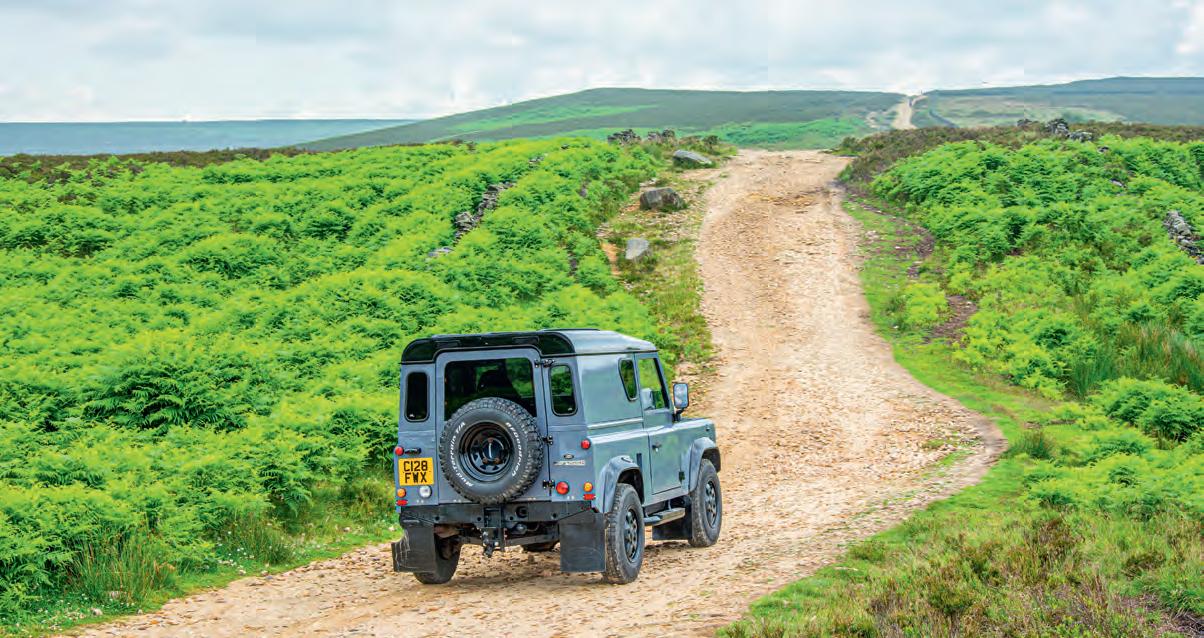





Words and Pictures: Chris Collard


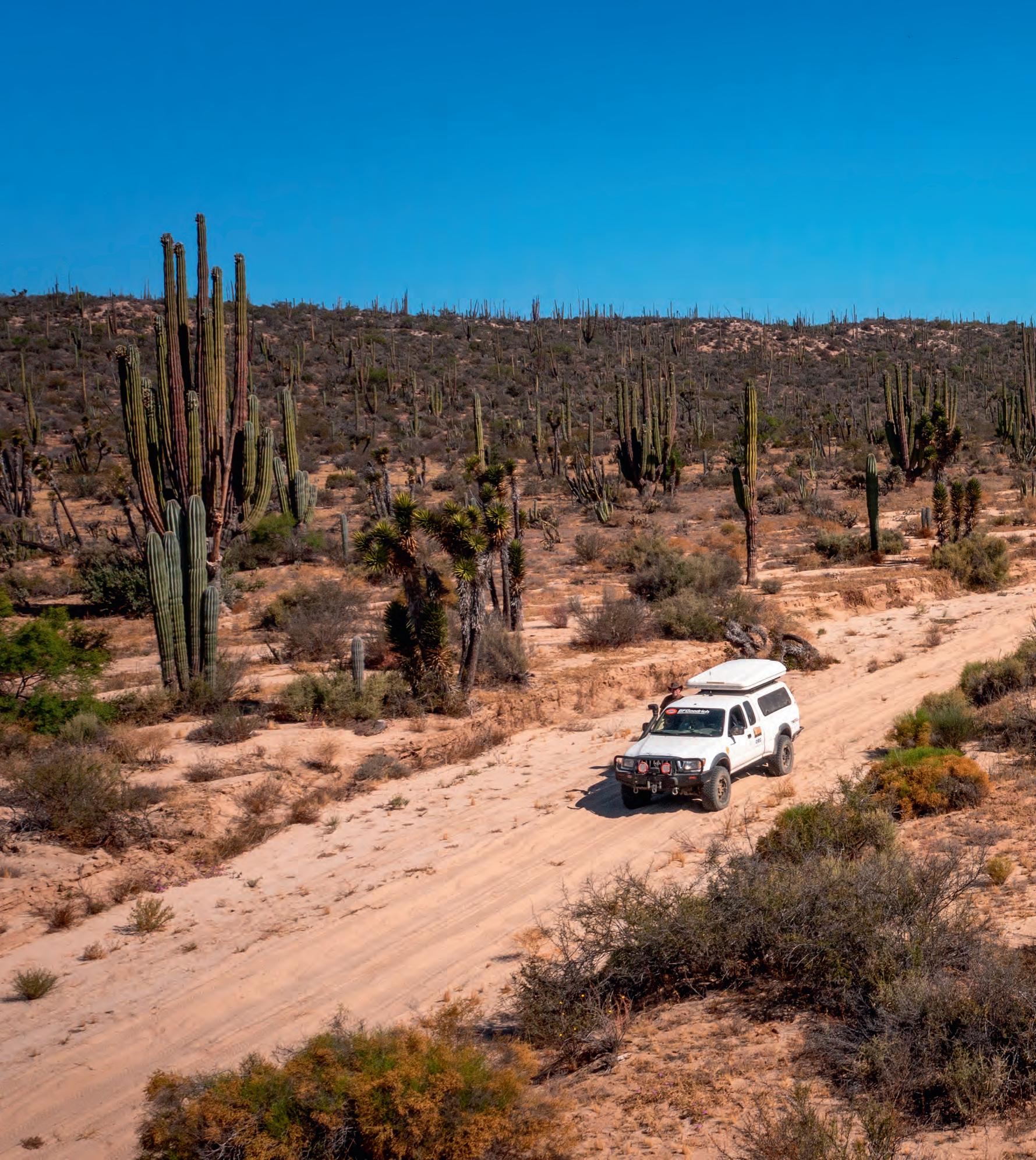
I’m an idiot. These are the words that consumed my thoughts as I glanced at my wife Suzy, a raised-eyebrow kinda ‘oh crap’ grimace on my mug. We were mid-span on a two-week exploration of the Baja peninsula and had been running up

Tales of overland wanderlust from the deserts, mountains and coastal wilderness of Mexico’s La Frontera – the fabled Baja Peninsula




an established track over an estuarial salt flat between Punta Abreojos and Bocana. I’d veered right as the path split and it was taking us back to the newly paved road. Rather than backtracking, I decided on a direct route across the playa: Mistake #1.

Our tyres were still at street pressure from the run up from San Ignacio: Mistake #2. And I was in high range: Mistake #3. Tidal salt flats can be tricky. Well established tracks are usually firm but everything around them, while appearing













dry, can consist of a thin crust over a bottomless abyss of saline goo. And sure enough, down we went into the quagmire. The sun was heading for the horizon and, oh yes, we were traveling solo: Mistake #4. I’m an idiot.
Ten days earlier, we had turned north from San Jose del Cabo on the East Cape. Having just guided a trip on the mainland for the Sonora Rally and raced the NORRA Mexican 1000 vintage rally, I was ready for some R&R.

This wasn’t my first rodeo in La Frontera, Mexico’s frontier state. I’d been travelling here since I was a kid in the early ‘70s with my folks and zig-zagged its length dozens of times. But the Baja spans nearly 800 miles from Tijuana to Land’s End and there
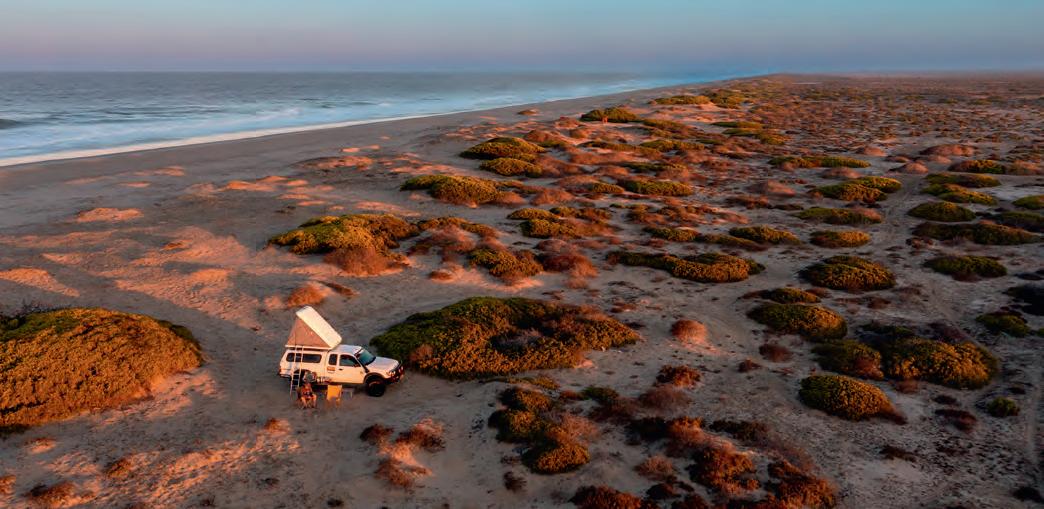
were still hidden gems yet discovered. Our goal was to search them out.
We departed the paved road in Todos Santos, home to the famed Hotel California. Though the Eagles insist there is no connection to their song, if you arrive at night with a cool wind in your hair, the hotel’s shimmering light at the end of a dark desert highway will certainly prompt you to check in and dance in the courtyard.
The once-sleepy town has become popular with the Cabo Wabo crowd, but its roots date back to 1733 and Padre Jaime Bravo’s founding of Misión Santa Rosa de las Palmas. Originally home to
the Guaycura people, a nearby spring allowed the missionaries to develop a thriving sugar cane industry. Tragically, the Guaycura, who had occupied the land for thousands of years, did not survive the European invasion and the diseases it introduced. The mission and one of the original cane mills remain, and are worth visiting if you don’t mind wading past the new yoga retreats and art galleries.
Following the coastline, the plan was to intersect Mex 1, the singular paved road transecting the peninsula, 140 miles to the north near Ciudad Insurgentes. This is a land of ranchos de vacas and
campamentos de pesca (cattle ranches and fish camps) and, as is the case in most of Baja, they are interlaced by a web of two-tracks.
The vaqueros and pescadoras did not land here by accident. Many of their ancestors were soldiers assigned to protect Jesuits and Franciscans during the development of California’s mission system. When they retired, the Spanish and later Mexican government enticed many to stay with the offer of free land. Grants were typically two leagues (14 square miles) and provided permanent, unencumbered rights in return for building
Below left: Miles from the nearest town or fish camp, lonely memorials mark the resting place of many of Baja’s ranchers. There’s nothing to mark the spot where the last of the Guaycura died, though; having lived on the land around Todos Santos for thousands of years, they were wiped out by diseases brought in by the European settlers
Bottom left: There are loads of rattlesnakes in Baja. This was a particularly big one, but safe to say none of them just want a cuddle
Relow right: Though we do use GPS, ditching it in favour of a traditional paper map brings us back to our earlier days Baja meanderings. In this case, it’s probably safe to say that the track is that thing pointing dead ahead…


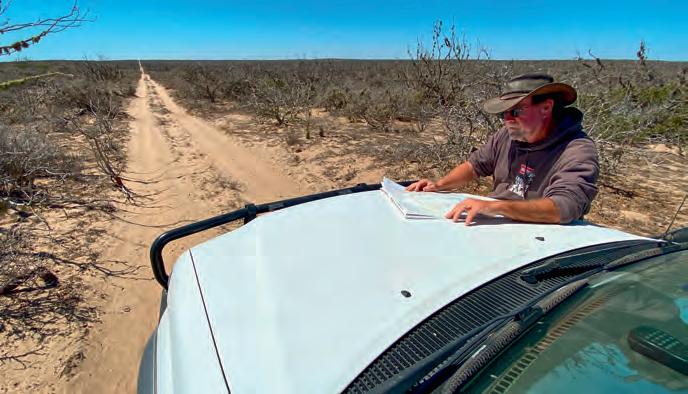

a stone structure and maintaining 2000 head of cattle.
While the fishing industry was limited to local markets, a global demand for leather summoned tall-masted sailing ships from around the globe. Anchored offshore, they would offload commodities such as textiles, steel products and trinkets. Once empty, they stuffed their hulls with dried cow hides bound for the leather factories.
Although I’ve never had a security issue in my 30-plus years of travelling in Baja, my standard practice is to camp out of sight from any road – even one with zero traffic. Meandering through the salt grass and dunes, we found a sandy clearing near the beach, popped up the roof tent and set in for a spectacular tequila sunset.
In the morning, we zigged and zagged through abandoned ranchos, along razor-
Below: Although Baja is mostly an arid desert, there are a surprising number of natural springs in its backcountry

Left: Good overlanding practice is to locate a good camp, collect wood for a fire and have dinner on the grill an hour before dark
Above: Taking time to meet the peninsula’s people is one of the most rewarding aspects of travelling anywhere, Baja included. The authors just asked Leonel for directions, but they ended up being invited to visit his home (which was half an hour away) and meet his family
edged dunes and past well weathered shrines forgotten by the world, and were delayed by vaca-jams (stubborn cattle crossing the track). Rattlesnakes are common in Baja, and we came across a big daddy of about four feet in length –one of the largest I’ve seen. We also saw



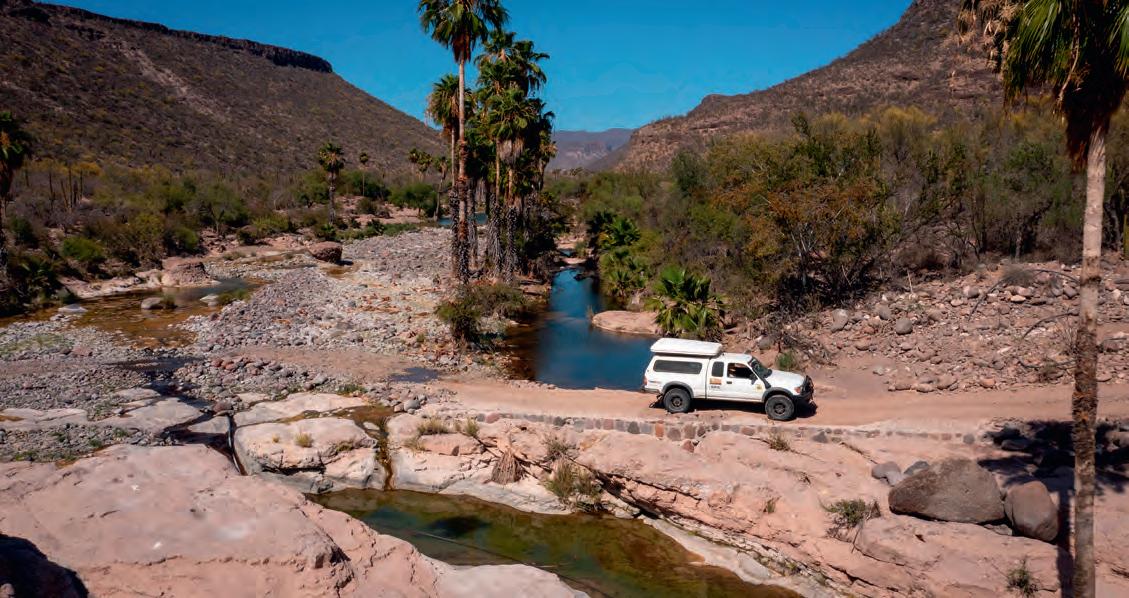
bobcat, badger, deer, fox, eagles, osprey, you name it. The desert was alive.
Years ago, while exploring the Sierra La Giganta Reserve between La Paz and Loreto, we found a hidden track to one of my favorite playas. The normal route can be traversed by any four-wheel drive, but the pescadores do it in clapped out two-wheel drive pickups… as fishermen will do. But the back way (our way) is much less direct and sees little traffic. A section had been washed out by a hurricane a few years back, and while the locals had shored it up the best they could, there remained a sketchy side-hill spot with an
80-foot drop to one side. We walked it first, and determined our Toyota Tacoma would be fine. If we were in a high-profile van, it would have been a five-point turn and a long drive back to the highway.
Tucked into the cliffs along the Sea of Cortez, this gem is the kind of place where one can kick back and spend countless days exploring. We greeted Jose, the caretaker, and settled into mañana mode.
Mañana mañana is a Baja mindset, meaning something might happen today or it might happen tomorrow… or the next day. Chill out, have a cerveza fria (cold beer), don’t worry about it.
The bay is a popular anchorage for sailors, and snorkelling its translucent
blue water is like slipping into a marine aquarium. You might see yellowtail, rockfish, rays, starfish, sea anemones and the occasional whale or whale shark. We made our way over to the village (population 208) one afternoon for lunch at the local palapa restaurant (the only restaurant). On the menu were tacos de pescado and tacos de pescado (fish tacos). Get it? The catch of the morning is what’s on the menu. We ordered the special and a few rounds of cold Pacificos.
Before I go on, you might be wondering why I haven’t provided a name for the paradise I’m describing. Well, my wanderlust friends, if there is one thing I’ve learned in my years of Baja meandering,
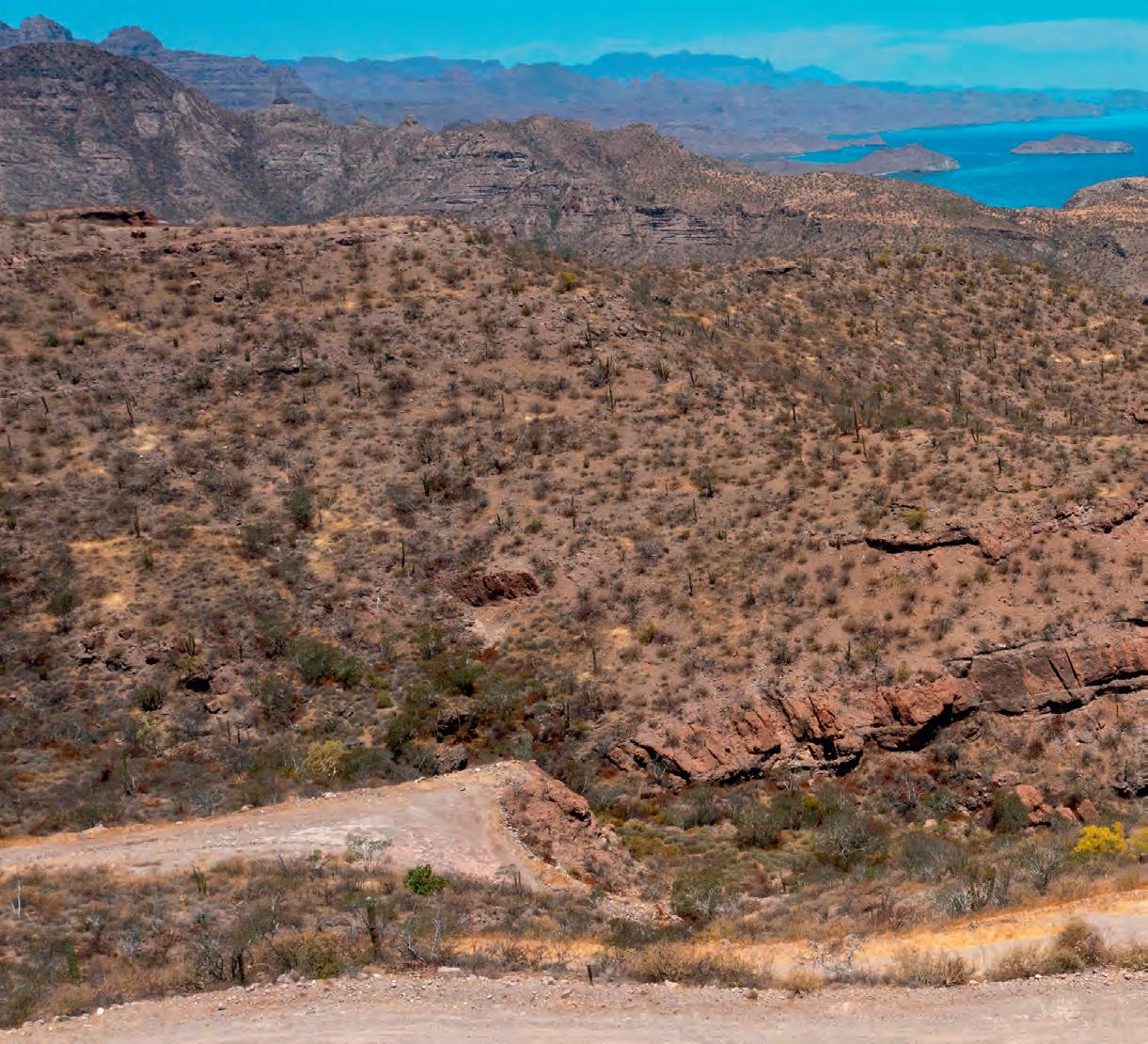
it is that the most rewarding element is finding these treasures on your own. Stow your GPS, buy the Baja Almanac (yes, a paper map), stop and ask the locals about beaches, historic ruins and missions, and be willing to turn left, right or centre. Time is the traveller’s friend. Mañana mañana.
Always in search of the path less travelled, I had heard rumors of an alternate road to Misión San Javier. Scanning the atlas, we located a thin serpentine line from Mex 1 toward the general vicinity of San Javier. After a bit of searching, we found an obscure two-track and followed its rocky switchbacks over a mountain saddle and
into a land seldom seen by outsiders. A forest of cardon cacti blanketed the valley, and the valley after that.
This is a highly mountainous region, and seldom is there a direct route from A to B. After several hours of heading 180 degrees off our intended destination, and exploring half a dozen dead-end side routes, we turned tail and found a riverbed camp about 10 miles back. Pulling out the atlas the next morning, we determined that if there indeed was a trail to San Javier, this had to be it. We were down to a quarter tank but had 10 gallons in jerry cans.
Around midday, we began passing the occasional rancho and seeing recent tyre tracks – a good sign. Stopping at
a palm-lined creek to fuel up, we met a young man, Leonel, coming the other way on a motorcycle. Offering him a Coke and asking about the area, he confirmed we were on the right path and shared that his extended family had five ranchos in the area. One grew vegetables, another tended cattle and his family raised cabras (goats) and made cheese. Something of a family co-op, they gathered each Sunday to share their bounty.
Leonel asked if we would like to visit his family’s rancho, and we followed him for about 30 minutes to the end of the canyon. We were greeted by his parents and younger sister, Jasmine, and given a tour of the grounds. They had recently
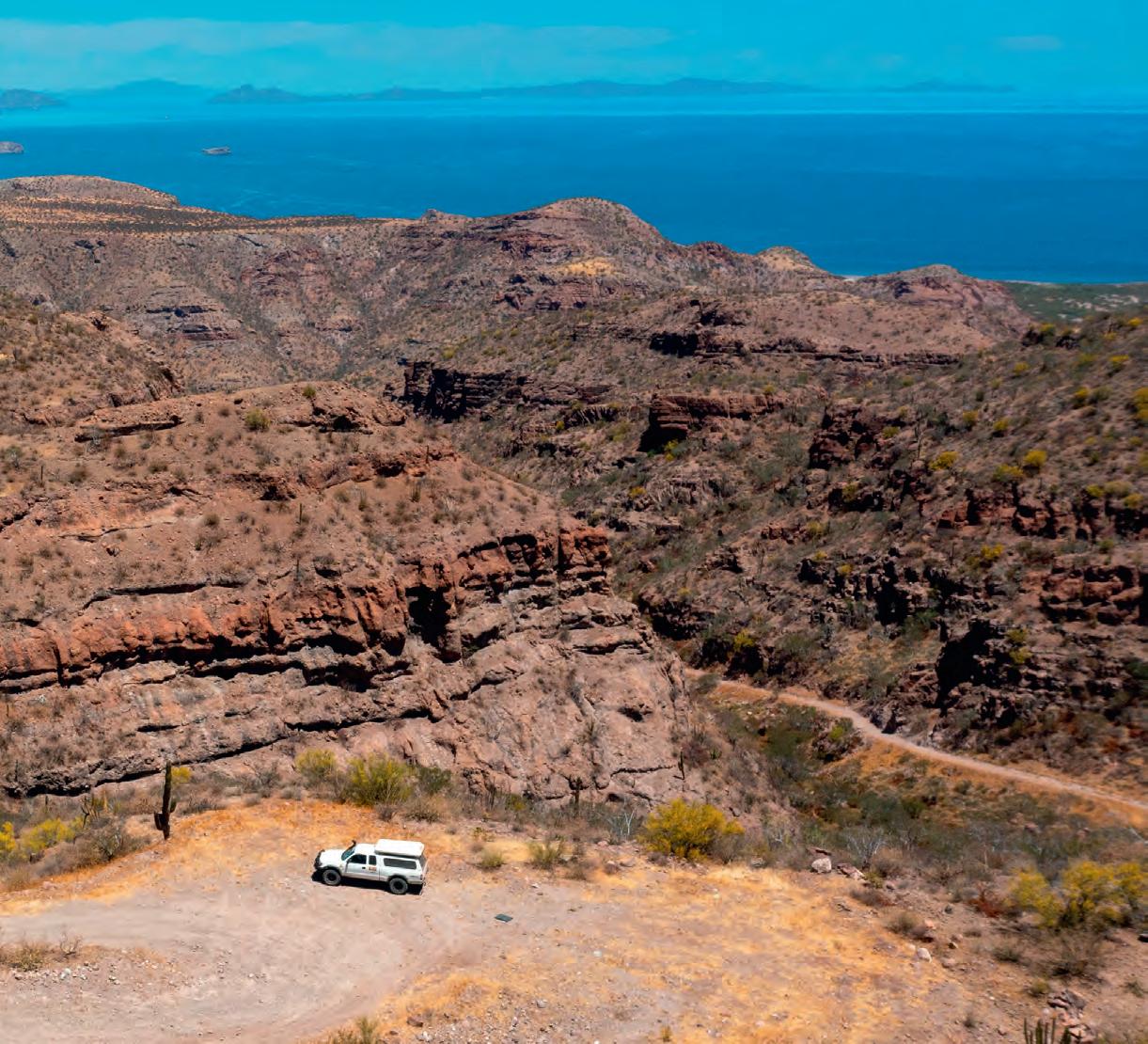

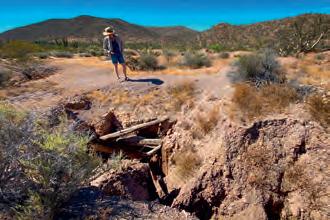

Left: Mision San Javier, established by the Jesuits in 1699, is one of the best-preserved missions on the peninsula
Centre: Tucked into Baja’s interesting chronicles is its gold rush, which left the peninsula peppered with open mine shafts and relics
Right: If there was a market for seashells, Baja would be rolling in the dinero. This sandy beach turned out to be covered with millions of clam shells
installed a solar panel system to power lights, the well, television and satellite dish, and Jasmine was excited to add us on Instagram. His mother Francisca taught Suzy how to press hand-made tortillas, which she served with sliced queso de cabra (goat cheese) while Leonel played his guitar and sang Spanish classics.
I’ve heard people say ‘I did Baja’ or ‘I conquered Baja.’ They may have driven through, but I’m guessing they didn’t experience it like this. Baja is not something you ‘do’ or ‘conquer.’ Rather, when you try to become part of it, appreciate its nuances and get to know its people, this is when Baja becomes a magical place. We said our goodbyes and headed for San Javier with a gift of queso de cabra in the cooler.
After Hernán Cortés’ failed attempts to colonise California in the 1530s, the peninsula sat relatively untouched for the next 150 years. But in 1697, Jesuit Padre Father Juan María de Salvatierra, under direction of the Spanish Crown, laid the cornerstone of Misión de Nuestra Señora de Loreto. Misión San Javier followed in 1699, its ample water and higher elevation providing the ideal environment for raising crops. This is one of the best-preserved in the chain of Catholic missions spanning the peninsula, and stepping through its weathered wood doors is like entering a time portal. Whitewashed stone walls rise to a vaulted dome ceiling, rustic pews guide worshipers through the nave to a grand altar and dusty confessionals wait at
the ready to provide forgiveness. Though decommissioned in 1817, it continues to serve locally as a place of worship.
After a night of respite (room, shower and swim-up bar at Mulegé’s Hotel Serenidad – circa 1960 and highly recommended) – we veered west toward the Pacific to find a track to Bahia Tortuga I remembered doing back in the 90s.
Crap… I’m an idiot. We’re back here again. The truck had sunk to within a few inches of the frame, we were alone, it would be dark soon and I probably had one good shot at getting unstuck. Grabbing a gauge, I dropped pressure to 6psi, shovelled out around the tyres and jammed my single

pair of MaxTrax under the rear. The front received some old floormats, fishing rope and anything else we could find. ‘Why didn’t I bring my second set of MaxTrax,’ I thought. ‘I’m an idiot.’
Easing back in reverse, we moved about six feet and sunk, the frame now closer to the goo. We repeated the drill several times and as the sun kissed the horizon, I admitted to myself that it might be a long night encased in this saline tomb.
I’m a firm believer in karma, though. And I have stopped to help many souls in need. Paying it forward is what travellers do, and sometimes your good deeds are reciprocated by total strangers.
We had seen a pickup pass on the highway earlier, and in our time of need it reappeared. Making its way down to the salt flat, it stopped and an angel stepped out. Necesitas ayuda? Maybe I said a silent prayer at San Javier, but whatever the case Eduardo (the Police Chief in the next village) was ready to pull us to safety.
Scraping mud off my arms, I shook his hand and thanked him profusely, and he drove off into the sunset. We found a camp for the night along another inlet, sans mud, and in the morning scraped several hundred pounds off the undercarriage. Better lucky than good, sometimes!
We were just three days from the realities of work now, and with 600 miles

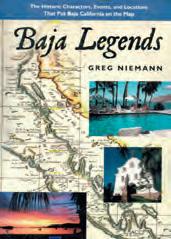






Greg Neiman’s Baja Legends is a wonderful compilation of local lore and history. Steinbeck’s The Log from the Sea of Cortez paints a picture of Baja before the onslaught of tourism. For an in-depth study of Amerindian art, Harry W. Crosby’s The Cave Paintings of Baja California is the authoritative source. And finally Baja California, Land of Missions by David Kier is excellent.
between us and the border it was time to make tracks north. But chance was still smiling upon us. Pulling into one of our old haunts in Bahia Gonzaga, Suzy noticed people waving us down.
Sitting at a taco stand were our friends Michael Emery (of Slow Baja fame) and Tim and Kelsey Huber of Dirt Sunrise. Nearly two weeks after tipping coldies at the NORRA awards banquet, we bump
Estuarial salt flats are often used for local transport between fishing villages. They can be treacherous, though…
into each other at a taco stand 700 miles away! We spent our last night camped on the beach, spinning yarns of lore and chilling out with our buddy El Pacifico and the honorable Señor Don Julio. Such is life in Baja. Mañana mañana.


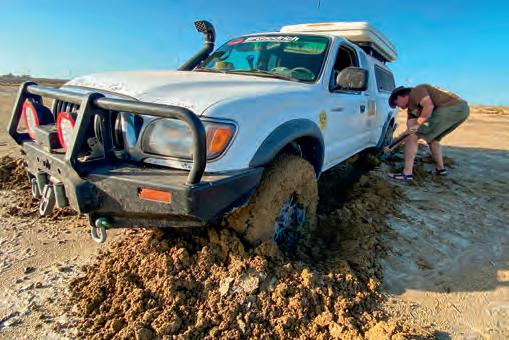


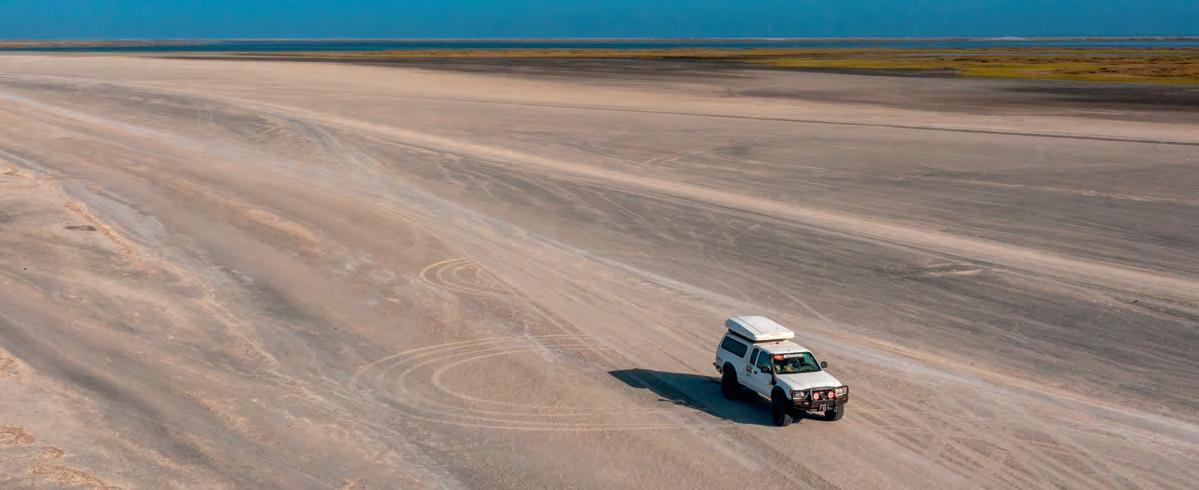
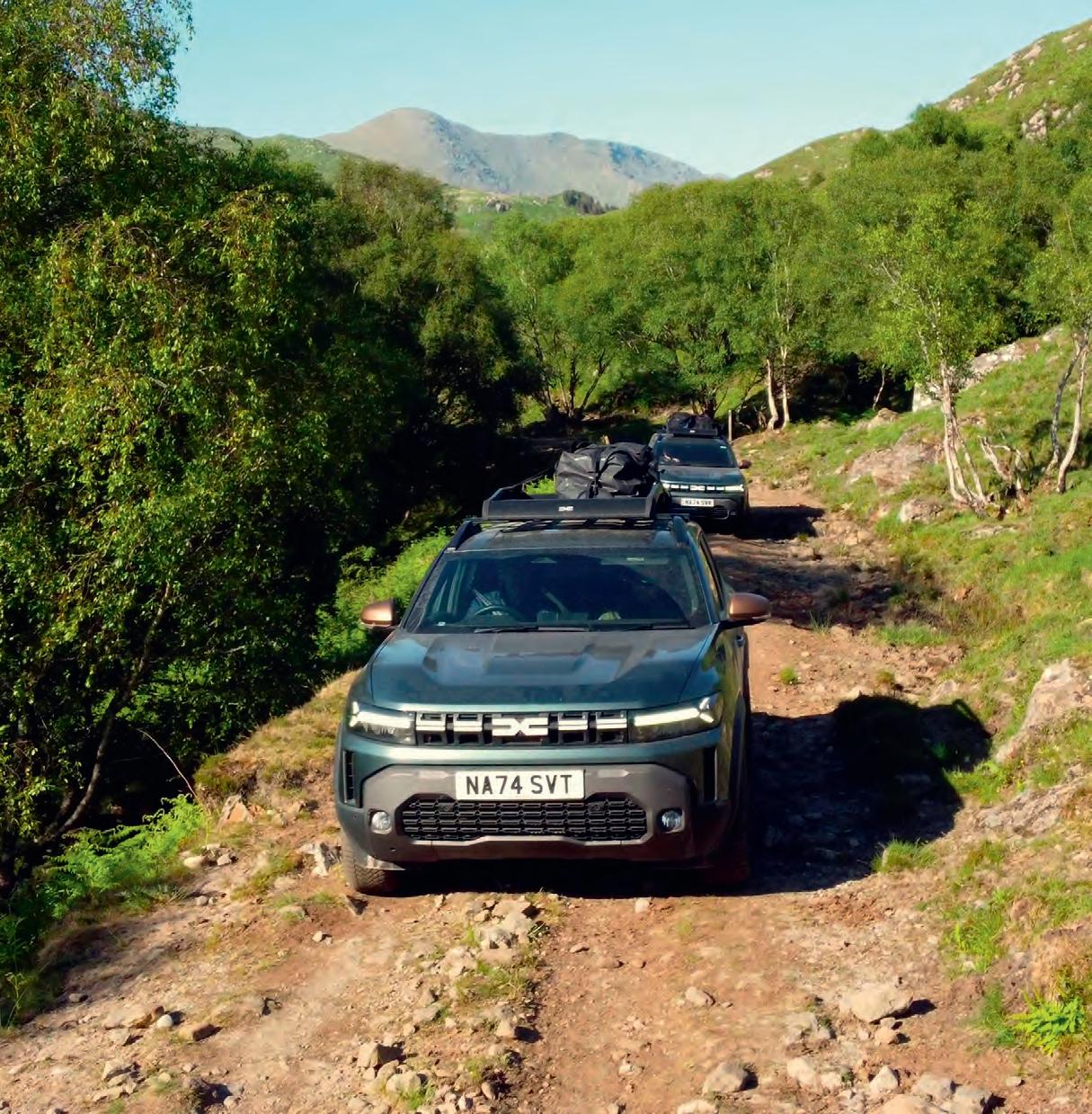

A duo of Dacia Dusters go in search of the Scottish Highlands’ hidden military history










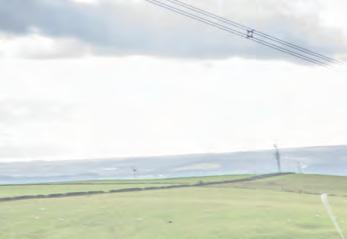



























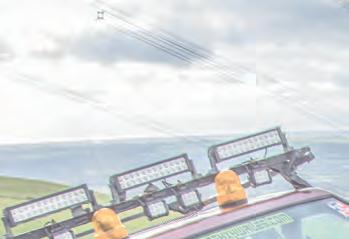




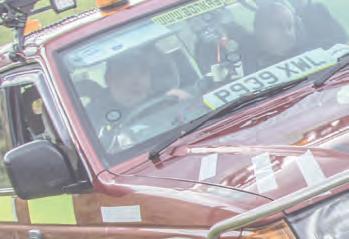
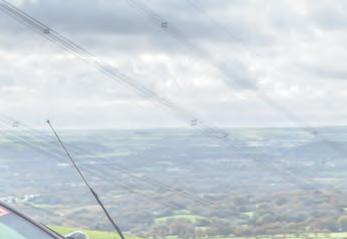






















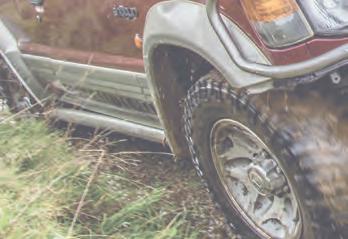







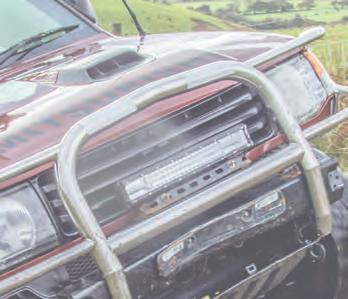





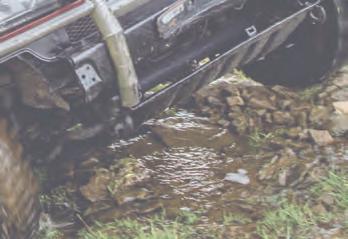








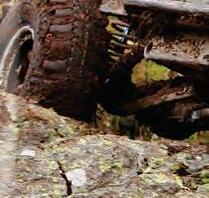










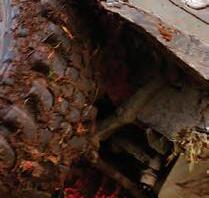







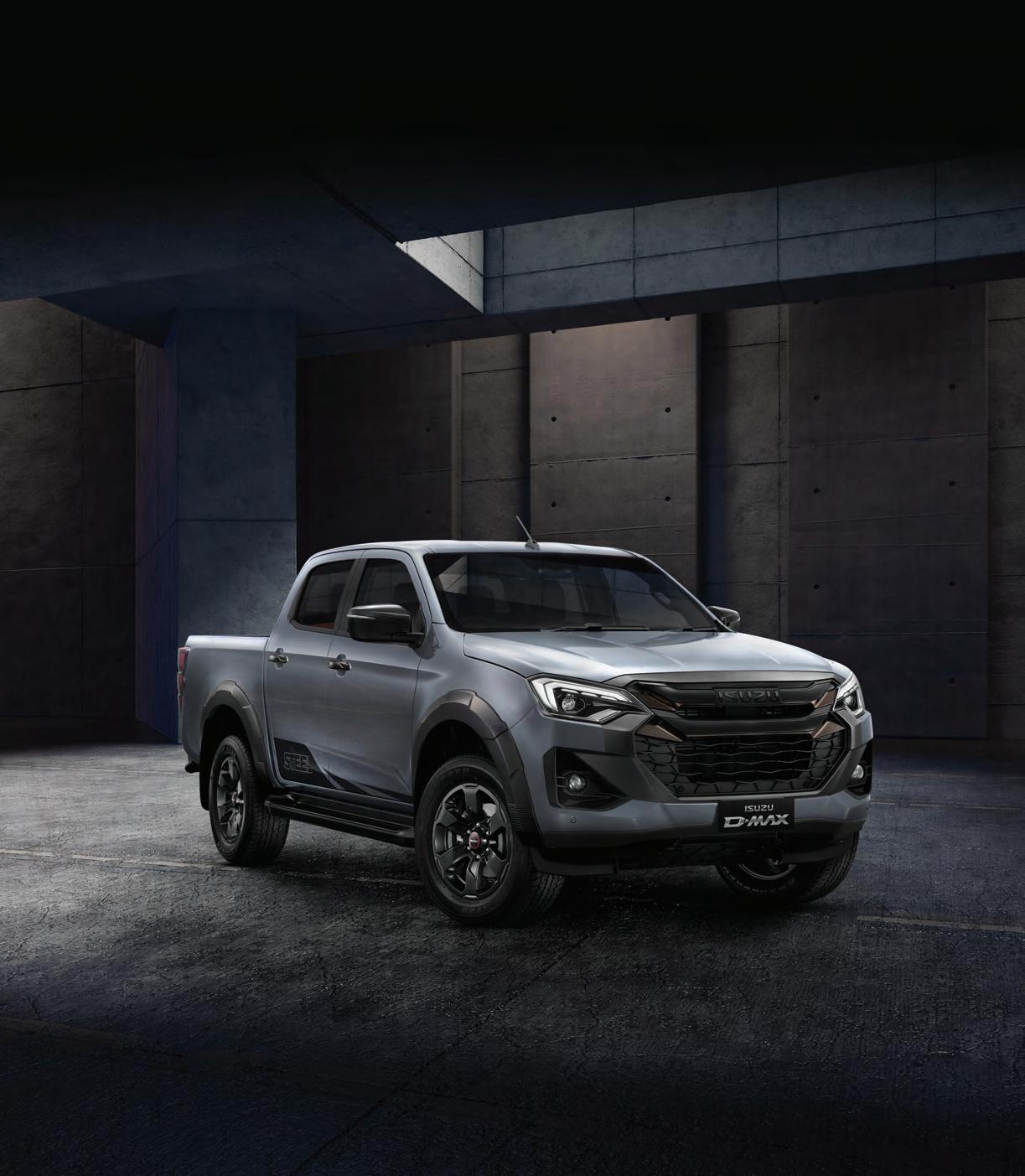
SPEC PLUS: Wheel Arch Fender Flare Kit in Dark Grey Dark Grey Rear Bumper Extensions Dark Grey Roof Rails
Heated, Electric Folding Side Mirrors with Side Indicator Repeaters
Dark Grey Isuzu Emblem for Grille

Bespoke Tailgate Assist/Damper
STEEL Branded Embossed Headrests
STEEL Vehicle Side Graphics
STEEL Branded LED Scuff Plates
STEEL Illuminated Puddle Lamps
STEEL Tailgate Badge STEEL Branded Luxury Carpet Mat Set

